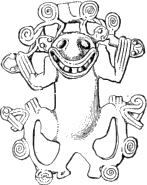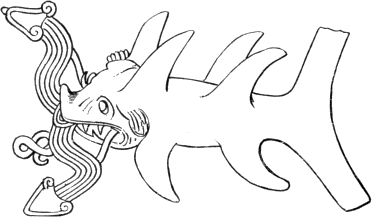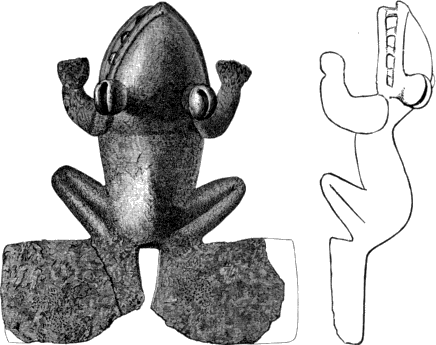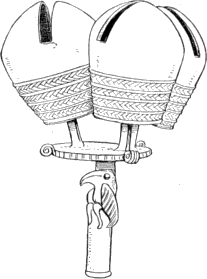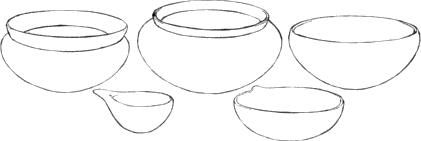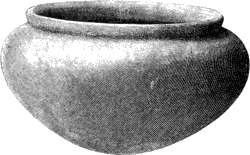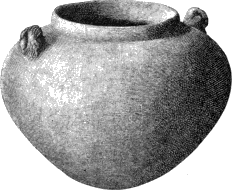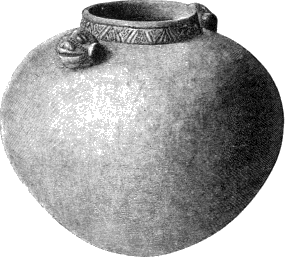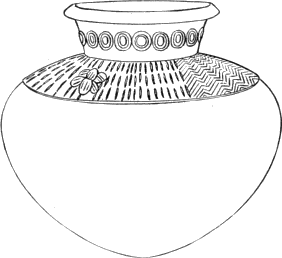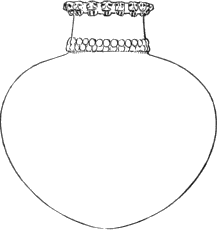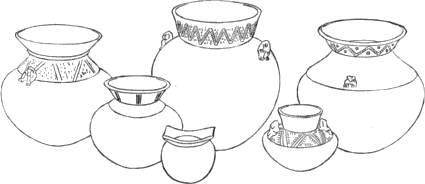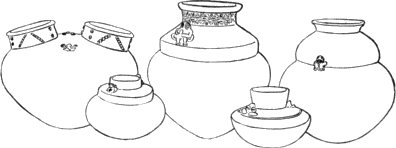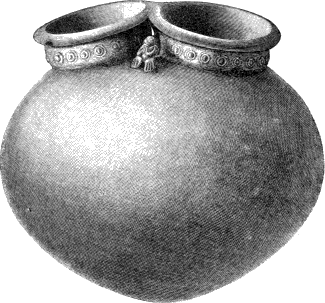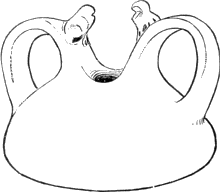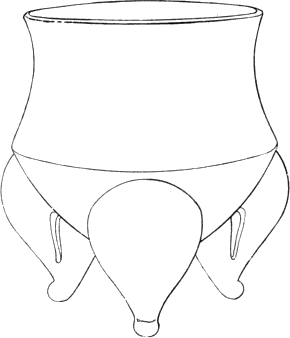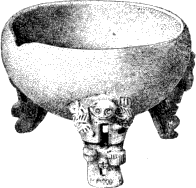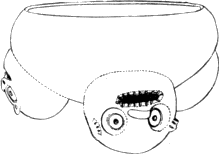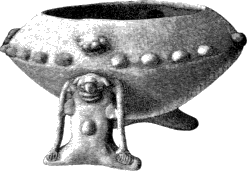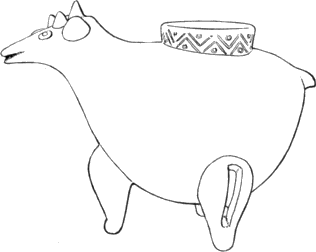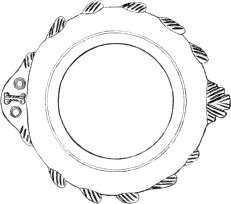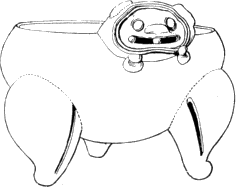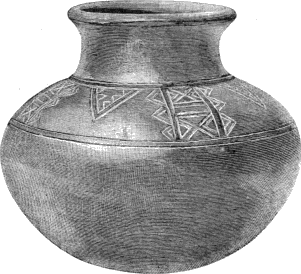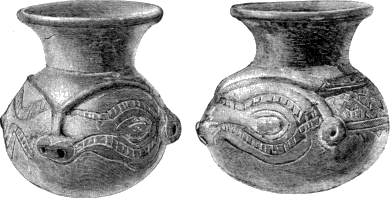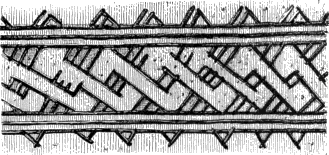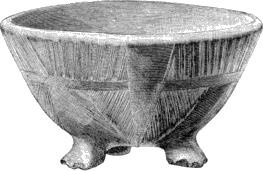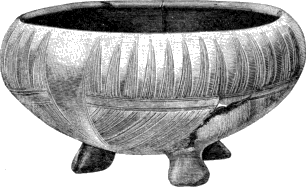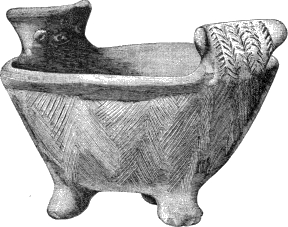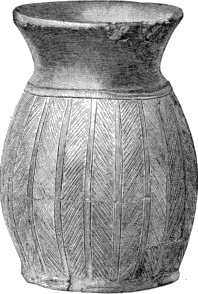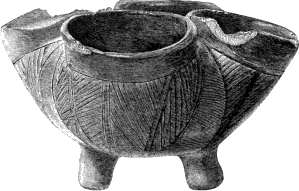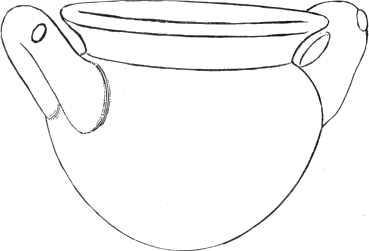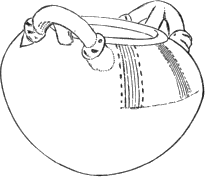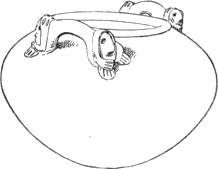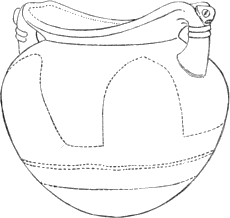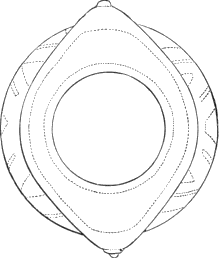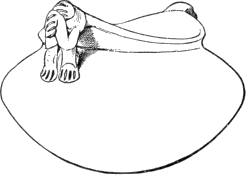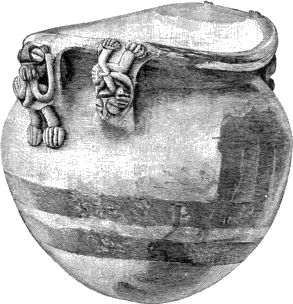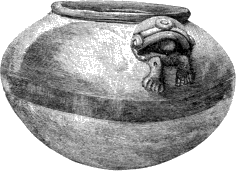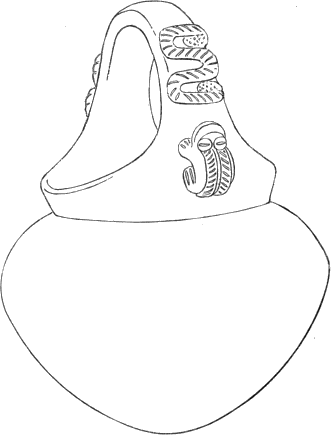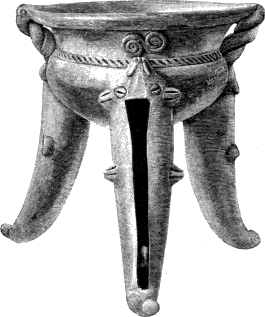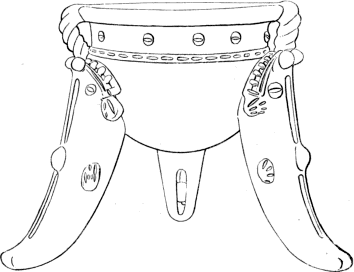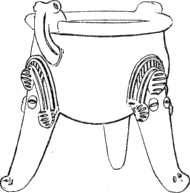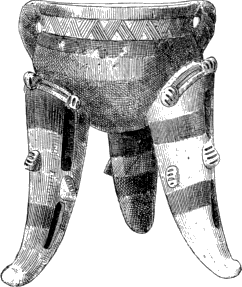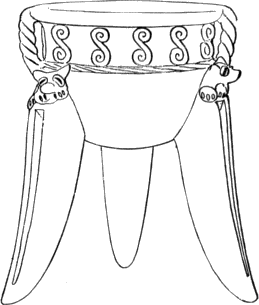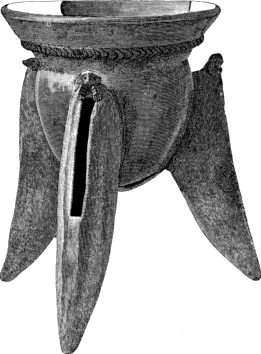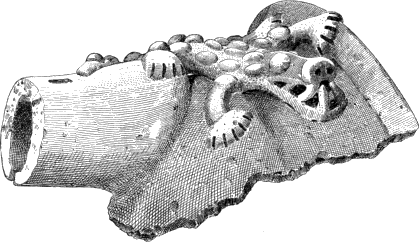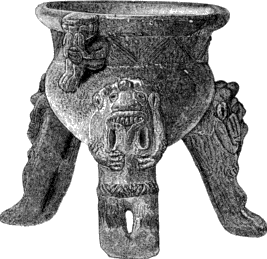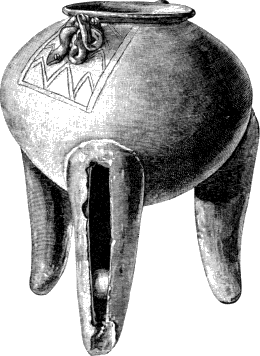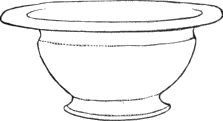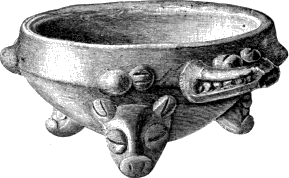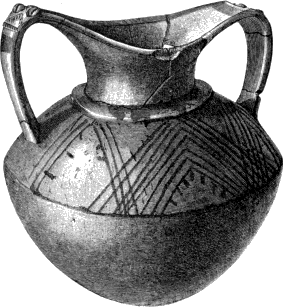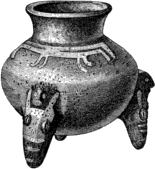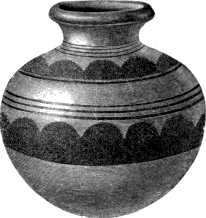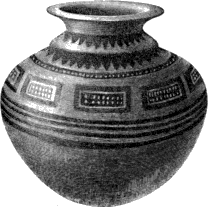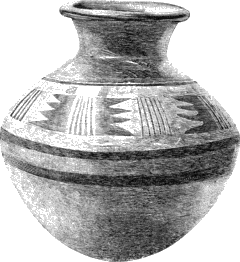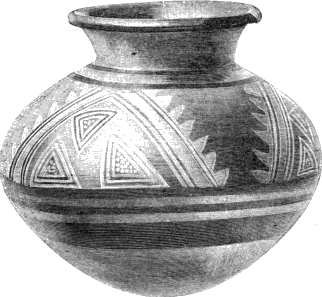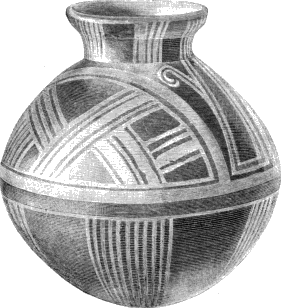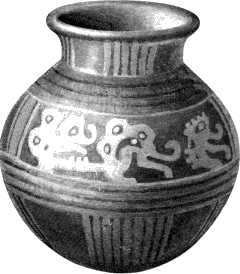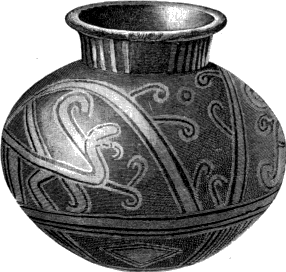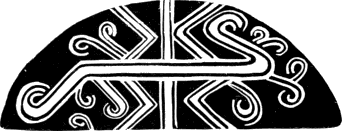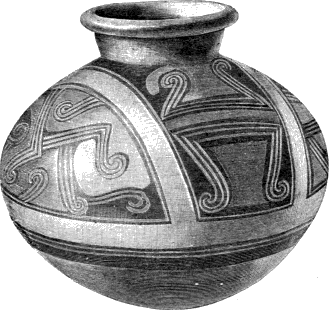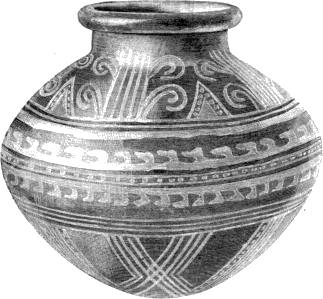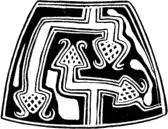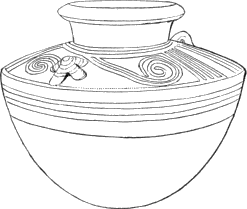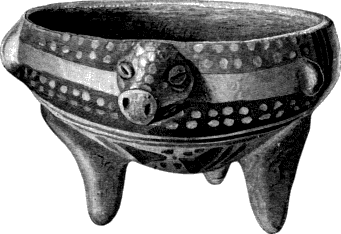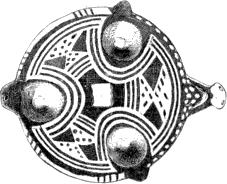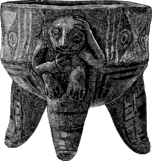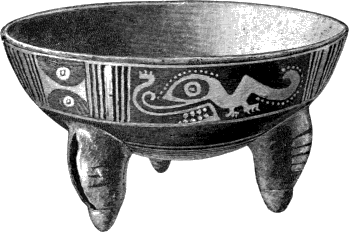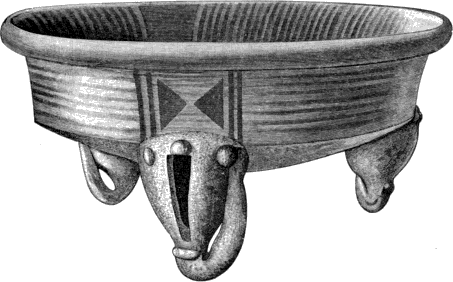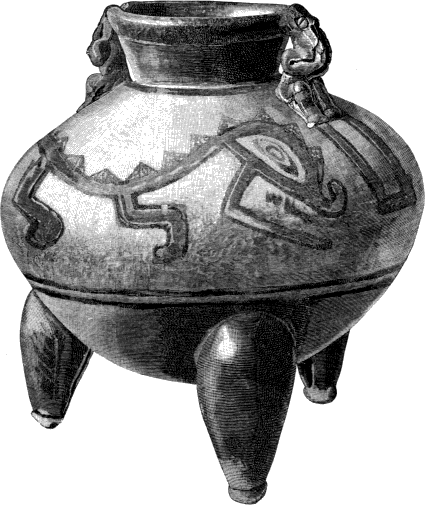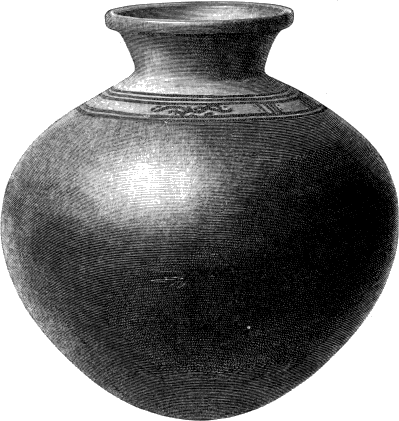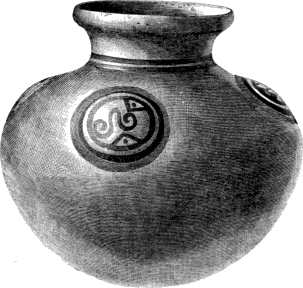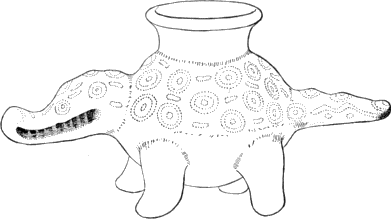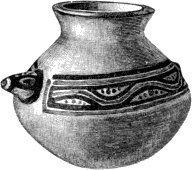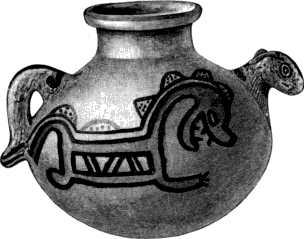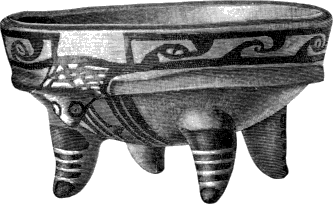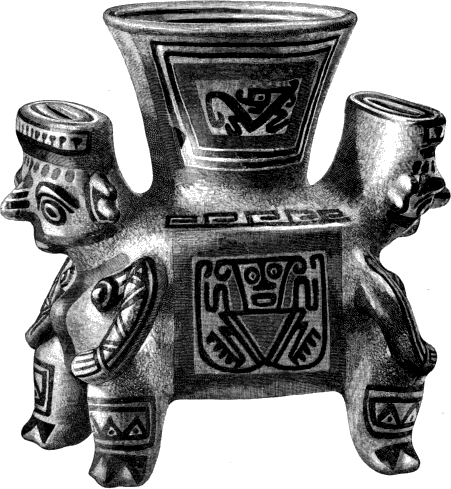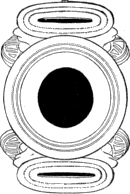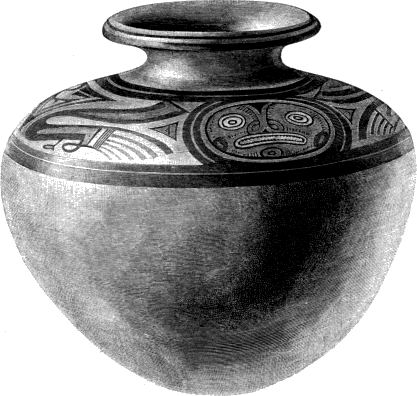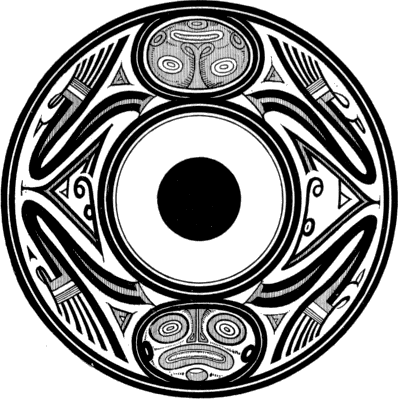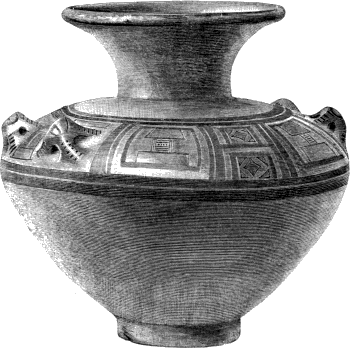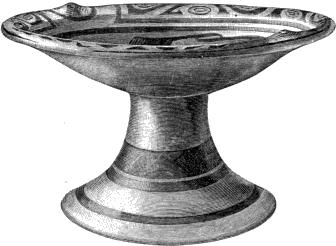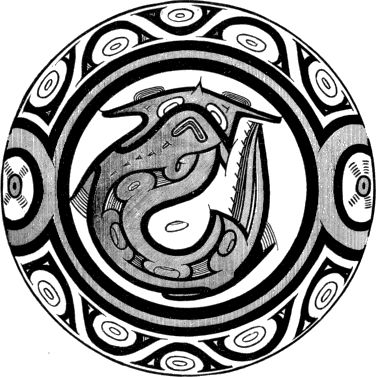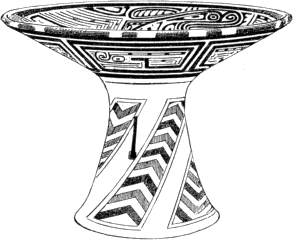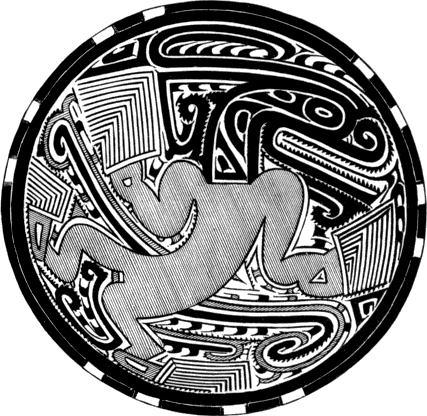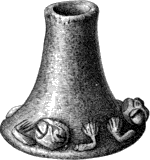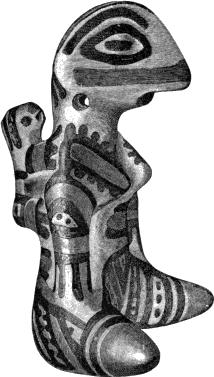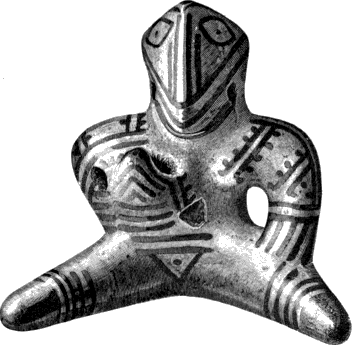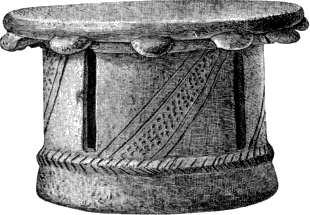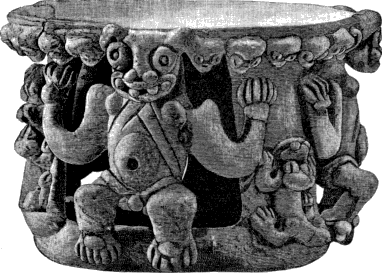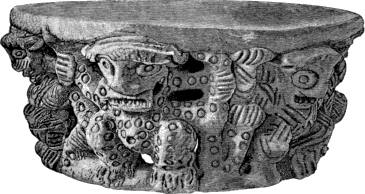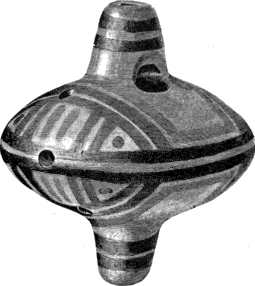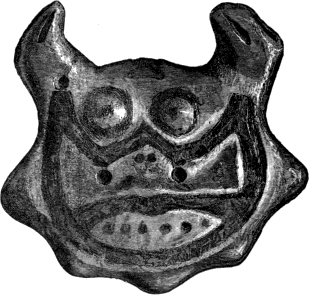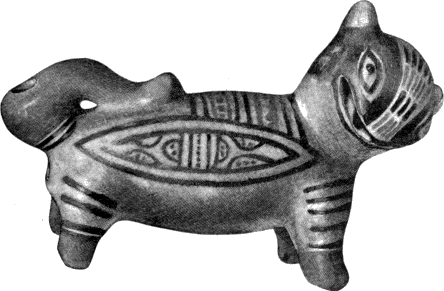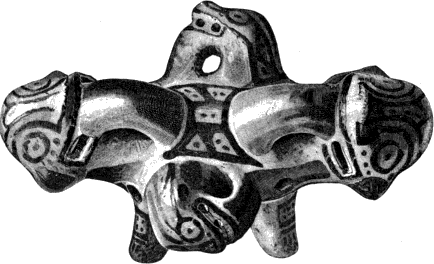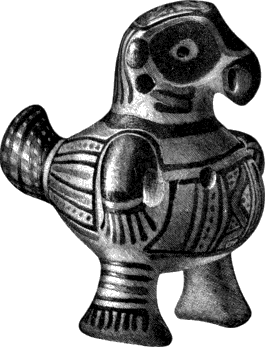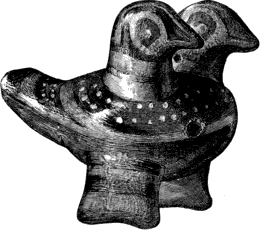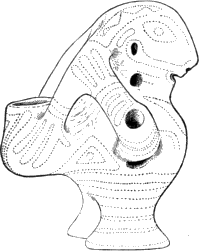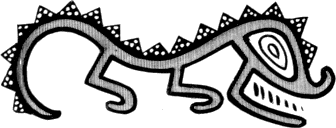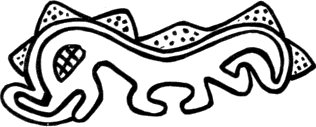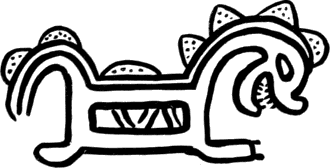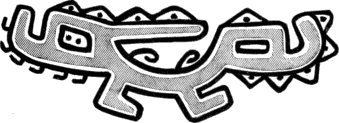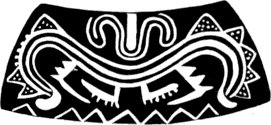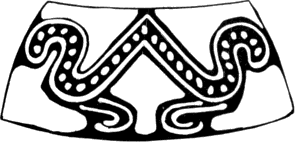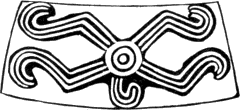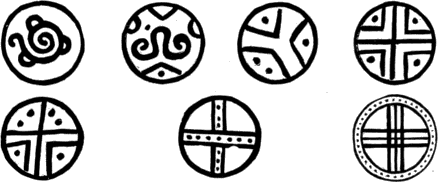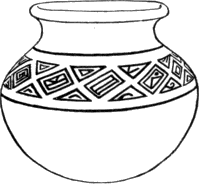.
ANCIENT ART
OF THE
PROVINCE OF CHIRIQUI, COLOMBIA.
BY
WILLIAM H. HOLMES.
CONTENTS.
Inconsistencies between the table of contents and the body text are noted at the end of the e-text.
ILLUSTRATIONS.
Links lead to the Figure itself, not its original page. Where possible, illustrations have been placed immediately before or after the paragraph that discusses them.
| Page. | |||
| Plate I. |
Map of Chiriqui |
13 | |
| Fig. | 1. |
Section of oval grave |
17 |
| 2. |
Section of a quadrangular grave |
18 | |
| 3. |
Grave with pillars |
18 | |
| 4. |
Compound cist |
19 | |
| 5. |
Southwest face of the pictured stone |
22 | |
| 6. |
A goddess of the ancient Chiriquians |
23 | |
| 7. |
A god of the ancient Chiriquians |
24 | |
| 8. |
Fragmentary human figure in gray basaltic rock |
25 | |
| 9. |
Mealing stone with large tablet ornamented with animal heads |
26 | |
| 10. |
Puma shaped metate |
27 | |
| 11. |
Stool shaped object |
28 | |
| 12. |
Stool with columnar base |
28 | |
| 13. |
Stool with perforated base |
29 | |
| 14. |
Large partially polished celt |
30 | |
| 15. |
Celt of hexagonal section |
31 | |
| 16. |
Small wide bladed celt |
31 | |
| 17. |
Celt with heavy shaft |
31 | |
| 18. |
Celt or ax with constriction near the top |
31 | |
| 19. |
Flaked and partially polished celt |
32 | |
| 20. |
Well polished celt |
32 | |
| 21. |
Narrow pointed celt |
32 | |
| 22. |
Narrow pointed celt |
32 | |
| 23. |
Cylindrical celt with narrow point |
33 | |
| 24. |
Leaf shaped objects suggesting spearpoints |
34 | |
| 25. |
Arrowpoints |
34 | |
| 26. |
Human figure, formed of copper-gold alloy |
41 | |
| 27. |
Grotesque human figure in gold |
42 | |
| 28. |
Rudely shaped human figure in gold |
42 | |
| 29. |
Grotesque human figure in nearly pure copper |
43 | |
| 30. |
Grotesque human figure in nearly pure gold |
43 | |
| 31. |
Rudely executed image of a bird in gold |
44 | |
| 32. |
Image of a bird in gold |
45 | |
| 33. |
Puma shaped figure in gold |
45 | |
| 34. |
Puma shaped figure in base metal |
45 | |
| 35. |
Quadruped with grotesque face in base metal |
46 | |
| 36. |
Figure of a fish in gold |
46 | |
| 37. |
Large figure of a frog, in base metal plated with gold |
47 | |
| 38. |
Small figure of a frog, in base metal plated with gold |
47 | |
| 39. |
Figure of an alligator in gold |
48 | |
| 40. |
Animal figure, in base metal plated with gold |
48 | |
| 41. |
Bronze bells plated or washed with gold |
50 | |
| 42. |
Bronze bell with human features |
50 | |
| 43. |
Triple bell or rattle found on the Rio Grande |
51 | |
| 8 | 44. |
Ancient Mexican bell |
51 |
| 45. |
Fundamental forms of vases—convex outlines |
58 | |
| 46. |
Fundamental forms of vases—angular outlines |
59 | |
| 47. |
Vases of complex outlines—exceptional forms |
59 | |
| 48. |
Vases of compound forms |
59 | |
| 49. |
Square lipped vessel |
59 | |
| 50. |
Variations in the forms of necks and rims |
60 | |
| 51. |
Arrangement of handles |
60 | |
| 52. |
Types of annular bases or feet |
61 | |
| 53. |
Forms of legs |
61 | |
| 54. |
Grotesque figure forming the handle of a small vase |
63 | |
| 55. |
Grotesque figure forming the handle of a small vase |
63 | |
| 56. |
Grotesque figure forming the handle of a small vase |
63 | |
| 57. |
Monstrous figure with serpent shaped extremities |
63 | |
| 58. |
Monstrous figure with serpent shaped extremities |
63 | |
| 59. |
Grotesque figure |
64 | |
| 60. |
Grotesque figure |
64 | |
| 61. |
Grotesque figure |
64 | |
| 62. |
Figure of a monkey |
64 | |
| 63. |
Figure of a monkey |
64 | |
| 64. |
Figure of a monkey |
64 | |
| 65. |
Animal forms exhibiting long proboscis |
65 | |
| 66. |
Vase illustrating ornamental use of animal figures |
65 | |
| 67. |
Vase illustrating ornamental use of animal figures |
65 | |
| 68. |
Vase illustrating ornamental use of animal figures |
66 | |
| 69. |
Vase illustrating ornamental use of animal figures |
66 | |
| 70. |
Series of bowls and cups of unpainted ware |
67 | |
| 71. |
Vase of graceful form |
68 | |
| 72. |
Vase of graceful form |
68 | |
| 73. |
Vase of fine form, ornamented with grotesque heads |
68 | |
| 74. |
Vase of fine form, ornamented with grotesque heads |
69 | |
| 75. |
Vase with ornament of applied nodes and fillets |
69 | |
| 76. |
Vase with mantle covered with incised figures |
70 | |
| 77. |
Vase with frieze of grotesque heads |
70 | |
| 78. |
Vases with flaring rims and varied ornament |
71 | |
| 79. |
Vases with complex outlines and varied ornament |
71 | |
| 80. |
Large vase with two mouths and neatly decorated necks |
72 | |
| 81. |
Large vase with high handles |
72 | |
| 82. |
Top view of high handled vase |
73 | |
| 83. |
Handled vase |
73 | |
| 84. |
Handled vase |
73 | |
| 85. |
Handled vase |
73 | |
| 86. |
Small cup with single handle, ornamented with grotesque figure |
74 | |
| 87. |
Small cup with single handle, ornamented with grotesque figure |
74 | |
| 88. |
Vase of eccentric form |
74 | |
| 89. |
Vessel illustrating forms of legs |
75 | |
| 90. |
Vessel illustrating forms of legs |
75 | |
| 91. |
Vessel with large legs, decorated with stellar punctures |
75 | |
| 92. |
Vases of varied form with plain and animal shaped legs |
75 | |
| 93. |
Large vase of striking shape |
76 | |
| 94. |
Cup with legs imitating animal forms |
76 | |
| 95. |
Cup with legs imitating a grotesque animal form |
77 | |
| 96. |
Cup with legs imitating the armadillo |
77 | |
| 9 | 97. |
Cup with legs imitating the armadillo |
77 |
| 98. |
Cup with frog shaped legs |
77 | |
| 99. |
Cup with legs imitating an animal and its young |
77 | |
| 100. |
Cups supported by grotesque heads |
77 | |
| 101. |
Large cup supported by two grotesque figures |
78 | |
| 102. |
Cup with two animal heads attached to the sides |
78 | |
| 103. |
Cup with two animal heads attached to the sides |
78 | |
| 104. |
Vase shaped to imitate an animal form |
79 | |
| 105. |
Vase shaped to imitate an animal form |
79 | |
| 106. |
Vase shaped to imitate an animal form |
79 | |
| 107. |
Fish shaped vessel |
79 | |
| 108. |
Top view of a fish shaped vessel |
80 | |
| 109. |
Cup with grotesque head attached to the rim |
80 | |
| 110. |
Black cup with incised reptilian figures |
81 | |
| 111. |
Black cup with incised reptilian figures |
81 | |
| 112. |
Black vase with conventional incised pattern |
81 | |
| 113. |
Small cup with conventional incised pattern |
82 | |
| 114. |
Small tripod cup with upright walls |
82 | |
| 115. |
Vase with flaring rim and legs imitating animal heads |
82 | |
| 116. |
Vase modeled to represent the head of an animal |
83 | |
| 117. |
Pattern upon the back of the vase |
83 | |
| 118. |
Tripod bowl of red scarified ware |
87 | |
| 119. |
Tripod bowl of red scarified ware |
87 | |
| 120. |
Oblong basin with scarified design |
88 | |
| 121. |
Large scarified bowl with handles imitating animal heads |
88 | |
| 122. |
Jar with flat bottom and vertical bands of incised ornament |
89 | |
| 123. |
Vase with stand and vertical incised bands |
89 | |
| 124. |
Vase with handles, legs, and vertical ribs |
89 | |
| 125. |
Tripod with owl-like heads at insertion of legs |
90 | |
| 126. |
Tripod with legs rudely suggesting animal forms |
90 | |
| 127. |
Heavy red vase with four mouths |
90 | |
| 128. |
Vase with horizontally placed handles and rude designs in red |
91 | |
| 129. |
Unpolished vase with heavy handles and coated with soot |
92 | |
| 130. |
Round bodied vase with unique handles and incised ornament |
92 | |
| 131. |
Vase with grotesque figures attached to the handles |
93 | |
| 132. |
Vase with upright handles and winged lip |
93 | |
| 133. |
Top view of vase with winged lip |
94 | |
| 134. |
Vase with grotesque animal shaped handles |
94 | |
| 135. |
Vase with handles representing strange animals |
95 | |
| 136. |
Vase with handles representing grotesque figures |
95 | |
| 137. |
Vase with handles representing animal heads |
96 | |
| 138. |
Vase with arched handles embellished with life forms in high relief |
96 | |
| 139. |
Vase with arched handles embellished with life forms in high relief |
97 | |
| 140. |
Tripod vase with shallow basin and eccentric handles |
99 | |
| 141. |
Tripod vase with shallow basin and eccentric handles |
99 | |
| 142. |
Tripod vase with shallow basin and eccentric handles |
99 | |
| 143. |
Tripod vase of graceful shape and neat finish |
100 | |
| 144. |
Heavy tripod vase with widely spreading feet |
100 | |
| 145. |
Neatly modeled vase embellished with life forms and devices in red |
101 | |
| 146. |
High tripod vase with incised designs and rude figures in red |
101 | |
| 147. |
Handsome tripod vase with scroll ornament |
102 | |
| 148. |
Vase with lizard shaped legs |
102 | |
| 149. |
Vase with scroll ornament |
103 | |
| 10 | 150. |
Large vase with flaring rim and widespreading legs |
103 |
| 151. |
Fragment of a tripod vase embellished with figure of an alligator |
104 | |
| 152. |
Vase supported by grotesque human figures |
105 | |
| 153. |
Round bodied vase embellished with figures of monsters |
106 | |
| 154. |
Cup with incurved rim and life form ornamentation |
107 | |
| 155. |
Cup with widely expanded rim and constricted neck |
107 | |
| 156. |
Small tripod cup with animal features in high relief |
108 | |
| 157. |
Handsome vase supported by three grotesque figures |
108 | |
| 158. |
Vase decorated with figures of frogs and devices in red |
110 | |
| 159. |
Vase of unique shape and life form ornamentation |
110 | |
| 160. |
Two-handled vase with life form and linear decoration |
110 | |
| 161. |
Small tripod vase with animal figures in white |
111 | |
| 162. |
Shapely vase with designs in white paint |
112 | |
| 163. |
Small red bottle with horizontal bands of ornament |
115 | |
| 164. |
Small red bottle with encircling geometric devices |
115 | |
| 165. |
Bottle with zone occupied by geometric devices |
116 | |
| 166. |
Bottle with broad zone containing geometric figures |
116 | |
| 167. |
Bottle with decoration of meandered lines |
117 | |
| 168. |
Bottle with arched panels and geometric devices |
117 | |
| 169. |
Bottle with arched panels and elaborate devices |
118 | |
| 170. |
Vase with rosette-like panels |
118 | |
| 170a. |
Ornament from preceding vase |
118 | |
| 171. |
Vase with rosette-like panels |
119 | |
| 172. |
Vase with rosette-like panels |
119 | |
| 173. |
Theoretical origin of the arched panels |
120 | |
| 174. |
Theoretical origin of the arched panels |
120 | |
| 175. |
Theoretical origin of the arched panels |
120 | |
| 176. |
Vase decorated with conventional figures of alligators |
120 | |
| 177. |
Portion of decorated zone illustrating treatment of life forms |
121 | |
| 178. |
Portion of decorated zone illustrating treatment of life forms |
121 | |
| 179. |
Vase decorated with highly conventional life forms |
121 | |
| 179a. |
Design from preceding vase |
122 | |
| 180. |
Vase decorated with highly conventional life forms |
122 | |
| 181. |
Vase decorated with highly conventional life forms |
123 | |
| 182. |
Decorated panel with devices resembling vegetal growths |
124 | |
| 183. |
Vase of unusual shape |
124 | |
| 184. |
Vase of unusual shape |
124 | |
| 185. |
Vase of unusual shape |
124 | |
| 186. |
Double vessel with high arched handle |
125 | |
| 187. |
Double vessel with arched handle |
125 | |
| 188. |
Vase embellished with life forms in color and in relief |
126 | |
| 189. |
Vase modeled to represent a peccary |
127 | |
| 190. |
Under surface of peccary vase |
127 | |
| 191. |
Small vessel with human figures in high relief |
127 | |
| 192. |
Tripod cup with figures of the alligator |
128 | |
| 193. |
Large shallow tripod vase with geometric decoration |
129 | |
| 194. |
Large bottle shaped vase with high tripod and alligator design |
130 | |
| 195. |
Large bottle with narrow zone containing figures of the alligator |
132 | |
| 196. |
Vase with decorated zone containing four arched panels |
133 | |
| 197. |
Vase with four round nodes upon which are painted animal devices |
133 | |
| 198. |
Vases of varied form and decoration |
134 | |
| 199. |
Alligator vase with conventional markings |
135 | |
| 200. |
Alligator vase with figures of the alligator painted on the sides |
135 | |
| 11 | 201. |
Vase with serpent ornamentation |
136 |
| 202. |
Vase representing a puma with alligator figures painted on sides |
137 | |
| 203. |
Shallow vase with reptilian features in relief and in color |
137 | |
| 204. |
Vase with funnel shaped mouth |
138 | |
| 205. |
Top view of vase in Fig. 204 |
139 | |
| 206. |
End view of vase in Fig. 204 |
139 | |
| 207. |
Large vase with decorations in red and black |
140 | |
| 208. |
Devices of the decorated zone of vase in Fig. 207, viewed from above |
141 | |
| 209. |
Handsome vase with four handles and decorations in black, red, and purple |
142 | |
| 210. |
Painted design of vase in Fig. 209, viewed from above |
143 | |
| 211. |
Vase of unusual shape with decoration in black, red, and purple |
144 | |
| 212. |
Ornament occupying the interior surface of the basin of vase in Fig. 211 |
144 | |
| 213. |
Large vase of fine shape and simple decorations |
145 | |
| 214. |
Vase with extraordinary decorative designs |
146 | |
| 215. |
Painted design of vase in Fig. 214, viewed from above |
147 | |
| 216. |
Vase of unique form and decoration |
148 | |
| 217. |
Painted design of vase in Fig. 216 |
148 | |
| 218. |
Spindle whorl with annular nodes |
149 | |
| 219. |
Spindle whorl decorated with animal figures |
149 | |
| 220. |
Spindle whorl with perforations and incised ornament |
149 | |
| 221. |
Needlecase |
150 | |
| 222. |
Needlecase |
150 | |
| 223. |
Needlecase with painted geometric ornament |
151 | |
| 224. |
Needlecase with incised geometric ornament |
151 | |
| 225. |
Needlecase with incised geometric ornament |
151 | |
| 226. |
Statuette |
152 | |
| 227. |
Statuette |
152 | |
| 228. |
Statuette |
152 | |
| 229. |
Statuette |
152 | |
| 230. |
Stool of plain terra cotta |
154 | |
| 281. |
Stool of plain clay, with grotesque figures |
155 | |
| 232. |
Stool of plain terra cotta |
155 | |
| 233. |
Rattle |
157 | |
| 234. |
Section of rattle |
157 | |
| 235. |
Rattle, with grotesque figures |
157 | |
| 236. |
Drum of gray unpainted clay |
158 | |
| 237. |
Drum with painted ornament |
159 | |
| 238. |
Painted design of drum in Fig. 237 |
159 | |
| 239. |
Double whistle |
161 | |
| 240. |
Section of double whistle |
161 | |
| 241. |
Tubular instrument with two finger holes |
162 | |
| 242. |
Section of whistle |
162 | |
| 243. |
Small animal shaped whistle |
162 | |
| 244. |
Small animal shaped whistle |
162 | |
| 245. |
Top shaped whistle |
163 | |
| 246. |
Section, top, and bottom views of whistle |
164 | |
| 247. |
Drum shaped whistle |
165 | |
| 248. |
Vase shaped whistle |
165 | |
| 249. |
Crab shaped whistle |
166 | |
| 250. |
Alligator shaped whistle |
166 | |
| 251. |
Cat shaped whistle |
167 | |
| 252. |
Whistle with four ocelot-like heads |
168 | |
| 253. |
Bird shaped whistle |
169 | |
| 12 | 254. |
Bird shaped whistle |
169 |
| 255. |
Bird shaped whistle |
170 | |
| 256. |
Whistle in grotesque life form |
170 | |
| 257. |
Conventional figure of the alligator |
173 | |
| 258. |
Conventional figure of the alligator |
173 | |
| 259. |
Conventional figure of the alligator |
174 | |
| 260. |
Conventional figure of the alligator |
174 | |
| 261. |
Conventional figure of the alligator |
174 | |
| 262. |
Conventional figure of the alligator |
175 | |
| 263. |
Conventional figure of the alligator |
175 | |
| 264. |
Conventional figure of the alligator |
176 | |
| 265. |
Conventional figure derived from the alligator |
176 | |
| 266. |
Conventional figure derived from the alligator |
176 | |
| 267. |
Conventional figure derived from the alligator |
176 | |
| 268. |
Conventional figure derived from the alligator |
177 | |
| 269. |
Conventional figure derived from the alligator |
177 | |
| 270. |
Conventional figure derived from the alligator |
177 | |
| 271. |
Conventional figure derived from the alligator |
178 | |
| 272. |
Conventional figure derived from the alligator |
178 | |
| 273. |
Conventional figure derived from the alligator |
178 | |
| 274. |
Conventional figures derived from the alligator |
179 | |
| 275. |
Conventional figure derived from the alligator |
179 | |
| 276. |
Conventional figure derived from the alligator |
180 | |
| 277. |
Conventional figures derived from the alligator |
180 | |
| 278. |
Conventional figures derived from the alligator |
181 | |
| 279. |
Conventional figures derived from the alligator |
182 | |
| 280. |
Conventional figures derived from the alligator |
182 | |
| 281. |
Conventional figures derived from the alligator |
182 | |
| 282. |
Conventional figures derived from the alligator |
182 | |
| 283. |
Conventional figures derived from the alligator |
183 | |
| 284. |
Vase with decorated zone containing remarkable devices |
185 | |
| 285. |
Series of devices |
185 | |
ANCIENT ART OF THE PROVINCE OF CHIRIQUI.
By William H. Holmes.
INTRODUCTION.
GEOGRAPHY.
Until comparatively recent times the province of Chiriqui has remained almost unknown to the world at large. The isthmus was traversed a number of times by the conquerors, who published accounts of their discoveries, but it was reserved for the period of railroad and canal exploration to furnish trustworthy accounts of its character and inhabitants. The situation of Chiriqui is unique. Forming, politically, a part of South America, it belongs in reality to the North American continent. It occupies a part of the great southern flexure of the isthmus at a point where the shore lines begin finally to turn toward the north.
The map accompanying this paper (Plate I) conveys a clear idea of the position and the leading topographic features of the province. The boundaries separating it from Veragua on the east and Costa Rica on the west run nearly north and south. The Atlantic coast line has a northwest and southeast trend and is indented by the bay or lagoon of Chiriqui. The Bay of David extends into the land on the south and the Gulf of Dolce forms a part of the western boundary. A range of mountains, consisting principally of volcanic products, extends midway along the province, forming the continental watershed.1 The drainage comprises two systems of short rivers that run, one to the north and the other to the south, into the opposing oceans. Belts of lowland border the shore lines. That on the south side is from twenty to thirty miles wide and rises gradually into a plateau two or three thousand feet in elevation, which is broken by hills and cut by cañons. This belt affords a natural thoroughfare for peoples migrating from continent to continent, and doubtless formed at all periods an attractive district for occupation. It is in the middle portion of this strip of lowland, especially in the drainage area of the Bay of David, that the most plentiful evidences of ancient occupation are found. Scattering remains have been discovered all along, however, connecting the art of Costa Rica with that of Veragua, Panama, and 14 the South American continent. The islands of the coast furnish some fragmentary monuments and relics, and there is no doubt that a vast quantity of material yet remains within the province to reward the diligent search of future explorers.
LITERATURE.
The antiquarian literature of the province is extremely meager, being confined to brief sketches made by transient visitors or based for the most part upon the testimony of gold hunters and government explorers, who took but little note of the unpretentious relics of past ages. As there are few striking monuments, the attention of archæologists was not called to the history of primeval man in this region, and until recently the isthmus was supposed to have remained practically unoccupied by that group of cultured nations whose works in Peru and in Mexico excite the wonder of the world. But, little by little, it has been discovered that at some period of the past the province was thickly populated, and by races possessed of no mean culture.
The most important contributions to the literature of this region, so far as they have come to my knowledge, are the following: A paper by Mr. Merritt, published by the American Ethnological Society;2 a paper by Bollaert, published by the same society, and also a volume issued in London;3 a valuable pamphlet, with photographic illustrations, by M. De Zeltner, French consul to Panama in 1860;4 a short paper by Mr. A. L. Pinart, published in the Bulletin de la Société de Géographie (Paris, 1885, p. 433), in which he gives valuable information in regard to the peoples, ancient and modern; and casual notes by a number of other writers, some of which will be referred to in the following pages. A pretty full list of authorities is given by Mr. H. H. Bancroft in his Native Races, Vol. V, p. 16.
One of the most important additions to our knowledge of the province and its archæologic treasures is furnished in the manuscript notes of Mr. J. A. McNiel, who made the greater part of the collection now deposited in the National Museum. This explorer has personally supervised the examination of many thousands of graves and has forwarded the bulk of his collections to the United States. His explorations have occupied a number of years, during which time he has undergone much privation and displayed great enthusiasm in pursuing the rather thorny pathways of scientific research. In the preparation of this paper his notes have been used as freely as their rather disconnected character warranted, and since Mr. McNiel’s return to the United States, in July, 1886, I have been favored with a 15 series of interviews with him, and by this means much important information has been obtained.
PEOPLE.
At the present time this district is inhabited chiefly by Indians and natives of mixed, blood, who follow grazing and agriculture to a limited extent, but subsist largely upon the natural products of the country. These peoples are generally thought to have no knowledge or trustworthy tradition of the ancient inhabitants and are said to care nothing for the curious cemeteries among which they dwell, except as a source of revenue. Mr. A. L. Pinart states, however, that certain tribes on both sides of the continental divide have traditions pointing toward the ancient grave builders as their ancestors. There is probably no valid reason for assigning the remains of this region to a very high antiquity. The highest stage of culture here may have been either earlier or later than the period of highest civilization in Mexico and South America or contemporaneous with it. There is really no reason for supposing that the tribes who built these graves were not in possession of the country, or parts of it, at the time of the conquest. As to the affinities of the ancient middle isthmian tribes with the peoples north and south of them we can learn nothing positive from the evidences of their art. So far as the art of pottery has come within my observation, it appears to indicate a somewhat closer relationship with the ancient Costa Rican peoples than with those of continental South America; yet, in their burial customs, in the lack of enduring houses and temples, and in their use of gold, they were like the ancient peoples of middle and southern New Granada.5
The relics preserved in our museums would seem to indicate one principal period of occupation or culture only; but there has been no intelligent study of the contents of the soil in sections exposed in modern excavations, the exclusive aim of collectors having generally been to secure either gold or showy cabinet specimens. The relics of very primitive periods, if such are represented, have naturally passed unnoticed. Mr. McNiel mentions the occurrence of pottery in the soil in which the graves were dug, but, regarding it as identical with that contained in the graves, he neglected to preserve specimens.
In one instance, while on a visit to Los Remedios, a pueblo near the eastern frontier of Chiriqui, he observed a cultivated field about which a ditch some 8 or 9 feet in depth had been dug. In walking through this he found a continuous exposure of broken pottery and stone implements. Some large urns had been cut across or broken to conform to the slope of the ditch, and were exposed in section.
16Although not apparently representing a very wide range of culture or distinctly separated periods of culture, the various groups of relics exhibit considerable diversity in conception and execution, attributable, no doubt, to variations in race and art inheritance.
THE CEMETERIES.
The ancient cemeteries, or huacals, as they are called throughout Spanish America, are scattered over the greater part of the Pacific slope of Chiriqui. It is said by some that they are rarely found in the immediate vicinity of the sea, but they occur in the river valleys, on the hills, the plateaus, the mountains, and in the deepest forests. They are very numerous, but generally of small extent. The largest described is said to cover an area of about twelve acres. They were probably located in the immediate vicinity of villages, traces of which, however, are not described by explorers; but there can be no doubt that diligent search will bring to light the sites of dwellings and towns. The absence of traces of houses or monuments indicates either that the architecture of this region was then, as now, of destructible material, or, which is not likely, that so many ages have passed over them that all traces of unburied art, wood, stone, or clay, have yielded to the “gnawing tooth of time.”
One of the most circumstantial accounts of these burial places is given by Mr. Merritt, who was also the first to make them known to science.6 Mr. Merritt was director of a gold mine in Veragua, and in the summer of 1859 spent several weeks in exploring the graves of Chiriqui; he therefore speaks from personal knowledge. In the autumn of 1858 two native farmers of the parish of Bugaba, or Bugava, discovered a golden image that had been exposed by the uprooting of a plant. They proceeded secretly to explore the graves, the existence of which had been known for years. In the following spring their operations became known to the people, and within a month more than a thousand persons were engaged in working these extraordinary gold mines. The fortunate discoverers succeeded in collecting about one hundred and thirty pounds weight of gold figures, most of which were more or less alloyed with copper. It is estimated that fifty thousand dollars’ worth in all was collected from this cemetery, which embraced an area of twelve acres.
Although there are rarely surface indications to mark the position of the graves, long experience has rendered it comparatively easy to discover them. The grave hunter carries a light iron rod, which he runs into the ground, and thus, if any hard substance is present, discovers the existence of a burial. It is mentioned by one or two writers that the graves are in many cases marked by stones, either loose or set in the ground in rectangular and circular arrangements. The 17 graves do not often seem to have had a uniform position in relation to one another or to the points of the compass. In some cases they are clustered about a central tomb, and then assume a somewhat radiate arrangement; again, according to Mr. McNiel, they are sometimes placed end to end, occupying long trenches.
THE GRAVES.
Graves of a particular form are said to occur sometimes in groups occupying distinct parts of the cemetery, but the observations are not sufficiently definite to be of value. The graves vary considerably in form, construction, and depth, and are classified variously by explorers. In the Bugaba cemetery Mr. Merritt found two well marked varieties, the oval and the quadrangular, reference being had to the horizontal section. The oval grave pits were from 4½ to 6 feet deep and from 3 to 4 feet in greatest diameter. A wall of rounded river stones 2½ to 3 feet high lined the lower part of the pit, and from the top of this the entire space was closely packed with rounded stones. Within the faced up part of this cist the remains of the dead, the golden figures, pottery, and implements had been deposited. This form is illustrated in Fig. 1 by a vertical section constructed from the description given by Mr. Merritt.
Fig. 1. Section of oval grave.
The quadrangular graves were constructed in two somewhat distinct ways. One variety was identical in most respects with the oval form illustrated above. They were sometimes as much as 6 feet deep and frequently 4 by 7 feet in horizontal dimensions. In the other form a pit 4 by 6½ feet in diameter was sunk to the depth of about 3 feet. Underneath this another pit some 2 feet in depth was sunk, leaving an offset or terrace 8 or 10 inches in width all around. The smaller pit was lined with flat stones placed on edge. In this cist the human remains and the relics were placed and covered over with flat stones, which rested upon the terrace and prevented the superincumbent mass, which consisted of closely packed river stones, from 18 crushing the contents. A section of this tomb is given in Fig. 2, also drawn from the description given by Mr. Merritt.
Fig. 2. Section of a quadrangular grave, showing the surface pack of river stories and the positions of the slabs and objects of art.
Mr. Merritt and others mention that in some of the graves pillars are employed to support the roof of the cist. These pillars are mentioned briefly by De Zeltner, from whose account the following illustrations are drawn. This author does not state that he made any personal investigations, and if his accounts were obtained from the natives their entire trustworthiness may very properly be questioned. The first two forms mentioned by him are similar to those already given. The third is described as having at the corners square pillars of stone to support the covering, which, however, is not described. The fourth has four pillars, placed in the corners of the pit. These serve to support a vault of flagstones. The walls between the pillars are faced with pebbles, as in the cases previously described. Fig. 3 will make this form clear at a glance. The fifth variety described by De Zeltner is quite extraordinary in construction. His account is somewhat confusing in a number of respects, and the section given in Fig. 4 cannot claim more than approximate accuracy in details and measurements. Near the surface a paving, perhaps 19 of river stones, was found covering an area of about 10 by 13 feet. This paving was apparently the surface of a pack about 2 feet thick, and covered the mouth of the main pit, which was some 6 or 7 feet deep. Pillars of cobble stones about 10 inches in diameter occupied the corners of the pit, and probably served in a measure to support the paving. In the bottom of this excavation a second pit was dug, the mouth of which was also covered by a paving 2½ by upwards of 3 feet in horizontal dimensions. This lower pit consisted of a shaft several feet in depth, by which descent was made into a chamber of inverted pyramidal shape. This chamber approximated 6 by 9 feet in horizontal dimensions and was some 4 or 5 feet deep. At the bottom of this cistern the human remains and most of the relics were deposited. The shaft was filled in with earth and the pavings described. The total depth, computed from the figures given, is about 18 feet, a most remarkable achievement for a barbarous people; yet this is equaled by the ancient tribes of the mainland of New Granada, where similar burial customs seem to have prevailed. Mr. White,7 who traveled extensively in the northwestern part of the state, says:
A dry, elevated ridge, composed of easily excavated material, was selected as the cemetery. A pit of only a yard or so in diameter was sunk, sometimes vertically, sometimes at an angle, or sometimes it varied from vertical to inclined. It was sunk to depths varying from 15 to 60 feet, and at the bottom a chamber was formed in the earth. Here the dead was deposited, with his arms, tools, cooking utensils, ornaments, and chattels generally, with maize and fermented liquor made of maize. The chamber and passage were then rammed tightly full of earth, and sometimes it would appear that peculiar earth, other than that excavated on the spot, was used. One not unfrequently detects a peculiar aromatic smell in the earth, and fragments of charcoal are always found mixed with it in more or less quantity.
 |
 |
| Fig. 3. Grave with pillars, described by De Zeltner. | Fig. 4. Compound cist, described by De Zeltner. |
M. De Zeltner describes other very simple graves which are filled in with earth, excepting a surface paving of pebbles.
Mr. McNiel, who has examined more examples than any other white man, and over a wide district with David as a center, discredits the statements of De Zeltner in respect to the form illustrated in Fig. 4, and states that generally the graves do not differ greatly in shape and finish from the ordinary graves of to-day. He describes the pits as being oval and quadrangular and as having a depth ranging from a few feet to 18 feet. The paving or pack consists of earth and water worn stones, the latter pitched in without order and forming but a small percentage of the filling. He has never seen such stones used in facing the walls of the pit or in the construction of pillars. The flat stones which cover the cist are often 10 or 15 feet below the surface and are in some cases very heavy, weighing 300 pounds or more. A single stone is in cases large enough to cover the entire space, but more frequently two or more flat stones are laid side by side across the cavity. These are supported by river stones, a foot or more in length, set around the margin of the cist. He is of the opinion that both slabs and bowlders were in many cases carried long distances. No one of the pits examined was of the extraordinary form described in detail by De Zeltner and others.
HUMAN REMAINS.
The almost total absence of human remains has frequently been remarked, and the theory is advanced that cremation must have been practiced. We have no evidence, however, of such a custom among the historic tribes of this region, and, besides, such elaborate tombs would hardly be constructed for the deposition of ashes. Yet, considering the depth of the graves, their remarkable construction, and the character of the soil selected for burial purposes, it is certainly wonderful that such meager traces of human remains are found. Pinart surmises, from the analogies of modern burial customs upon the north coast, that the bones only were deposited in the graves, the flesh having been allowed to decay by a long period of exposure in the open air. This, however, would probably not materially hasten the decay of the bones.
Mr. Merritt states that human hair was obtained from graves at Bugaba, and that he has himself secured the enamel of a molar tooth from that locality. De Zeltner tells us that in three varieties of graves remains of skeletons are found, always, however, in a very fragile condition. One skull was obtained of sufficient stability to be cast in plaster, but De Zeltner is not certain that it belonged to the people who built the tombs.
Mr. McNiel reports the occasional finding of bones, and a number of bundles of them are included in his collection. He reports that there are no crania and that nothing could be determined as to the position of the bodies when first buried.
21Pinart observes that in some cases the bodies or remnants of bodies were distributed about the margin of the pit bottom, with the various utensils in the center, and again that the remains were laid away in niches dug in the sides of the main pit.
These scattering observations will serve to give a general idea of the modes of sepulture practiced in this region, but there must be a closer record of localities and a careful correlation of the varying phenomena of inhumation before either ethnology or archaeology can be greatly benefited.
PLACING OF RELICS.
The pieces of pottery, implements, and ornaments were probably buried with the dead, pretty much as are similar objects in other parts of America. The almost total disappearance of the human remains makes a determination of exact relative positions impossible. The universal testimony, however, is that all were not placed with the body, but that some were added as the grave was filled up, being placed in the crevices of the walls or pillars or thrown in upon the accumulating earth and pebbles of the surface pavement. The heavy implements of stone are rarely very far beneath the surface.
OBJECTS OF ART.
From the foregoing account it is apparent that our knowledge of the art of ancient Chiriqui must for the present be derived almost entirely from the contents of the tombs. The inhabitants were skillful in the employment and the manipulation of stone, clay, gold, and copper; and the perfection of their work in these materials, taken in connection with the construction of their remarkable tombs, indicates a culture of long standing and a capacity of no mean order.
Of their architecture, agriculture, or textile art we can learn little or nothing.
The relics represented in the collection of the National Museum consist chiefly of articles of stone, gold, copper, and clay.
STONE.8
Works executed in stone, excluding the tombs, may be arranged in the following classes: Pictured rocks, sculptured columns, images, mealing stones, stools, celts, arrowpoints, spearpoints (?), polishing stones, and ornaments.
Pictured rocks.—
Our accounts of these objects are very meager. The only one definitely described is the “piedra pintal.” A few of the figures engraved upon it are given by Seemann, from whom I quote the following paragraph:
22At Caldera, a few leagues [north] from the town of David, lies a granite block known to the country people as the piedra pintal, or painted stone. It is 15 feet high, nearly 50 feet in circumference, and flat on the top. Every part, especially the eastern side, is covered with figures. One represents a radiant sun; it is followed by a series of heads, all, with some variation, scorpions and fantastic figures. The top and the other side have signs of a circular and oval form, crossed by lines. The sculpture is ascribed to the Dorachos (or Dorasques), but to what purpose the stone was applied no historical account or tradition reveals.9
These inscriptions are irregularly placed and much scattered. They are thought to have been originally nearly an inch deep, but in places are almost effaced by weathering, thus giving a suggestion of great antiquity. I have seen tracings of these figures made recently by Mr. A. L. Pinart which show decided differences in detail, and Mr. McNiel gives still another transcript. I present in Fig. 5 Mr. McNiel’s sketch of the southwest face of the rock, as he has given considerably more detail than any other visitor. Mr. McNiel’s sketches show seventeen figures on the opposite side of the rock. Seemann gives only twelve, while Mr. Pinart’s tracings show upwards of forty upon the same face. These three copies would not be recognized as referring to the same original. That of Mr. Pinart seems to show the most careful study and is probably accurate. Good photographs would be of service in eliminating the inconvenient personal equation always present in the delineation of such subjects. These figures bear little resemblance to those painted upon the vases of this region.
Fig. 5. Southwest face of the pictured stone.
Other figures are said to be engraved upon the bowlders and stones used in constructing the burial cists. De Zeltner states that “one often meets with stones covered with rude allegorical designs, representing men, pumas (tigre?), and birds. It is particularly in such huacas as have pillars and a vault that these curious specimens of Indian art are found.”10
Columns.—
A number of authors speak casually of sculptured stone columns, none of which have been found in place. Seemann 23 says that they may be seen in David, where they are used for building purposes,11 but this is not confirmed by others. The sculptures are said to be in relief, like those of Yucatan and Peru. Cullen says that columns are found on the Island of Muerto, Bay of David.12 Others are mentioned as having been seen in Veragua.
Images.—
Objects that may properly be classed as images or idols are of rather rare occurrence. Half a dozen specimens are found in the McNiel collections. The most important of these represents a full length female figure twenty-three inches in height. It is executed in the round, with considerable attempt at detail (Fig. 6). I may mention, as strong characteristics, the flattened crown, encircled by a narrow turban-like band, the rather angular face and prominent nose, and the formal pose of the arms and hands. Besides the head band, the only other suggestion of costume is a belt about the waist.
Fig. 6. A goddess of the ancient Chiriquians. Gray basalt—⅙.
The material is a compact, slightly vesicular, olive gray, basaltic rock. I have seen a few additional examples of this figure, and from the identity in type and detail conclude that the personage represented was probably an important one in the mythology of the Chiriquians. 24 In general style there is a rather close correspondence with the sculptures of the Central American States. Some of the plastic characters exhibited in this work appear also in the various objects of clay, gold, and copper described further on.
There is also a smaller, rudely carved, half length, human figure done in the same style. Besides these figures there are two large flattish stones, on one of which a rude image of a monkey has been picked, while the other exhibits the figure of a reptile resembling a lizard or a crocodile. The work is extremely rude and has the appearance of being unfinished. It seems that all of these objects were found upon the surface of the ground.
In Figs. 7 and 8 I present two specimens of sculpture also collected by Mr. McNiel, and now in the possession of Mr. J. B. Stearns, of Short Hills, N.J. The example shown in Fig. 7 was obtained near the Gulf of Dolce, 82° 55´ west. Three views are presented: profile, front, and back. It is carved from what appears to be a compact, grayish olive tufa or basalt, and represents a male personage, distinct in style from the female figure first presented. The head is rounded above, the arms are flattened against the sides, and the feet are folded in a novel position beneath the body. The height is 9 inches.
Fig. 7. A god of the ancient Chiriquians. Gray volcanic rock—½.
The other specimen, Fig. 8, from near the same locality, is carved from a yellowish gray basalt which sparkles with numerous large crystals of hornblende. It is similar in style to the last, but more boldly sculptured, the features being prominent and the members of the body in higher relief. The legs are lost. Height, 5¼ inches.
 a |
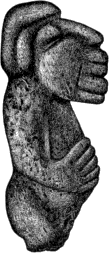 b |
| Fig. 8. Fragmentary human figure in gray basaltic rock—½. | |
A remarkable figure of large size now in the National Museum was obtained from the Island of Cana or Cano by Mr. McNiel. It is nearly three feet in height and very heavy. The face has been mutilated. In general style it corresponds more closely to the sculpture of the Central American States than to that of Chiriqui.
Mealing stones.—
The metate, or hand mill, which consists of a concave tablet and a rubbing stone, was an important adjunct to the household appliances of nearly all the more cultured American nations. It is found not only in those plain substantial forms most suitable for use in grinding grain, seeds, and spices by manual means, but in many cases it has been elaborated into a work of art which required long and skilled labor for its production.
In the province of Chiriqui these mills must have been numerous; but, since they are still in demand by the inhabitants of the region, many of the ancient specimens have been destroyed by use. It seems from all accounts that they were not very generally buried with the dead, but were left upon or near the surface of the ground, and were hence accessible to the modern tribes, who found it much easier to transport them to their homes than to make new ones.
The metates of Chiriqui present a great diversity of form and possibly represent distinct peoples or different grades of culture. They are carved from volcanic rocks of a few closely related varieties, the texture of which is coarse and occasionally somewhat cellular, giving an uneven or pitted surface, well suited to the grinding of maize. Three classes, for convenience of description, may be distinguished, although certain characters are common to all and one form grades 26 more or less completely into another. We have the plain slab or rudely hewn mass of rock, in the upper surface of which a shallow depression has been excavated; we have the carefully hewn oval slab supported by short legs of varied shape; and we have a large number of pieces elaborately sculptured in imitation of animal forms. The first variety is common to nearly all temperate and tropical America and does not require further attention here. The second variety exhibits considerable diversity in form. The tablet is oval, concave above, and of an even thickness. The periphery is often squared and is in many cases ornamented with carved figures, either geometric devices or rudely sculptured animal heads. The legs are generally three in number, but four is not unusual. They are mostly conical or cylindrical in shape and are rather short.
The finest example of the second class has an oval plate 37 inches in length, 29 in width, and 2 inches thick, which is nearly symmetrical and rather deeply concave above. The central portions of the basin are worn quite smooth. Near the ends, within the basin, two pairs of small animal-like figures are carved, and ranged about the lower margin of the periphery are eighty-seven neatly sculptured heads of animals. There are four short cylindrical legs. This superb piece of work is shown in Fig. 9.
Fig. 9. Mealing stone with large tablet ornamented with animal heads, from Gualaca—1/9.
Examples of the third class are all carved to imitate the puma or ocelot. The whole creature is often elaborately worked out in the round from a single massive block of stone. The thin tablet representing the body rests upon four legs. The head, which projects from one end of the tablet, is generally rather conventional in style, but is sculptured with sufficient vigor to recall the original quite vividly. The tail appears at the other end and curves downward, connecting with one of the hind feet, probably for greater security against mutilation. The head, the margin of the body, and the exterior surfaces of the legs are elaborately decorated with tasteful carving. The figures are geometric, and refer, no doubt, to the markings of the animal’s skin. Nearly identical specimens are obtained from Costa Rica and other parts of Central America.
27A fine example of medium size is given in Fig. 10. The material is gray, minutely cellular, basaltic rock. The upper surface of the plate is polished by use. The entire length is 17 inches.
Fig. 10. Puma shaped metate of gray andesite, from Rio Joca—¼.
The largest specimen in the McNiel collection is 2 feet long, 18 inches wide, and 12 inches high. A similar piece has been illustrated by De Zeltner.
The usual office of these metates is considered to be that of grinding corn, cocoa, and the like. The great elaboration observed in some examples suggests the idea that perhaps they were devoted exclusively to the preparation of material (meal or other substances) intended for sacred uses. A high degree of elaboration in art products results in many cases from their connection with superstitious usages.
Speculating upon the use of these objects, De Zeltner mentions a mortar “whose pestle was nothing but a round stone, which still shows traces of gold here and there. It was evidently with the help of this rude instrument that the Indians reduced the gold to powder before fusing it.”13
The implement or pestle used in connection with these mealing tablets in crushing and grinding is often a simple river worn pebble, as mentioned above, but is more usually a cylindrical mass of volcanic rock, worked into nearly symmetric shape.
Stools.—
The stool-like appearance of some of the objects described as metates suggests the presentation in this place of a group of objects that must for the present be classed as stools or seats, although their true or entire function is unknown to me. They are distinguished from the mealing stones by their circular plate, their sharply defined, upright, marginal rim, and the absence of signs of use.
Fig. 11. Stool shaped object carved from gray, minutely cellular basalt—⅓.
Two of these objects are from the vicinity of David. The largest 28 and most interesting is illustrated in Fig. 11. It is carved from a piece of vesicular basaltic tufa and is in a perfect state of preservation. The height is 6 inches and the diameter of the top 10 inches, that of the base being a little less. The slightly concave upper surface is depressed about half an inch below the upright marginal band. The periphery is a little more than an inch in width and is decorated with a simple guilloche-like ornament in relief. The disk-like cap is connected by open lattice-like work with the ring which forms the base. The interior is neatly hollowed out. The open work of the sides consists of two elaborately carved figures of monkeys, alternating with two sections of trellis work, very neatly executed. The other specimen is somewhat less elaborate in its sculptured ornament.
Fig. 12. Stool with columnar base, carved from gray basaltic rock—⅓.
29Outlines of two additional examples of these objects are given in Figs. 12 and 13. The tablets are round, thick, and slightly concave above and are margined with rows of sculptured heads. The supporting column in the first is a plain shaft and the base is narrow and somewhat concave underneath. In the second the column is hollowed out and perforated.
Fig. 13. Stool with perforated base, carved from gray basaltic rock—⅓.
As bearing upon the possible use of these specimens it should be noticed that similar stool-like objects are made of clay, the softness and fragility of which would render them unsuitable for use as mealing plates or mortars, and it would also appear that they are rather fragile for use as stools. I would suggest that they may have served as supports for articles such as vases or idols employed in religious rites, or possibly as altars for offerings.
Celts.—
The class of implements usually denominated celts is represented by several hundred specimens, nearly all of which are in a perfect state of preservation. They are thoroughly well made and beautifully finished, and leave the impression upon the mind that they must represent the very highest plane of Stone Age art.
Although varying widely in form and finish there is great homogeneity of characters, the marked family resemblance suggesting a single people and a single period or stage of culture. They are found in the cists along with other relics and are very generally distributed, a limited number, rarely more than three, being found in a single grave. They may be classified by shape into a number of groups, each of which, however, will be found to grade more or less completely into the others. They display all degrees of finish from the freshly flaked to the evenly picked and wholly polished surface. The edges or points of nearly all show the contour and polish that come from long though careful use. All are made of compact, dark, volcanic tufa that resembles very closely a fine grained slate. The following illustrations include all the more important types of form. There are but few specimens of very large size. That shown in Fig. 14 is 8¼ inches long, 4 inches wide, and seven-eighths of an inch thick. The blade is broad at the edge, rounded in outline, and well polished. The upper 30 end terminates in a rather sharp point that shows the rough flaked surface of the original blocking out. The middle portion exhibits an evenly picked surface. The rock is a dark slaty looking tufa, the surface of which displays ring or rosette-like markings, reminding one of the polished surface of a section of fossil coral. These markings probably come from the decomposition of the mineral constituents of the rock.
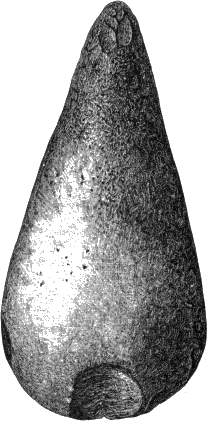 |
 |
| Fig. 14. Large partially polished celt of mottled volcanic tufa—½. | |
The implement given in Fig. 15 may be taken as a type of a large class of beautifully finished celts. It also is made of the dark tufa, very fine grained and compact, resembling slate. The beveled surfaces of the blade are well polished, the remainder of the surface being evenly picked. The hexagonal section is characteristic of the class, but it is not so decided in this as in some other pieces in which the whole surface is freshly ground.
 |
 |
| Fig. 15. Celt of hexagonal section made of dark compact tufa—½. | Fig. 16. Small wide bladed celt made of dark tufa—½. |
The contraction of the lateral outline and the sudden expansion on reaching the cutting edge noticed in this specimen are more clearly marked in other examples. The small celt shown in Fig. 16 is narrow above and quite wide toward the edge. A wide, thick specimen is 31 given in Fig. 17. A specimen quite exceptional in Chiriqui is shown in Fig. 18. Mr. McNiel states that in many years’ exploration this is the only piece seen that exhibits the constriction of outline characteristic of grooved axes.
 |
 |
| Fig. 17. Celt with heavy shaft made of dark speckled tufa—½. | Fig. 18. Celt or ax with constriction near the top. |
 |
 |
| Fig. 19. Flaked and partially polished celt of dark tufa—½. | Fig. 20. Well polished celt of dark tufa—½. |
Two superb implements are illustrated in Figs. 19 and 20, the one in the rough excepting at the cutting edge, where it is ground into the desired shape, and the other neatly polished over nearly the entire 32 surface. The surfaces are somewhat whitened from decomposition, but within the rock is nearly black, and the eye could not distinguish it from a dark slate. The material is shown by microscopic test to be a volcanic tufa. These examples were evidently intended for more delicate work than the preceding. The shapes of the specimens illustrated in Figs. 21 and 22 indicate a still different use. The upper 33 end of the implement is large and rough, as if intended to facilitate holding or hafting, while the shaft diminishes in size below, terminating in a narrow, symmetrical, highly polished edge, a shape well calculated to unite delicacy and strength. The highest mechanical skill could hardly give to stone shapes more perfectly adapted to the manipulation of stone, metal, or other hard or compact substances. The material is a very dark, compact, fine grained tufa.
 |
 |
| Fig. 21. Narrow pointed celt of dark tufa—½. | Fig. 22. Narrow pointed celt of dark tufa—½. |
An additional example is given in Fig. 23. The shaft is cylindrical 34 and terminates in a conical point at one end and in a very narrow, abrupt, cutting edge at the other. The whole surface is polished. The material is the same dark tufa.
| |
|
| Fig. 23. Cylindrical celt with narrow point, of dark tufa—½. | |
The class of objects illustrated in this and the two preceding cuts comprises but a small percentage of the chisel-like implements.
Spearheads (?).—
Another class of objects made of the same fine grained, slaty looking tufa is illustrated in Fig. 24. They resemble spearpoints, yet may have been devoted to a wholly different use. They are long, leaf-like flakes, triangular in section, slightly worked down by flaking, sharpened by grinding at the point, and slightly notched at the top, perhaps for hafting.
 |
 |
 |
| Fig. 24. Leaf shaped objects suggesting spearpoints, of dark tufa—½. | ||
Arrowpoints.—
The unique character of the arrowpoints of Chiriqui is already known to archæologists. The most striking feature is the triangular section presented in nearly all cases and shown in the figures (Fig. 25). The workmanship is extremely rude. The material is generally a flinty jasper of reddish and yellowish hues. The number found is comparatively small. The specimens given are of average size.
 |
 |
 |
| Fig. 25. Arrowpoints of jasper—1/1. | ||
Ornaments.—
It would seem from a study of our collections that ornaments of stone were seldom used by the inhabitants of Chiriqui. There are a few medium sized beads of agate and one pendant of dark greenish stone rudely shaped to resemble a human head. Ornaments of gold and copper were evidently much preferred.
35METAL.
GOLD AND COPPER.
The Chiriquians, like many of their neighbors in the tropical portions of the American continent, were skilled in the working of metals. Gold, silver, copper, and tin—the last in alloys with copper forming bronze—are found in the graves. Gold is the most important, and is associated with all the others in alloys or as a surface coating. The inhabitants of the isthmus at the time of the discovery were rich in objects, chiefly ornaments, of this metal, and expeditions sent out under Balboa, Pizarro, and others plundered the natives without mercy. When the Indian village of Darien was captured by Balboa (1510) he obtained “plates of gold, such as they hang on their breasts and other parts, and other things, all of them amounting to ten thousand pesos of fine gold.”14 From an expedition to Nicaragua the same adventurers brought back to Panama the value of “112,524 pieces of eight in low gold, and 145 in pearls.”15 Early Spanish-American history abounds in stories of this kind. Among others we read that Columbus found the natives along the Atlantic coast of Chiriqui and Veragua so rich in objects of gold that he named the district Castillo del Oro. It is said that the illusory stories of an El Dorado somewhere within the continent of South America arose from the lavish use of gold ornaments by the natives whom the Spaniards encountered, and that Costa Rica gets its name from the same circumstance. It is also recorded that the natives of various parts of Central and South America at the date of the conquest were in the habit of opening ancient graves for the purpose of securing mortuary trinkets. The whites have followed their example with the greatest eagerness. As far back as 1642 the Spaniards passed a law claiming all the gold found in the burial places of Spanish America,16 the whole matter being treated merely as a means of revenue.
The objects of gold for which the tombs of Chiriqui are justly famous are generally believed to have been simple personal ornaments, the jewelry of the primeval inhabitants, although it is highly probable that many of the figures, at least as originally employed, had an emblematic meaning. They were doubtless at all times regarded as possessed of potent charms, and thus capable of protecting and forwarding the interests of their owners. They have been found in great numbers within the last twenty-five years, but for the most part, even at this late date, have been esteemed for their money value only. Very many specimens found their way to this country, where they were either sold for curiosities or, after waiting long for a purchaser, even in the very shadow of our museums, were consigned to the melting 36 pot. Many stories bearing upon this point have been told me. A Washington jeweler is represented as having exhibited in his window on Pennsylvania avenue about the year 1860 a remarkable series of these trinkets, most of which were afterwards sent to New York to be melted. About the same period a gentleman on entering a shop in San Francisco was accosted by a stranger who had his pockets well filled with these curious relics and wished to dispose of them for cash. A number of my acquaintances have neat but grotesque examples of these little images of gold attached to their watch guards, thus approving the taste of our prehistoric countrymen and at the same time demonstrating the identity of ideas of personal embellishment in all times and with all peoples.
The ornaments are found only in a small percentage of the graves, those probably of persons sufficiently opulent to possess them in life; a majority of the graves contain none whatever. They are often found at the bottom of the pits, and probably in nearly the position occupied by them while still attached to the persons of the dead. It is said that occasionally they are found in niches at the sides of the graves, as if placed during the filling of the pit.
Strangely enough, the gold is very generally alloyed with copper, the composite metal ranging from pure gold to pure copper. A small percentage of silver is also present in some of the specimens examined, but this is probably a natural alloy. In a few cases very simple figures appear to have been shaped from nuggets or masses of the native metals; this, however, is not susceptible of proof. The work is very skillfully done, so that we find it difficult to ascertain the precise methods of manipulation. The general effect in the more pretentious pieces resembles that of our filigree work, in which the parts are produced by hammering and united by soldering; yet there are many evidences of casting, and these must be considered with care. As a rule simple figures and some portions of composite figures present very decided indications of having been cast in molds, yet no traces of these molds have come to light, and there are none of those characteristic markings which result from the use of composite or “piece” molds. Wire was extensively used in the formation of details of anatomy and embellishment, and its presence does not at first seem compatible with ordinary casting. This wire, or pseudo-wire it may be, is generally about one-twenty-fifth of an inch in diameter.
The manner in which the numerous parts or sections of complex figures are joined together is both interesting and perplexing. Evidences of the use of solder have been looked for in vain, and if such a medium was ever used it was identical in kind with the body of the object or so small in quantity as to escape detection. At the junction of the parts there are often decided indications of hammering, or at least of the strong pressure of an implement; but in pursuing 37 the matter further we find a singular perfection in the joining, which amounts to a coalescence of the metals of the two parts concerned. There is no weakness or tendency to part along the contact surfaces, neither is there anything like the parting of parallel wires in coils or where a series of wires is joined side by side and carried through various convolutions. In a number of cases I made sections of coils and parts composed of a number of wires, in the hope of discovering evidences of the individuality of the strands, but the metal in the section is always homogeneous, breaking with a rough, granular fracture, and not more readily along apparent lines of junction than across them; and further, in studying in detail the surface of parts unpolished or protected from wear by handling, we find everywhere the granular and pitted unevenness characteristic of cast surfaces. This is true of the wire forms as well as of the massive parts, and, in addition to this, such defects occur in the wires as would hardly be possible if they were of wrought gold.
All points considered, I am inclined to believe that the objects were cast, and cast in their entirety. It is plain, however, that the original model was made up of separately constructed parts of wire or wirelike strands and of eccentric and often rather massive parts, and that all were set together by the assistance of pressure, the indications being that the material used was sufficiently plastic to be worked after the manner of clay, dough, or wax. In one case, for example, the body of a serpent, consisting of two wires neatly twisted together, is held in the hand of a grotesque figure. The hand consists of four fingers made by doubling together two short pieces of wire. The coil has been laid across the hand and pressed down into it until half buried, and the ends of the fingers are drawn up around it without any indication of hammer strokes. Indeed, the effect is just such as would have been produced if the artist had worked in wax. Again, in the modeling of the eyes we have a good illustration. The eye is a minute ball cleft across the entire diameter by a sharp implement, thus giving the effect of the parted lids. Now, if the material had been gold or copper, as in the specimens, the ball would have been separated into two parts or hemispheres, which would not exhibit any great distortion; but as we see them here the parts are flattened and much drawn out by the pressure of the cutting edge, just as if the material had been decidedly plastic.
It seems to me that the processes of manufacture must have been analogous to those employed by the more primitive metal workers of our own day. In Oriental countries delicate objects of bronze and other metals are made as follows: A model is constructed in some such material as wax or resin and over it are placed coatings of clay or other substance capable of standing great heat. These coatings, when sufficiently thickened and properly dried, form the mold, from which the original model is extracted by means of heat. The fused 38 metal is afterwards poured in. As a matter of course, both the mold and the model are destroyed in each case, and exact duplications are not to be expected. Mr. George F. Kunz, of New York, with whom I have discussed this matter, states that he has seen live objects, such as insects, used as models in this way. Being coated with washes of clay or like substance until well protected and then heavily covered, they were placed in the furnace. The animal matter was thus reduced to ashes and extracted through small openings made for the purpose.
As bearing upon this subject it should be mentioned that occasionally small figures in a fine reddish resin are obtained from the graves of Chiriqui. They are identical in style of modeling with the objects of gold and copper obtained from the same source.
In discussing possible processes, Mr. William Hallock, of the division of chemistry and physics of the United States Geological Survey, suggested that if the various sections of a metal ornament were embedded in the surface of a mass of fire clay in their proper relations and contacts they could then be completely inclosed in the mass and subjected to heat until the metal melted and ran together. After cooling, the complete figure could be removed by breaking up the clay matrix. I imagine that in such work much difficulty would be experienced in securing proper contact and adjustment of parts of complex figures. It will likewise be observed that evidences of plasticity in the modeling material would not exist. I must not pass a suggestion of Nadaillac17 which offers a possible solution of the problem of manipulation. Referring to a statement of the early Spanish explorers that smelting was unknown to the inhabitants of Peru, he states that it would be possible for a people in a low state of culture to discover that an amalgam of gold with mercury is quite plastic, and that after a figure is modeled in this composite metal the mercury may be dissipated by heat, leaving the form in gold, which then needs only to be polished. There is, however, no evidence whatever that these people had any knowledge of mercury.
There is no indication of carving or engraving in the Chiriquian work. In finishing, some of the extremities seem to have been shaped by hammering. This was a mere flattening out of the feet or parts of the accessories, which required no particular skill and could have been accomplished with comparatively rude stone hammers. It is a remarkable fact that many, if not most, of the objects appear to be either plated or washed with pure gold, the body or foundation being of base gold or of nearly pure copper. This fact, coupled with that of the association of objects of bronze with the relics, leads us to inquire carefully into the possibilities of European influence or agency. I observe that recent writers do not seem to have questioned the genuineness of the objects described by them, but that at the same time no mention is made of the plating or washing. This latter circumstance 39 leads to the inference that pieces now in my possession exhibiting this phenomenon may have been tampered with by the whites. In this connection attention should be called to the fact that history is not silent on the matter of plating. The Indians of New Granada are said to have been not only marvelously skillful in the manipulation of metals, but, according to Bollaert, Acosta declares that these peoples had much gilt copper, “and the copper was gilt by the use of the juice of a plant rubbed over it, then put into the fire, when it took the gold color.”18 Just what this means we cannot readily determine, but we safely conclude that, whatever the process hinted at in these words, a thin surface deposit of pure gold, or the close semblance of it, was actually obtained. It is not impossible that an acid may have been applied which tended to destroy the copper of the alloy, leaving a deposit of gold upon the surface, which could afterwards be burnished down.
It has been suggested to me that possibly the film of gold may in cases be the result of simple decay on the part of the copper of the alloy, the gold remaining as a shell upon the surface of the still undecayed portion of the composite metal; but the surface in such a case would not be burnished, whereas the show surfaces of the specimens recovered are in all cases neatly polished.
If we should conclude that the ancient Americans were probably able to secure in some such manner a thin film of gold, it still remains to inquire whether there may not have been some purely mechanical means of plating. In some of the Chiriquian specimens a foundation of very base metal appears to have been plated with heavy sheet gold, which as the copper decays comes off in flakes. Occasional pieces have a blistered look as a consequence. Were these people able with their rude appliances to beat gold into very thin leaves? and Had they discovered processes by which these could be applied to the surfaces of objects of metal? are questions that should probably be answered in the affirmative.
The flakes in some cases indicate a very great degree of thinness. Specimens of sheet gold ornaments found in the tombs are thicker, but are sufficiently thin to indicate that, if actually made by these people, almost any degree of thinness could be attained by them. It would probably not be difficult to apply thin sheet gold to the comparatively smooth surfaces of these ornaments and to fix it by burnishing.
Mr. Kunz suggests still another method by means of which plating could have been accomplished. If a figure in wax were coated with sheet gold and then incased in a clay matrix, the wax could be melted out, leaving the shell of gold within. The cavity could then be filled with alloy, the clay could be removed, and the gold, which would adhere to the metal, could then be properly burnished down.
40It will be seen from this hasty review that, although we may conclude that casting and plating were certainly practiced by these peoples, we must remain in ignorance of the precise methods employed.
Referring to the question of the authenticity of the specimens themselves, I may note that observations bearing upon the actual discovery of particular specimens in the tombs are unfortunately lacking. Mr. McNiel acknowledges that with all his experience in the work of excavation no single piece has been taken from the ground with his own hands, and he cannot say that he ever witnessed the exhumation by others, although he has been present when they were brought up from the pits. Generally the workmen secrete them and afterwards offer them for sale. He has, however, no shadow of a doubt that all the pieces procured by him came from the graves as reported by his collectors. The question of the authenticity of the gilding will not be satisfactorily or finally settled until some responsible collector shall have taken the gilded objects with his own hands from their undisturbed places in tombs known to be of pre-Columbian construction.
There are many proofs, however, of the authenticity of the objects themselves. It is asserted by a number of early writers that the American natives were, on the arrival of the Spaniards, highly accomplished in metallurgy; that they worked with blowpipes and cast in molds; that the objects produced exhibited a high order of skill; and that the native talent was directed with unusual force and uniformity toward the imitation of life forms. It is said that the conquerors were “struck with wonder” at their skill in this last respect. And a strong argument in favor of the genuineness of these objects is found in the fact that it is not at all probable that rich alloys of gold would have been used by Europeans for the base or foundation when copper or bronze, or even lead, would have served as well. We also observe that there is absolutely no trace of peculiarly European material or methods of manipulation, a condition hardly possible if the extensive reproductions were made by the whites. Neither are there traces of European ideas embodied in the shapes or in the decoration of the objects—a circumstance that argues strongly in favor of native origin. An equally convincing argument is found in the fact that all the alloys liable to corrosion exhibit marked evidences of decay, as if for a long period subject to the destructive agents of the soil. In many cases the copper alloy base crumbles into black powder, leaving only the flakes of the plating. Lastly and most important, the strange creatures represented are in many cases identical with those embodied in clay and in stone, and for these latter works no one will for a moment claim a foreign derivation.
Considering all these arguments, I arrive at the conclusion that the ornaments are, in the main, genuine antiquities, and that, if any deception at all has been practiced, it is to be laid at the door of modern 41 goldsmiths and speculators, who, according to Mr. McNiel, are known in a few cases to have “doctored” alloyed objects with washes of gold with the view of selling them as pure gold.
I present the following specimens with a reasonable degree of confidence that all, or nearly all, are of purely American fabrication, and I sincerely hope that at no distant day competent archæologists may have the opportunity of making personal observations of similar relics in place.
The objects consist to a great extent of representations of life forms, in many cases more fanciful than real and often extremely grotesque. They include the human figure and a great variety of birds and beasts indigenous to the country, in styles resembling work in clay and stone of the same region. My illustrations show the actual sizes of the objects.
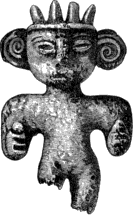 |
 |
| Fig. 26. Human figure with ridged crown, formed of copper-gold alloy. | |
The human figure.—
Statuettes of men and women and of a variety of anthropomorphic figures of all degrees of elaboration abound. Fig. 26 illustrates a plain, rude specimen belonging to the collection of J. B. Stearns. It was obtained by Mr. McNiel from near the south base of Mount Chiriqui. The body is solid and the surface is rough and pitted, as if from decay. In many respects it resembles the stone sculptures of the isthmus. The metal is nearly pure copper. A piece exhibiting more elaborate workmanship, illustrated by Bollaert,19 is shown in Fig. 27. Another remarkable specimen is illustrated by De Zeltner, but the photograph published with his brochure is too indistinct to permit of satisfactory reproduction. He describes it in the following language:
The most curious piece in my collection is a gold figure of a man, 7 centimeters in height. The head is ornamented with a diadem terminated on each side with the head of a frog. The body is nude, except a girdle, also in the form of a plait, supporting a flat piece intended to cover the privates, and two round ornaments on 42 each side. The arms are extended from the body; the well drawn hands hold, one of them a short, round club, the other a musical instrument, of which one end is in the mouth and the other forms an enlargement like that of a flute, made of human bone. It is not probable that this is a pipe. Both thighs have an enlargement, and the toes are not marked in this little figurine.20
 |
 |
| Fig. 27. Grotesque human figure in gold, from Bollaert. | Fig. 28. Rudely shaped and finished human figure in gold. |
An excellent example of the more elaborate figures is shown in Fig. 30. It is of reddish gold, slightly alloyed apparently with copper, and has in finishing received a very thin wash or plating of yellow gold, which is worn off in exposed parts. The central feature of the rather complicated structure is a grotesque human figure, much like the preceding, and having counterparts in both clay and stone. The figure is backed up and strengthened by two curved and flattened bars of gold, one above and the other below, as seen in the cut. The figure is decked with and almost hidden by a profusion of curious details, executed for the most part in wire and representing serpents and birds. Three vulture-like heads project from the crown and overhang the face. Two serpents, the bodies of which are formed of plaited wire, issue from the mouth of the figure and are held about the neck by the hands. The heads of the serpents are formed of wire folded in triangular form and are supplied with double coils of wire at the sides, as if for ears, and with little balls of gold for eyes. Similar heads project from the sides of the head and from the feet of the image.
Fig. 30. Grotesque human figure in nearly pure gold.
The peculiarities of construction are seen to good advantage in this specimen. The figure is made up of a great number of separate pieces, united apparently by pressure or by hammering while the material was somewhat plastic. Upwards of eighty pieces can be counted. The larger pieces, forming the body and limbs, are hollow or concave behind. Nearly all the subordinate parts are constructed of wire.
The bird.—
Images of birds are numerous and vary greatly in size and elaboration. They are usually represented with expanded wings and tails, the under side of the body being finished for show. The back is left concave and rough, as when cast, and is supplied with a ring for suspension or attachment, as seen in the profile view (Fig. 31). The owl, the eagle, the parrot, and various other birds are recognized, although determinations of varieties are not possible, as in many cases the forms are rude or greatly obscured by extraneous details. The example shown in Fig. 31 is of the simplest type and the rudest workmanship, and is apparently intended for some rapacious species, possibly a vulture. The body, wings, and tail are 45 hammered quite thin and are left frayed and uneven on the edges. The material appears to be nearly pure copper plated with yellow gold. Specimens of this class are very numerous. One, presented in a publication of the Society of Northern Antiquaries, and now in the museum at Copenhagen, is thought to be intended for a fish hawk, as it carries a fish in its mouth. De Zeltner mentions a statuette in gold of a paroquet, whose head is ornamented with two winged tufts. Such a specimen may be seen in the collection of Mr. Stearns.
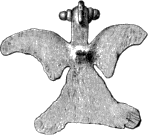 |
 |
| Fig. 31. Rudely executed image of a bird in gold. | |
Fig. 32 is reproduced from Bollaert. It represents a parrot and is very elaborately worked.
Fig. 32. Image of a bird in gold, from Bollaert.
The puma.—
Representations of quadrupeds are common; a good example, copied from Bollaert, is given in Fig. 33. The animal intended is apparently a puma, a favorite subject with Chiriquian workers in clay and stone as well as in gold. The body is hollow and open beneath and the fore feet are finished with loops for suspension. A similar piece with head thrown back over the body is shown in Fig. 34. The metal in this case appears to be nearly pure copper.
 |
 |
| Fig. 33. Puma shaped figure in gold. | Fig. 34. Puma shaped figure in base metal. |
Grotesque figure.—
Another piece collected by Mr. McNiel is outlined in Fig. 35. The metal is quite base and the surface has been coated with gold, which is now nearly all rubbed off. The shape is that of a quadruped. The face has a rather grotesque, not to say satanic, expression. The details are not unlike those of other examples previously given.
The fish.—
The fish was a favorite subject with the ancient nations of South America, and is modeled in clay, woven into fabrics, and worked in metals with remarkable freedom. It was in great favor in Chiriqui and must have been of importance in the mythology of the country. It occurs most frequently in pottery, where it is executed in color and modeled in the round. The very grotesque specimen in gold shown in Fig. 36 is copied from Harper’s Weekly of August 6, 1859, where it forms one of a number of illustrations of these curious ornaments. The paper is, I believe, by Dr. F. M. Otis, who had just returned from Panama. A very curious piece owned by Mrs. Philip Phillips, of Washington, represents a creature having some analogies 47 with the fish figure of Otis. Issuing from the mouth is the same forked tongue, each part terminating in a serpent’s head. The body is about two inches long and the back has five triangular perforations. The tail is forked and the four leg-like members terminate in conventional serpents’ heads. The metal is pure or nearly pure gold.
Fig. 36. Figure of a fish in gold. From Harper’s Weekly, 1859.
The frog.—
The frog appears in the plastic art of Chiriqui more frequently perhaps than any other reptile. Its form is reproduced with much spirit and in greatly varying sizes, degrees of elaboration, and styles of presentation. It is probable that a number of species are represented. In Fig. 37 we have a large, rather plain specimen, now in the National Museum. The body and limbs are concave beneath, the metal being about one-sixteenth of an inch thick. Teeth are suggested by a number of perforations encircling the jaws and the eyes are minute hawk bells containing pellets of metal. The legs are 48 placed in characteristic positions, and the hind feet are broad plates without indications of toes, a characteristic of these golden frogs. The framework or foundation is of copper, apparently nearly pure, and the surface is plated with thin sheet gold, which tends to flake off as the copper foundation corrodes.
Fig. 37. Large figure of a frog in base metal plated with gold.
The minute, delicately finished example given in Fig. 38 contrasts strongly with the preceding. It is also of base metal plated with pure gold and belongs to the collection of Mr. Stearns.
 |
|
| Fig. 38. Small figure of a frog, in base metal plated with gold. | |
The alligator.—
The alligator, which appears so frequently in the pottery of Chiriqui, is only occasionally found in gold. A striking specimen, illustrated in Harper’s Weekly of August 6, 1859, is given in Fig. 39. A similar piece, formed of base metal, is in the collection of Mr. Stearns.
Fig. 39. Figure of an alligator, in gold, published in Harper’s Weekly, 1859.
The crayfish (?).—
In Fig. 40 we have a fine specimen, intended apparently to represent a crayfish or some similar crustacean form. The head is supplied with complicated yet graceful antenna-like appendages, 49 made of wire neatly coiled and welded together by pressure or hammering. The eyes are globular and are encircled by the ends of a double loop of wire which extends along the back and incloses a line of minute balls or nodes. The peculiar wings and tail will be best understood by referring to the illustration. The foundation metal is much corroded, being dark and rotten, and the plating of reddish gold seems to have been coated with a thin film of yellow gold. The profile view gives a good idea of the thickness of the metal and of the relief of the parts. Two rings or loops of doubled wire are attached to the extreme end of the nose and a heavy ring for suspending is fixed to the under side of the head.
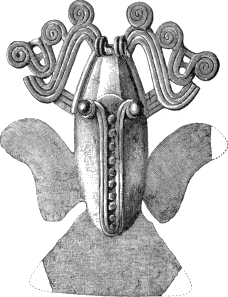 |
 |
| Fig. 40. Animal figure, in base metal plated with gold. | |
Miscellaneous.—
Gold, pure and in the usual alloys, was also used in the manufacture of other articles, such as bells, beads, disks, balls, rings, whistles, thimble shaped objects, and amulets of varied shapes. Bells are more generally made of bronze, because, perhaps, of its greater degree of resonance. Thin plates, or rather circular sheets, of gold leaf are numerous. One mentioned by Bollaert was 7¼ inches in diameter. They are plain or crimped about the margins, indented in various ways, and sometimes perforated, apparently for suspension or attachment. Merritt mentions examples having holes which showed evidences of wear upon one side only, indicating attachment in a fixed position to some object or to some part of the costume. But one example is at hand, a thin sheet, three inches in diameter and crimped or indented neatly about the margin. Its thickness is about that of ordinary tinfoil.
BRONZE.
Bells.—
Bells seem to have been in pretty general use by the more cultured American races previous to the conquest. The form best known is the hawk bell, or common sleighbell of the North. The globular body is suspended by a loop at the top and is slit on the under side, so that the tinkling of the small free pellets of metal may be audible. Such bells are found in considerable numbers in the graves of Chiriqui, although I have no positive assurance that any of the examples in my possession were actually taken from graves which contained typical Chiriquian relics of other classes. The specimens now in the National Museum (Fig. 41) are in most cases, if not in all, of bronze, as determined by Mr. R. B. Riggs, of the chemical laboratory of the United States Geological Survey. All have been cast in molds. In most cases there are traces of a plating of gold. The largest is 1¼ inches in height and three-fourths of an inch in diameter. It is surmounted by the rude figure of an animal, through or beneath the body of which is an opening for the attachment of a cord. Others have simple loops at the top. The small perforated specimen belongs to Mr. Stearns. The additional piece given in Fig. 42 is unique in conception. It represents a human head, which takes an inverted position 50 when the bell is suspended. The lower part of the bell forms a conical crown to the head and the ring of suspension is attached to the chin. Double coils of wire take the place of the ears, and the other features are formed by setting on bits of the material used in modeling. This specimen belongs to the collection of Mr. Stearns. Many examples of more elaborate workmanship have been recovered from the tombs and are now to be found in the collections of America and Europe.
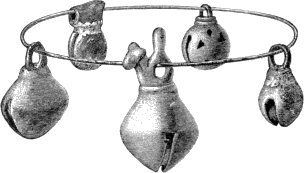 |
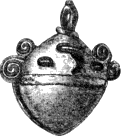 |
| Fig. 41. Bronze bells plated or washed with gold. | Fig. 42. Bronze bell with human features. |
A specimen found many years ago on the Rio Grande, near Panama, and figured in Harper’s Weekly, was of gold and showed specific variations from the Chiriquian pieces. It will be seen by reference to the outline given in Fig. 43 that three very neatly shaped and gracefully ornamented bells are mounted upon a circular plate to which a short handle is attached. It was evidently not intended for suspension, but rather to be held in the hand as a rattle.
Fig. 43. Triple bell or rattle found on the Rio Grande.
A question as to the authenticity of these bells as aboriginal works very naturally arises, and it may be difficult to show to the satisfaction of the skeptical mind that any particular specimen is not of European origin or inspiration. At the same time we are not without strong evidences that such bells were in use by the Americans before the advent of the whites. Historical accounts are not wanting, but I shall only stop to point out some of the internal evidences of the native art. The strongest argument is to be found in the presence 51 of analogous features in other branches of the art and in other arts. The eyes of the golden figures of reptiles are in many cases minute hawk bells, and in works of clay, the purely aboriginal character of which has not been called in question, similar features are discovered. The American origin of the bell, therefore, is not to be questioned. The form originated, no doubt, in the rattle, at first a nutshell or a gourd; later it was modeled in clay, and in time the same idea was worked out in the legs and the ornaments of vessels and in the heads and other parts of animal forms, which were made hollow and supplied with tinkling pellets. With the acknowledged skill of these people in the working of metals, there is no reason why the bells described should not have been manufactured independently of European aid and influence, provided the requisite metal was at hand.
52It should be observed that if these early American bells were copied from or based upon Spanish originals they would not probably vary greatly in type with the various sections from which they are recovered, but it is observed that marked and persistent differences do occur. The well known Mexican bell, an example of which is outlined in Fig. 44, although of bronze, is generically distinct in form and construction.
In a brief review I may recall the more salient points regarding the use of metals in ancient Chiriqui. Gold, silver, copper, and apparently tin are represented.
Gold and copper were very plentifully distributed among the isthmian races, but we have little information as to the sources of supply. Free gold is found in the stream beds of many localities, and copper was probably found in its native state in some convenient locality; yet it is not impossible that these metals were transported from distant regions, as the inhabitants of Chiriqui must have had considerable intercourse with those of Central America on the north and with those of Granada on the south. Silver and tin are found in alloys with gold and copper, but not as independent metals. The silver gold alloy is probably a natural compound. In no case have I found silver to exceed 6 per cent. of the composite metal. Tin was artificially alloyed with copper, forming bronze. The latter metal resembles our ordinary bronze in color and hardness, but I am unable to secure more than a qualitative analysis on account of the scarcity of specimens available for the purpose. We have no information in regard to the origin of the tin. It is not found in a native state, and since it seems hardly probable that the Chiriquians understood smelting ores we are left in doubt as to whether it was obtained from more cultured nations to the north or to the south or from transoceanic countries.
The gold-copper alloys appear to range between pure gold and pure copper. If the bronze is of European origin, then we must conclude that all objects made of that metal are of post-Columbian manufacture. This question will probably be definitely settled in the near future.
The greater number of the objects were formed by casting in molds. Hammering was but little practiced, excepting, apparently, in the formation of sheet gold, which was probably an indigenous product. Repoussé work is not found, save as represented in the crimping and indenting of gold leaf. Engraving and carving were not practiced. It may be considered certain that gilding, or at least plating, was understood.
The objects are obtained from ancient graves of which no record or reliable tradition is preserved. They are all ornaments, no coin, weapon, tool, or utensil having come to my notice. The absence of 53 utensils and of hammered objects of any kind strikes me as being rather extraordinary, since it is popularly supposed that, in the normal succession of events, hammering should precede casting and that utensils should be made before elaborate ornaments.
The work exhibits close analogies with that of the mainland of South America, but these analogies appear to be in material, treatment, and scope of employment rather than in the subject matter of the conceptions. The personages and zoömorphic characters represented are characteristically Chiriquian, and were derived no doubt from the mythology of the locality. These works affiliate with the various works in stone and clay, the art products of the province thus constituting a fairly homogeneous whole and being entirely free from traces of European influence.
Metals do not come into use early in the history of a race, as they are not found in shapes or conditions suitable for immediate use, nor are they sufficiently showy when found to be especially desirable for ornaments. A long period must have elapsed before the use of metals was discovered, and a longer period must have passed before they were worked; and, in the light of our knowledge of the ancient tribes of the United States, it would seem that a considerable degree of culture may be achieved before the casting of metals is understood; but in the ordinary course of progress the discovery of methods of alloying rare metals would be far separated from that of the simple fusing and casting of a single metal, such as gold. The Chiriquian peoples not only had a knowledge of the methods of alloying gold with copper, and, apparently, copper with tin, but, if our data are correct, they were able to plate the baser metals and alloys with sheet gold, and, what is far more wonderful, to wash them with gold, producing an effect identical with that of our galvanic processes.
The character of the conceptions embodied in the art unite with evidences of technical skill to prove to us that American culture, as represented by the metal ornaments of Chiriqui, was not the product of a day, but of long periods of experiment and progress.
POTTERY.
Preliminary.—
The importance of the potter’s art to archæology has often been pointed out. Baked clay is one of the most enduring materials utilized in art, and its employment by the races of men has fallen but little short of universal. The creations of that noblest of arts, architecture, and the antecedent forms of house building are necessarily left where erected, to be fed upon by the remorseless elements of nature, but the less pretentious utensil of clay accompanies its owner to the tomb, where it remains practically unchanged for ages.
Many glimpses of the early history of the American races and of 54 the progress of art in pre-Columbian times are obtained through these exhumed relics, and in no case have we a view more clear and comprehensive than that furnished in the series here presented. The graves of Chiriqui have yielded to a single explorer upwards of 10,000 pieces of pottery, and this chiefly from an area perhaps not more than fifty miles square. These vessels constitute at least 90 per cent. of the known art of the ancient occupants of the province, and, although not so eloquent of the past as are the inscribed tablets of Assyria or the pictured vases of Greece, they tell a story of art and of peoples that without their aid would remain untold to the end of time.
A careful study of the earthenware of this province leads to the conclusion that for America it represents a very high stage of development, and its history is therefore full of interest to the student of art. Its advanced development as compared with other American fictile products is shown in the perfection of its technique, in the high specialization of form, and in its conventional use of a wide range of decorative motives. There is no family of American ware that bears evidence of higher skill in the manipulation of clay or that indicates a more subtile appreciation of beauty of form, and no other that presents so many marked analogies to the classic forms of the Mediterranean. Strangely enough, too, notwithstanding the well established fact that only primitive methods of manufacture were known, there is a parallelism with wheel made ware that cannot but strike the student with amazement.
In speaking thus of the whole body of ceramic products, I would not convey the impression that there is perfect homogeneity throughout, as if all were the work of a single people developed from within, and therefore free from the eccentricities that come from exotic influence. On the contrary, there is strong evidence of mixed conditions of races and of arts, the analysis of which, with our present imperfect data, will be extremely difficult. These evidences of mixed conditions are found in the marked diversity and individuality of character of the various groups of ware.
It is impossible, without the aid of careful observations in the field, to arrive at any conclusion as to the relative age of the different varieties of ware. Appearances of age are deceptive; the newer looking varieties may be the older and those executed in the most primitive style may belong to the later period, for grades in culture are not chronologic.
With reference to the principal groups of relics, we cannot do better than accept the statements of collectors that all are buried in like ways and in similar tombs, different varieties in many cases occurring in the same tomb. There are, however, in a few minor groups such marked distinctions in workmanship and style that we are compelled to attribute them to different periods or to distinct communities. 55 The groups separated most completely from others are the scarified pottery presented first in the series of painted wares, the maroon group, which follows, and other varieties represented by fugitive pieces. The latter may have reached Chiriqui from neighboring provinces. There are certain pieces that speak decidedly of Costa Rican influence and others that find their counterparts in the Colombian states to the south.
In art in clay in most countries the vessel is the leading idea, the center about which nearly the entire ceramic art is gathered. This is true in a marked degree in Chiriqui, and vessels are therefore given the first place in this paper. The less usual forms include drums, whistles, rattles, stools, spindle whorls, needlecases, and toy-like images, all of which present features of peculiar interest. These classes of objects are discussed in separate sections.
There are few indications of an ambition to model natural forms or mythologic figures independently of utensils and useful objects, and, strange to say, no pieces are found that portray the human face and figure with even a fair degree of approach to nature.
How found.—
In describing the graves and tombs in a previous section, I alluded to the manner in which the pottery was deposited. It appears to have been buried with the dead or thrown into the grave with the earth and stones with which the pit was filled. There was little regularity in the place or position of the vessels and many were broken when found. The precise use of the vessels, the character of the contents, or the relation of particular pieces to the remains of the dead cannot be determined. Although the human remains have almost entirely disappeared and there are no traces left of utensils of wood, bone, horn, or shell, the paste, slip, and colors are wonderfully well preserved and the surface is not even discolored by contact with the earth. When found, every crevice and cavity is completely filled with earth, and the paste is often so tender that the vessels have to be dried with great care before they can be handled with freedom. The number of pieces found in a grave sometimes reaches twenty, but the average is perhaps not above three or four.
Material.—
The material used in the manufacture of this ware is remarkably uniform throughout the whole province, varying slightly with the locality, with the group, and with the character of the vessel constructed. Generally the paste consists of a matrix of fine clay tempered with finely pulverized sand, in which may be detected grains of quartz, feldspar, hornblende, augite, particles of iron oxide, &c. Argillaceous matter has been sparingly used, the sand in many cases comprising at least 75 per cent. of the mass. Many of the unpainted specimens, from which the polished slip has been removed, give off showers of fine sand when rubbed by the hand, and it is difficult to detect the presence of any finely comminuted matrix whatever. The 56 thin slip employed in surface finish is more highly argillaceous than the paste. The clay used was probably mostly light in color, as the paste is now quite uniformly so. The baking was effected apparently without a very high degree of temperature and by methods that left few marks or discolorations upon the vessels. In hardness and durability the paste corresponds pretty closely with that of our red porous earthenware. The softer pieces can be scratched or even carved with a knife. Water will penetrate any of these vessels in a few minutes, but decay has probably tended to make the walls more porous.
Manufacture.—
There is no piece of this ware that does not bear evidence of a high degree of skill on the part of the potter; and yet, owing to the thorough manner in which the work is finished, the precise methods of manipulation are not easily detected. So great is the symmetry and so graceful are the shapes that one is led to suspect the employment of mechanical devices of a high order. The casual observer would at once arrive at the conclusion that the wheel or molds had been used, but it is impossible to detect the use of any such appliances. We observe that irregular and complex forms, in the production of which mechanical appliances could not be used to advantage, are modeled with as much grace of contour and perfection of surface as are the simpler shapes that could be turned upon a wheel, and we conclude that with this remarkable people the hand and the eye were so highly educated that mechanical aids were not indispensable. I find no evidence that coil building was systematically practiced, but it is clear that parts of complex forms were modeled separately and afterwards united. The various ornaments in relief (the heads and other parts of animals) and the handles, legs, and bases of vessels were constructed separately and then luted on, and with such skill that the thinnest walls and the most complex and delicate forms were not injured in the process. The contact irregularities were then worked down, and every part of the surface, including the more important ornaments, were rendered smooth, preparatory to the application of the thin surface wash or slip. After the slip was applied and the clay became somewhat indurated, the surface was polished with smooth pebbles, the marks of which can be seen on the less accessible parts of the vessel. On the exposed surfaces of certain groups of ware the polish is in many cases so perfect that casual observers and inexperienced persons take it for a glaze. Incised figures and painted decorations were generally executed after the polishing was complete. Details of processes will be given as the various classes of ware pass under review.
The methods of baking were apparently of a higher order than those practiced in many parts of America. One rarely discovers traces of the dark discolorations that result from primitive methods of baking, yet there are none of the contact marks that arise from the furnace firing of Spanish-American potters.
57Color.—
The colors of the ware and of the surface applications vary decidedly with the different groups. The prevailing colors of the paste may be defined as ranging from very light yellow grays to a variety of ochery yellows and very pale terra cotta reds. In one or two groups there is an approach to salmon and orange hues, and in another the color is black or dark brown. The color within the mass is in some cases darker than upon the surface, an effect produced in baking, and not through the use of different clays. The slip is usually lighter than the surface of the paste.
The colors used in finishing and decorating are confined to reds, blacks, and purple grays. In one large group of ware the appearance of the delineations is such as to lead to the conclusion that the principal pigment or fluid employed in delineation has totally disappeared, carrying with it all underlying colors not of unusual permanence or not worked down with the polishing implement. The Aztec and other races of tropical America used an argillaceous, white pigment in decorating their wares, which has in many cases partially or wholly disappeared, carrying away considerable portions of the colors over which it was laid, while in other cases, and also in this Chiriqui ware, there is no trace of color remaining and we are left to surmise that the brush used probably contained merely a “taking out” medium. Red was profusely used and varies from a light vermilion to a deep maroon. In certain classes of vessels it was hastily daubed on, covering prominent parts of the surface or forming irregular spots, streaks, and rude figures. In two groups of ware it was used as the chief delineating color. In some cases it was employed as a wash or slip and was worked down with the polishing stone, and in this condition it was treated as a ground upon which to execute designs in other colors. It is always a fast color and is probably of mineral character.
The blacks are of two kinds, which are used in distinct groups of ware: one, probably a mineral pigment, somewhat pasty when applied and quite permanent, is always used in delineating the ornamental figures; the other, possibly a vegetable tint, is always used as a ground upon which to execute designs in other mediums. It is confined to a single group of ware. It has in many cases disappeared entirely, and where remaining can be removed with ease by rubbing.
A light purple tint is tastefully and sparingly employed in one group of ware. Browns and other hues occur but rarely and in all cases result from alterations of other colors produced in firing. The color effects of this pottery, although evidently much modified by age, are sufficiently rich to be highly pleasing to the eye.
Use.—
The uses to which most classes of earthen products were applied are easily determined. Whistles, drums, rattles, and spindle whorls have definite duties to perform, and vessels, as to general scope of function, answer for themselves: but when we come to inquire 58 into the particular uses of the various groups of vessels we are often at a loss. The majority of the pieces show no abrasion by handling or discoloration by fire or by contents, and I am inclined to believe that a large portion were taken directly from the furnace and deposited in the tombs. This implies manufacture for purely mortuary purposes.
Two important groups, the high tripods and the two handled cups or pots, are generally discolored by use over fire, but we cannot say with confidence whether that use was a domestic one or whether it was ceremonial. The small size and the elaborate modeling of a majority of the pieces make it appear improbable that they were intended for use in ordinary cooking or even in the preparation of beverages. A few large plain caldrons are found, and these were probably domestic receptacles. All things considered, it would seem highly probable that the greater portion of the vessels exhumed from the graves were intended to be used for religious and mortuary purposes.
The preceding paragraphs refer, for the most part, to the whole body of earthenware products, but throughout the rest of this section I shall treat of vessels only, except in the matter of decoration, which refers equally to all classes of objects.
| a |
b |
 c |
 d |
 e |
 f |
| Fig. 45. Fundamental forms of vases—convex outlines. | ||
| a b |
 c |
 d |
 e |
| Fig. 46. Fundamental forms of vases—angular outlines. | |||
 a |
 b |
| Fig. 47. Vases of complex outlines—exceptional forms. | |
Forms of vessels.—
Divesting the utensil of extraneous features, such as rims, handles, and legs, we have the following series of shapes, which shows a pretty full graduation of outline from extreme to extreme. Beginning with the simplest fundamental form, the shallow cup (Fig. 45, a), we ascend gradually to more complex outlines, such as are seen in the hemispherical bowl (b), the deep basin with slightly incurved rim (c), the globular form (d), and the elongated form (e). Occasionally we see an eccentric variation, such as is shown in f. Flat bottoms are unusual; a conical base is the rule. Outlines do not always exhibit these even, convex curves, but many are straight or concave in profile, as shown in Fig. 46. Complex 59 forms are shown in Fig. 47, a and b, and compound forms in Fig. 48, a and b. Examples of these classes are numerous and important. The compound shapes result from the union of two or more simple forms. Eccentric forms are numerous and result in a majority of cases from the employment of some animal as a model. Thus, if an alligator or almost any quadruped is embodied in the vessel, the form tends to become elongated; if a crab or a fish is imitated, there is a tendency to flatness &c. The base is almost universally more or less conical, is rarely flat, and never concave, excepting as the result of the addition of an annular foot or stand. The radical shapes do not undergo any considerable change when rims, necks, handles, legs, and other appendages are added. The rim or lip is in many cases incurved, but as a rule it is turned outward. The margin is plain, 60 symmetrical, and often considerably thickened. In a few instances the outline is rectangular or scalloped, as shown in Fig. 49, and the attachment of handles often leads to peculiar outlines, as will be seen further on.
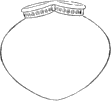 a |
 b |
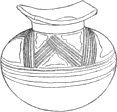 |
| Fig. 48. Vases of compound forms. | Fig. 49. Square lipped vessel. | |
The neck in its simplest form is a narrow upright band surrounding the orifice (Fig. 50, a) and is not differentiated from the rim. Variations in size and shape are shown in the remaining figures of the series. In b it is a narrow constricted band beneath an overhanging rim, in c it is upright and considerably elongated, and in d it expands, giving a funnel shaped mouth. The exterior surface is very generally decorated with relieved or painted devices. High necked bottles and pitcher shaped vessels are unknown.
 a |
 b |
 c |
 d |
| Fig. 50. Variations in the forms of necks and rims—various groups of ware. | |||
Handles constitute a very interesting feature of this pottery and are much varied in shape and arrangement. In a few cases the handle is a single arch springing over the orifice, as seen in Fig. 51, a. Again, the handle is attached to one side, as in b, but as a rule handles occur in twos upon the shoulder, one on either side of the aperture. They are horizontally attached, as in c, or vertically placed, as in d, connecting the rim with the shoulder, or they occur low on the body, as in e. In rare cases there are four handles, which are arranged as seen in f or are set on in pairs. In the elaboration of handles, the use made of animal forms is perhaps the most notable feature. Grotesque figures are made to take the place of handles or are attached to or placed near 61 them. The treatment is so varied that I shall have to refer the student to the subsequent series of illustrations.
 a |
 b |
 c |
 d |
 e |
 f |
| Fig. 51. Arrangement of handles—various groups of ware. | ||
Annular bases or feet were not in very general use in Chiriqui, although in some cases they are modeled with a great deal of grace. The shape varies from a simple ring, barely deep enough to give a firm support to the vessel when placed upon a level surface, to a long, attenuated column with flaring base. The latter is perhaps one of the nearest approaches which America has furnished to the slender foot characteristic of the wheel made ware of Mediterranean countries.
 a |
 b |
 c |
 d |
| Fig. 52. Types of annular bases or feet—various groups of ware. | |||
The vessel shown in Fig. 52, a, has a somewhat rudimentary foot; another, b, a firm, wide base, which is perforated to give lightness; an hourglass-like piece is shown in c, and a long, bell shaped foot is seen in d. In no part of the world do earthen vessels exhibit such a remarkable development of legs as in Southern Central America. The tripod is the favorite support, and in Chiriqui the forms are more graceful than in the neighboring provinces. In a few cases, where the body was modeled in close imitation of animal forms, four legs were used, but three were generally preferred, even for vessels of rectangular or irregular shapes. In the simplest form they are small conical knobs, placed rather close together about the base of the vessel (Fig. 53, a), but from these the dimensions increase until the size is out of all reasonable proportion. The maximum development in point of expansion is seen in b and the greatest height in c. They are frequently modeled after life forms. In a few cases rings or loops are employed, as shown in d. The larger forms, and especially those imitating animals, are hollow and contain round pellets of clay that rattle when the vessel is moved. The manner in which the legs are attached to the body of the vessel leads me to observe that the vessel is independently 62 a perfect utensil, and that in all probability the tripod was a feature acquired late in the progress of Chiriquian culture, as a result of some change in the surroundings of the people or in the uses to which the vessel was devoted. Annular bases and tripods would be of little use until level floors of unyielding material came into vogue.
 a Biscuit ware. |
 b Biscuit ware. |
 c Tripod group. |
 d Red line group. |
| Fig. 53. Forms of legs—various groups of ware. | |||
Decoration.—
In decoration the pottery of this province exhibits many remarkable features. The work resembles somewhat closely, in a number of its features, that of certain districts lying to the north and to the south, but at the same time it is possessed of very decided individuality. From an examination of the designs I conclude that they represent a period of culture considerably inferior to that of some more northern sections, although the ware itself is nowhere surpassed in grace of form and delicacy of finish.
The ornamentation is pretty evenly divided between plastic and flat forms. The former include relieved features and intaglio features, which are executed in the plastic clay, and the latter comprise figures in color, penciled or painted upon the surface. Each style of work embodies its own peculiar class of conceptions. Relief work is generally realistic or grotesque; incised work is almost exclusively geometric, and embraces combinations of lines usually recognized as archaic. An occasional example is easily recognized as imitative. Painted figures are both geometric and imitative, the two forms blending imperceptibly.
The more important plastic decorations consist of animal forms modeled in the round. Vegetable forms have not been employed. Fillets of clay imitating twisted cords are sparingly used in the decoration of necks and handles, and rows and groups of small nodes are similarly employed. The human figure is always treated in a conventional and usually in a grotesque manner. The animals imitated include a very large number of species. Crocodiles, pumas, armadillos, monkeys, crabs, lizards, scorpions, frogs, and fish appear very frequently. Many of the animals, owing to conventional treatment or to carelessness on the part of the modeler, are difficult of identification. These plastic forms occur in nearly all the groups of ware, and similar forms are found to a limited extent in gold, copper, and stone, as will be seen by reference to the illustrations already given. Their study will, I believe, give some insight into the mental characteristics of the Chiriquians. That their art, so far as these figures are concerned, was not serious is indicated by the sketchy, unsystematic nature of the work, and more especially by the grotesque and occasionally amusing representation of men and animals.
 Fig. 54. |
 Fig. 55. |
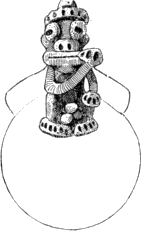 Fig. 56. |
|
| Grotesque figures forming the handles of small vases—terra cotta group. | |
The figures are usually placed upon the shoulder of the vessel or are attached to the legs and handles or form part of them. The favorite subjects are doleful little figures, human or partly so, fixed upon the vessel in a sitting posture, with legs and arms doubled up, 63 and with expressions which appear to indicate a variety of exaggerated emotions (Figs. 54, 55, 56).
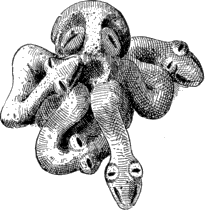 Fig. 57. |
 Fig. 58. |
| Monstrous figures, with serpent-shaped extremities—handled group. | |
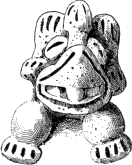 Fig. 59. |
 Fig. 61. |
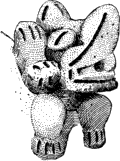 Fig. 60. |
| Grotesque figures—terra cotta group. | ||
Fig. 62. Figure of monkey—terra cotta group
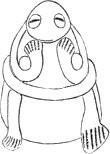 Fig. 63. |
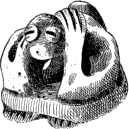 Fig. 64. |
| Figures of monkeys—terra cotta group. | |
The exuberance of fancy often found vent in the production of monstrosities, such as are seen in Figs. 57 and 58, in which the arms 64 and legs of the figures are writhing serpents, the faces expressing great agony; in other cases the figures are double; and again two bodies united at the waist have but one pair of legs. An unusually grotesque creature is seen in Figs. 59 and 60, and another is given in Fig. 61. Similar figures are worked in gold, one of which is now worn as a charm by Mr. J. B. Stearns. Figures of monkeys are shown in Figs. 62, 63, and 64. One creature, represented as having a long, trunk-like snout, recurs frequently. Such a form discovered in the earlier days of archæologic investigation would probably have given 65 rise to many surmises as to the contemporaneous existence of man and the elephant in Chiriqui. In reality the original was probably some unassuming little inhabitant of the isthmian jungles. This creature is shown in profile in Fig. 65, a, and front views are given in b and c. Innumerable examples, embracing most of the more important animals of Chiriqui, could be given, but in a majority of cases identification is difficult or impossible, as there has been little or no effort to reproduce nature with fidelity. But the chief interest surrounding these figures is not found in the variety of creatures shown or in the character of the delineation, but in the manner of their employment in the embellishment of ceramic forms. The ancient potter must have possessed a keen sense of grace of form and of the proper adjustment of parts. The most cultured taste could hardly improve upon the lines of the vases presented in Figs. 66 and 67, which employ the frog, and in Figs. 68 and 69, in which other creatures are used. Many equally pleasing examples are illustrated further on. The 66 question very naturally arises as to whether these little figures had any meaning or performed any function aside from that of simple decoration. I feel inclined to take the view that in their present condition they are survivals of ideographic originals; that if their past could be unveiled we would find that in the primitive ages they were not exclusively employed for ornament. The animals made use of originally were the embodiment of mythologic conceptions, and their images were revered or served as fetiches or charms, and because of this they came to have a permanent place in art. They were applied to the vessel because its office had reference to them or because they were thought to have a beneficial effect upon its functions. It is evident that their employment was governed by well established rules and that they occupied places and occurred in numbers and relations not wholly dependent upon the judgment of the individual potter. We may suppose that they occur in twos because the handles with which they were associated occurred in twos; or, if they serve to take the place of the extremities of the animal forms in the semblance of which the vases were originally modeled, their positions may be related to the original positions of the heads and tails of those forms. It is not improbable that the conventional incised and relieved ornaments, the meanders, nodes, and varied marks refer also to the creatures or the markings of the creatures with which the vessel was associated.
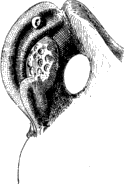 a |
 b |
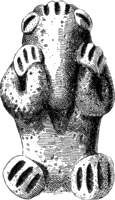 c |
| Fig. 65. Animal forms exhibiting a long proboscis—handled group. | ||
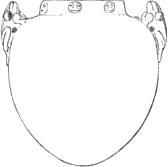 Fig. 66. |
 Fig. 67. |
| Vases illustrating ornamental use of animal figures—terra cotta group. | |
It will be seen, from the above remarks, that we cannot fully determine to what extent these ancient decorators followed the traditional pathways of early ideographic usage or how much they were governed by those powers of esthetic discrimination known to us as taste.
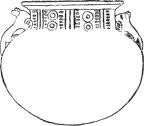 Fig. 68. |
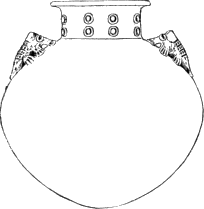 Fig. 69. |
| Vases illustrating ornamental use of animal figures—terra cotta group. | |
UNPAINTED WARE.
For convenience of description I separate the pottery of Chiriqui 67 into two grand divisions: the unpainted ware and the painted ware. Two important groups come under the first head. The first of these, the terra cotta or biscuit ware, comprises a larger number of pieces than any other group and is readily distinguished by its colors, which include only the pale grayish yellow and reddish tints of the burned clay. The second is limited to a small number of pieces and is black or very dark upon the surface and dark within the mass.
The terra cotta group.—
This biscuit-like pottery is not in any way inferior to the painted varieties. It bears evidence of great freedom in handling, and serves, perhaps better than any other class of products, to illustrate the masterly skill and the refined taste of the ancient potter. It is said to occur in the same cemeteries and in the same graves with the more important varieties of painted ware. The function of these handsome vessels cannot be determined. It can hardly have been of a domestic nature, as they show no evidences of discoloration or wear, and we are left to speculate upon the possibility of a purely ceremonial use. The paste is moderately fine, but contains an extremely large share of gritty sand; the slip is thin and has received but a slight degree of polish, so that the surface has a dead, somewhat granular effect. As a rule the vases are of small size and are very thin walled. The forms are symmetrical and exceptionally graceful. The ornamentation includes incised figures (mostly geometric), raised decoration (of similar character), and animal forms in the round. The following illustrations are intended to epitomize the multitude of forms, as anything like a complete representation is out of the question.
Fig. 70. Series of bowls and cups of unpainted ware.
Bowls, which form a leading feature of the pottery of most primitive peoples, are here rarely seen, excepting as mounted upon tripods or annular bases. There are in the collection a number of small cups of hemispherical shape that may have served as spoons, ladles, or drinking vessels. A few of these are outlined in Fig. 70. Two have minute projections resembling handles affixed to the rim. In rare cases these are so prolonged as to be of service in handling the cup; but in no instance is there an approach to the long cylindrical handles seen in the earthenware of other districts.
68Fig. 71. Vase of graceful form—½.
Fig. 72. Vase of graceful form—½.
Fig. 73. Vase of fine form, ornamented with grotesque heads—½.
In following the form scale upward from these simple shapes we find the orifice becoming more constricted and the neck more pronounced. The margins are upright, incurved, or flaring, and give variety and grace to the outlines. A tendency toward elaboration 69 of ornament accompanies the development of form. Bands of incised or relieved figures are carried around the neck, shoulder, and handles and are added in such a way as greatly to enhance the beauty of the vessel. The forms of these vessels are so graceful and the finish is so perfect that one is tempted to present an extended series, but it will be necessary to confine the illustrations to a limited number of type specimens. Fig. 71 shows a somewhat shallow form of great simplicity and grace. That in Fig. 72 is deeper, with a narrow neck and a more decidedly conical shape. Two minute grotesque figures are perched upon the shoulder. Fig. 73 represents a larger vessel of good form, which has a neat incised pattern encircling the slightly incurved neck. Grotesque heads are set upon the shoulder. A form somewhat more refined is shown in Fig. 74. The neck is furnished with a relieved ornament, consisting of a meandered and indented fillet, 70 accompanied by two rows of minute indented nodes. The heads are probably intended to represent the armadillo. They are hollow and contain movable pellets. The fillet ornaments are always tastefully treated, and in many cases represent twisted and plaited cords. Some are marked in herring bone fashion and others have transverse indentations. Small pellets of clay were much used and to excellent advantage. They were set on lightly with the fingers and firmly pressed down with minute pointed or edged tools and hollow straws or reeds (Figs. 75 and 76). Some of these nodes are finished to represent the heads of animals. This is done with an ease and a simplicity that call forth our admiration (Fig. 77).
Fig. 74. Vase of fine form, ornamented with grotesque heads—½.
Fig. 75. Vase with ornaments of applied nodes and fillets—½.
Fig. 76. Vase with mantle covered with incised figures—½.
Fig. 77. Vase with frieze of grotesque heads—½.
Fig. 78 illustrates a series of vases having flaring rims, the treatment 71 otherwise being uniform with the preceding. We notice in these vessels a decided tendency towards complexity of outline. Three examples, shown in Fig. 79, have a two storied character, the upper part possibly being the outgrowth of the collar ornament seen in so many cases. The large specimen in the center is a handsome piece with square offset at the shoulder and a decidedly conical base. A chaste ornament in relief encircles the neck and two grotesque figures are seated upon opposite sides of the shoulder. The vase at the left has two orifices, set wide apart. The body is oblong and slightly flattened above. There are a number of vessels of this conformation in the collection, some of which have the mouths so close together that the margins or lips coalesce in part. A superb specimen of this class is illustrated in Fig. 80. The shape is thoroughly satisfactory to the eye, having a refinement of line rarely attained in native American work. Its symmetry suggests the use of the wheel, but the closest examination fails to detect a trace of mechanical appliance, save that left by the polishing stone. The decoration is simple and effective, consisting of minute nodes with annular indentations about the necks and of two grotesque figures, placed with consummate taste in the angles formed by the contact of the two necks.
Fig. 78. Vases with flaring rims and varied ornament—⅕.
Fig. 79. Vases with complex outlines and varied ornament—⅓.
Fig. 80. Large vase with two mouths and neatly decorated necks—½.
A very small percentage of these vessels possess true handles, but 72 these, in some of the examples, are worthy of high admiration. The specimen presented in Fig. 81 attracts attention at once on account of its resemblance to well known classic forms. It is evident, from a study of this piece, that only a step more was necessary to place 73 these potters alongside of the highest masters of the art. The sharp high elbow and the broadening of the handles at their junction with the lip are notable features. The latter is shown more satisfactorily in Fig. 82, which is a top view of a companion piece. I wish to call attention here to a peculiar feature of these handles and one repeated in vessels of other classes. At the elbow of each handle we find a device in relief marked with herring bone indentations that would seem to represent a kind of textile attachment, as if, at some previous time and perhaps in an antecedent form of vessel, the upright and horizontal parts of the handles had been stitched or tied together at this point. Yet it is by no means certain that this feature is not the survival of some feature of an animal form into the semblance of 74 which, as seen in other examples, this feature has a tendency to graduate.
Fig. 81. Large vase with high handles—⅓.
Fig. 82. Top view of high handled vase—⅓.
These vessels are not numerous, but acquire importance from their large size, the larger being upwards of eight inches in height. A few pieces of nearly identical shape, but of small size, are found among the painted wares. Additional shapes are given in Figs. 83, 84, and 85, and serve to illustrate the extent of variation exhibited in this group of vases. The small shallow piece is exceptionally fine and the handles are furnished with animal features of a highly conventional type. An expansion of the handles somewhat similar to this is frequently seen in vessels of other classes, especially in those of the handled group.
 Fig. 83. |
|
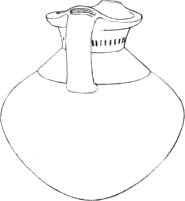 Fig. 84. |
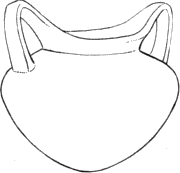 Fig. 85. |
| Examples of handled vases—½. | |
Single handles of like character occur in a number of cases upon minute cups, an example of which is given in Fig. 86. It would seem that possibly in such cases the rim had been expanded and prolonged for the purpose of giving support to the animal figures with which the shoulders were embellished. The expansion is probably the outgrowth of the use of animal figures in connection with simple handles.
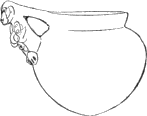 Fig. 86. |
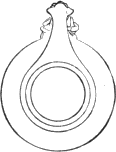 Fig. 87. |
| Small cup with single handle ornamented with grotesque figure—½. | |
We have a number of vessels of this group the bodies of which imitate animal forms, but they are in nearly all cases furnished with 75 legs. Rarely we meet with compound or eccentric forms. An interesting specimen of the latter class is seen in Fig. 88. Such shapes are common in Peru and are occasionally met with in Central America. The two strong handles are decorated with minute images of birds and the bottom is concave, an exceptional character in Chiriquian work.
Fig. 88. Vase of eccentric form—½.
The illustration of this group of vessels would not be complete without a series of tripod vases. In shape of body these vases differ but little from the legless forms already given, excepting where the use of life forms has led to eccentric modifications. Very great interest attaches to the modeling of the tripod supports, upon which the potters have expended much time and ingenuity.
 Fig. 89. |
 Fig. 90. |
 Fig. 91. |
| Vessels illustrating forms of legs—½. | Vessel with large legs ornamented with stellar punctures—½. | |
The illustrations given herewith are chosen from a great number of examples and are intended to convey an idea of the range of forms, both of the vessels and of their supports. Figs. 89 and 90 show plain forms of legs, all of which are hollow and contain small pellets of clay. The openings are generally wide vertical slits, and are placed in front, as seen in Fig. 89, or in the side, as in Fig. 90; but in exceptional cases they take other shapes and are scattered over the surface, as seen in Fig. 91. The legs are often remarkable in form, being swollen to an enormous size above and terminating in small rounded points 76 below. The bowls are symmetrically shaped and graceful in outline. In Fig. 92 I present a group illustrating some of the more eccentric forms of bowls and a variety of their supports. A very superior piece and one of the largest of this style is shown in Fig. 93.
Fig. 92. Vases of varied form with plain and with animal shaped legs—⅓.
Fig. 93. Large vase of striking shape—½.
Fig. 94. Cup with legs imitating animal forms—½.
It will be seen that in a number of cases the legs are modeled to represent animal forms. This feature is brought out more clearly in succeeding figures. The creatures represented are often grotesque, as seen in Figs. 94 and 95. The human form is rarely shown in a way to make it clearly distinguishable from the figures of monkeys and other animals. The armadillo is a favorite subject. An example of 77 small dimensions is illustrated in Fig. 96, in which this animal is given in characteristic style, and a more pretentious piece is shown in Fig. 97. The characteristics of the creature are very simply but graphically expressed. In the first the hard ribbed and figured case is represented by applied fillets and nodes, and in the other by incised lines. The frog is also much used (Fig. 98). A rather remarkable conception is illustrated in Fig. 99. Upon the front of each leg is a curious little animal-like figure, to the front of which are bound two minute infantile creatures. In the piece presented in Fig. 100, the 78 legs are grotesque heads, inverted, with wide open mouths and glaring eyes. The work upon this vase is very superior.
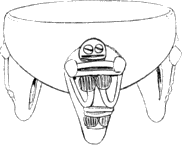 Fig. 95. |
 Fig. 96. |
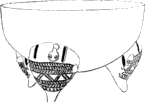 Fig. 97. |
| Cup with legs imitating a grotesque animal form—½. | Cups with legs imitating the armadillo—½. | |
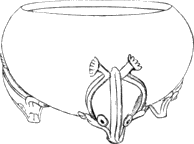 |
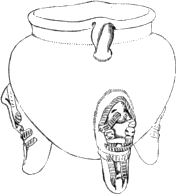 |
| Fig. 98. Cup with frog shaped legs—½. | Fig. 99. Cup with legs imitating an animal and its young—½. |
Fig. 100. Cup supported by grotesque heads—½.
The remarkable specimen illustrated in Fig. 101 is furnished with unique supports. Two rudely modeled, semihuman, grotesque figures are affixed to the under surface of the bowl, supporting it with their backs.
Fig. 101. Large cup supported by two grotesque figures—⅓.
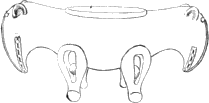 |
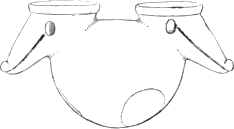 |
| Fig. 102. Cup with two animal heads attached to the sides—¼. | Fig. 103. Cup with two animal heads attached to the sides—¼. |
The legs of these figures are spread out horizontally, so that a firm support is obtained. The periphery of the body of this vessel is encircled by a number of nodes and noded projections, which represent the heads, tails, and spines of two crab-like animals. The heads, with arms attached, appear at the right and left, and the tails occur at the front and back just over the heads of the supporting figures. The use of the crab in this way is quite common. Fish, birds, and a variety of quadrupeds are similarly treated. Some very interesting examples of double headed animal vases are found. Two of these are outlined in Figs. 102 and 103, the first having a single orifice and the 79 second a pair of orifices. In many cases the bowl of the vessel is considerably modified, to give a more decided resemblance to the body of the creature. This is well shown in Figs. 104-106. The first is probably intended for a bird: the second resembles an armadillo; and the third portrays a creature with ears and three horns. The oblong vessel shown in Fig. 107 is modeled after a curious fish, 80 to which the Chiriquians seem to have attached considerable importance. It is represented with a wide mouth displaying teeth, two spines or horns upon the end of the snout, and fins upon the back and sides. Fig. 108 gives the top view of another fish vase, which is supported, as are the others, by three legs. The body is flat and is encircled by well modeled fins. The head is rather flat and has the eyes and nose on the upper surface. I close this series of illustrations with an outline of a fine vase (Fig. 109) the rim of which is decorated with a single head of extremely grotesque and repulsive character.
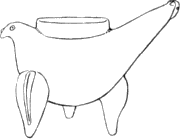 |
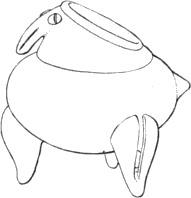 |
| Fig. 104. Vase imitating an animal form—⅓. | Fig. 105. Vase imitating an animal form—⅓. |
Fig. 106. Vase shaped to imitate an animal form—⅓.
Fig. 107. Fish shaped vessel—⅓.
Fig. 108. Top view of a fish shaped vessel—⅓.
Fig. 109. Cup with grotesque head attached to the rim—½.
Black incised group.—
This pottery, although closely related to the other varieties in its leading features, presents differences of a pronounced character. The number of specimens recovered is rather small. The largest piece has a capacity of perhaps a quart. Some of the forms are identical with those of other groups, but a few are peculiar to this ware. The color is black, brown, or dark gray, and in most cases the entire mass is quite dark. The decoration is executed in two somewhat distinct styles: in one the lines were scratched or engraved subsequently to the hardening of the clay; in the other 81 they were deeply engraved with a sharp point while the clay was still moist. The lines are usually very deep and are filled with a white substance which renders the pattern distinctly visible upon the surface. It seems probable that the lines were engraved deeply with the intention of producing this effect. Type specimens are shown in Figs. 110 and 111. They are small globular bottles, with short necks and wide apertures and with handles placed at opposite sides of the lip, which is prolonged to meet them. The design covers a large part of the body and is separated into two parts by the handles and the undecorated panels that descend from them. The figures appear to be very highly conventionalized animal forms, probably serpents. The coiled ends of the ribbon-like dotted bands are evidently meant to suggest the heads of reptiles. The figures assume a variety of shapes and grade by degrees from the recognizable life forms into purely geometric patterns. Examples of the latter style are given in Figs. 112 and 82 113. The motives employed, although so conventionally treated, are pretty certainly identical in origin with the preceding.
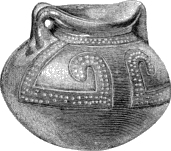 Fig. 110. |
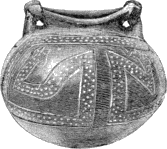 Fig. 111. |
| Black cups with incised reptilian figures—½. | |
Fig. 112. Black vase with conventional incised pattern—½.
 |
 |
| Fig. 113. Small cup with conventional incised patterns—½. | Fig. 114. Small tripod cup with upright walls and legs imitating animal heads—½. |
There are a number of tripods in this group, some of which have the deeply incised ornaments and others the shallow ones. The shapes vary greatly, a few examples being decidedly Costa Rican in type. Pieces with round bodies have conical legs, like much of the Chiriquian ware, but those with shallow basins and angular, incurved, upright, or flaring rims have the Costa Rican tripod. Figs. 114 and 115 may serve to illustrate this variety. The first is a cup, with upright sides and thick rim, having an incised geometric pattern. The second is much more striking in appearance. The surface color is brownish gray in hue and the simple geometric design was scratched through into the lighter color beneath after the clay hardened. The legs represent the heads of animals conventionally treated and are hollow, containing movable pellets. This specimen is from latitude 8° 42´ north, longitude 82° 52´ west. Others of this class come from different parts of the province.
Fig. 115. Vase with flaring rim and legs, imitating animal heads—½.
To this class belongs also a small dark vase of peculiar shape and interesting decoration, which is illustrated in Fig. 116. The neck is large and the lip widely flaring, and the body is modeled in imitation 83 of the head of some animal, possibly a peccary. The side representing the face is prolonged, giving an unsymmetric profile, as seen in the second figure. The eyes are set midway between the ears (which are placed at the sides) and the nostrils, and are inclosed by curious engraved figures, probably suggested by the markings of the animal portrayed. An arched ridge, representing the brows, connects the bridge of the nose with the ears. The most novel feature of this piece is the band of incised ornament that crosses the back of the head and serves probably to carry out the idea of the complete creature. As will be seen by reference to the figure, it is a guilloche-like interlacing of fillets, bordered and apparently held in place by longitudinal bands, beyond which the angles of the ornament project. The pattern is a modified form of one commonly seen upon the margins of the larger stone metates, and, although rarely met with in the pottery of Chiriqui, was a favorite motive with the potters of Costa Rica. This vessel comes from 30 miles north-northwest of David.
Fig. 116. Vase modeled to resemble the head of an animal—½.
Fig. 117. Pattern upon the back of the vase presented in Fig. 116.
The unpainted wares here so briefly described are typically Chiriquian, and are closely associated in the graves with most of the leading groups of art products of the province. It must be allowed that 84 they take first rank in the isthmian states, if not in America, for simplicity and refinement of form, perfection of method, and purity of style.
PAINTED WARE.
The painted vases of Chiriqui embrace at least ten easily distinguished varieties of ware. The characters upon which the classification is based are somewhat heterogeneous and include material, color, shape, finish, ornamentation, method of manufacture, and evidences of use. No single character and no one group of characters can be relied upon to distinguish the different groups. We must depend, therefore, upon an assemblage of characters or upon one character in one place and another in another place. Observing a number of striking differences in two groups of ware, we arrive at the conclusion that these groups must have been the work of distinct communities; yet we find very marked differences in wares that (through the possession in common of some particular feature) we know to be the work of the same hands. We can, therefore, determine little in regard to the peoples concerned.
I do not consider the presence in a single grave of two or more varieties sufficient proof of their common origin, for a number of distinct wares may come into the possession of one community through trade, conquest, or the spoliation of tombs; but a constant recurrence together of the same forms affords strong evidence that the objects were the work of the people with whom they were buried. Unfortunately our observations in the field are not sufficiently accurate to enable us to utilize associations or methods of occurrence in the graves as a means of classification.
The following classification is, under the circumstances, the best that I can devise, and is of use mainly as a means of facilitating description. The name chosen generally indicates a leading or striking characteristic of the group.
The scarified group, separated widely from all other varieties.
The handled group and
The tripod group, apparently the work of one community and devoted to the same or similar uses.
The maroon group;
The red line group;
The white line group;
The lost color group;
The alligator group; and
The polychrome group, no two of which are sufficiently alike to make it certain, without extraneous evidence, that they were manufactured by the same community, yet all clearly belonging to one great family.
These groups are presented in the order given.
85Before proceeding with the descriptions, however, there are some matters of a general nature that should be referred to. Technical questions have already received considerable attention, and I shall need only to refer here to the painted ornamentation, and at sufficient length to insure a clear understanding of its treatment and the scope of its subject matter.
Painted vessels are embellished to some extent also by incising and modeling, and these methods are employed very much as in the unpainted pottery already described.
Painted decoration is executed with much freedom and in many cases with considerable skill. It is greatly varied in method of treatment and embraces a wide range of motives. Geometric patterns occur in great variety, but are found to be of types peculiar to Isthmian America. The conventional meanders, frets, and scrolls so extensively employed in other regions are here almost unknown. Decorative motives derived from natural forms are abundant and afford an excellent opportunity to study the processes of conventional modification. These designs are often applied in a way to indicate that the decorator possessed a keen sense of the requirements of the vessel, although the treatment perhaps is not as universally satisfactory as is the treatment of plastic embellishment.
The potter, in preparing the vessel for the decorator, ordinarily finished it with a slip or wash of fine clay, which varied in hue from a gray white to a pale orange. A slip of bright red tint was also extensively used. The more delicate hues formed an excellent ground upon which to work. The slip covered surface was generally polished, often to a high degree, with the usual polishing implements, the marks of which can be seen upon the less carefully finished surfaces. By observers unacquainted with aboriginal methods this polish is liable to be taken for a glaze, and it has been pronounced a vitreous glaze by a few writers. It is more noticeable upon specimens that have been handled a great deal, as is the case with whistles, needlecases, and the like.
The colors utilized in decoration, so far as they have been preserved, are the ground tints, described above, and the delineating colors, the latter consisting of black, white, red in various hues, and a dull purple. An additional color (or perhaps a solution without particular color) extensively employed in the designs has totally disappeared. The nature of the various colors has not been determined, but it is probable that some were of mineral and others of vegetal origin.
Red was often employed as a ground color, as stated above, and sometimes covered the whole surface, but more frequently occupied zones or panels. In such use it was applied and polished down with the slip. Red was also extensively used in the delineation of decorative figures in several of the groups of ware, and is in all cases a permanent color. The hues vary decidedly with the groups of products, 86 suggesting differences in people or in environment. White may have been freely used, but it is preserved in a few cases only, in which it was used in the production of simple decorative patterns, and appears to have been a somewhat thick or pasty color. Black was extensively used and was of two distinct kinds: a thick permanent pigment, employed in the delineation of designs, and a thin color, not so permanent and employed exclusively as a ground upon which to execute designs in other mediums. The latter may possibly be of vegetal derivation. Its use was confined to a single variety of ware, the lost color group. The former was employed in all the other groups, with one exception, the red line group.
The light purple tint is but sparingly used and only in the polychrome group. It is very effective in combination with the reds and blacks upon the orange ground of this ware. It is probably of a mineral nature.
What I have denominated the lost color was a pigment, or “taking out” solution, extensively and exclusively employed in the decoration of one of the principal groups of ware. Its former existence is made known by its action upon the ground colors and upon the paste or slip within the areas covered by it. Where superimposed upon black, that color has in all cases been removed, exposing the underlying tints of the slip in which the designs are now manifested, the interspaces being still black. In some cases the lost color has not only removed the black ground, but has affected the slip beneath, removing it also, and to such a degree that the polished surface is destroyed and shallow intaglio lines occur, leaving the interspaces in relief. This circumstance enforces the idea that possibly the “lost color” was really not a color at all, but an acid which acted upon the ground colors at once, destroying the black entirely and leaving the effect now seen. This point must remain for the present undetermined.
The figures in all cases appear to have been delineated with ordinary brushes and by purely free hand methods. The degree of skill varies greatly. The execution in the great body of the work is rather inferior and indicates a lack of skill and care, but in a limited number of pieces the manipulation is masterly.
The designs are confined to the show spaces, being exterior in narrow necked vessels and generally interior in shallow forms.
In arrangement upon the surfaces this decoration presents some novel features. The slight degree of uniformity in arrangement indicates the absence of any mechanical aid, such as the wheel, which device would tend to reduce all decoration to a series of horizontal zones. We observe indeed the occurrence of horizontal arrangements, but not to a degree greater than would naturally arise as a result of the conformation of the vessel. Upright, oblique, and arched arrangements are frequently met with, and all are safely attributable to the domination of spaces to be covered or to the influence of antecedent 87 shapes. Examples and details are given as they come up in the various sections.
The scarified group.—
This group is represented by about forty specimens and is worthy of especial attention. It comes from the graves of two localities, one near C. E. Taylor’s hacienda, north of David, on the slopes of Mount Chiriqui, and the other at Alanje, southwest of David. As a variety of ware it stands so entirely alone that had it arrived unlabeled no one would have recognized its affinities with Chiriquian art. It is rather inferior in material, grace of form, and surface finish, and the decoration appears to belong to a lower grade of culture than that of the other groups. It is possibly the work of an inferior race in comparatively recent times.
Nearly all the vessels are tripods, but a few have rounded or flat bottoms and a few are supplied with annular stands. The walls are thick and the shapes are uncouth or clumsy. The paste is coarse, poorly baked, and friable; near the surface it is a warm reddish or yellowish gray; within the mass it is a dark gray.
The makers of this pottery, like their brother artificers, took especial pleasure in the modeling of life forms. The work exhibited in these specimens is, however, exceptionally rude. In some cases grotesque heads are attached to the rims of bowls; in others the head, tail, and 88 feet of animals appear about the periphery of the vase; and in a number of cases the legs of the tripods are modeled to represent the forms of living creatures. Generally the feet are clumsy in shape and three toed, suggesting the feet of the tapir.
These vessels are embellished by painting, incising, or scarifying and by modeling in relief. Color was not employed in the production of designs, but a dark Indian red pigment was daubed over that part of the surface not occupied by incised ornament. Little or no slip was used and the rude geometric patterns were executed with pointed tools in a very haphazard manner.
Fig. 118. Tripod bowl of red scarified ware—⅓.
Fig. 119. Tripod bowl of red scarified ware—⅓.
The bowls are more numerous than in any other group of the Chiriquian ware, but, as in the other groups, they are supplied with supports, either tripods, shaped like the feet of quadrupeds, or rude annular bases. In most cases the rim expands gradually from below, as seen in Fig. 118, or is recurved, as shown in Fig. 119. In a few cases the basin is oblong or boat shaped and the ends are pointed, as indicated in Fig. 120.
Fig. 120. Oblong basin with scarified design—⅓.
89An interesting specimen is illustrated in Fig. 121. At the opposite ends of the bowl portions of the rim are carried upward and inward, forming handle-like appendages, modeled to represent, rudely, the heads of animals. Details of form and ornament are well brought out in the cut.
Fig. 121. Large bowl with handles imitating animal heads—⅓.
In Fig. 122 we have a high cylindrical shape with a flat bottom, the surface being scarified in vertical bands. A small pot, having an annular base and decoration similar to the preceding, is given in Fig. 123. In Fig. 124, instead of the vertical lines, we have a series of heavy ribs. Two strong vertically placed loops are fixed upon opposite sides of the shoulder and the base is supplied with the usual feet.
Fig. 122. Jar with flat bottom and vertical bands of incised ornament—⅓.
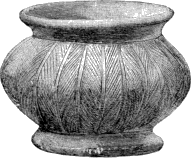 |
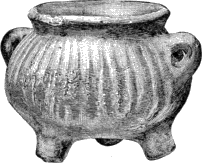 |
| Fig. 123. Vase with stand and vertical incised bands—⅓. | Fig. 124. Vase with handles, legs, and vertical ribs—⅓. |
The tripods shown in Figs. 125 and 126 are somewhat mutilated, but they present features of interest in the novel shapes and the unique 90 animal forms with which the legs are embellished. Each leg is represented as a complete animal, whose back or breast supports the vessel and whose cylindrical nether extremity rests upon the ground. The head in the first example resembles an owl and in the second reminds one of some crustacean form. An additional specimen of considerable interest is shown in Fig. 127. It is a heavy tripod, having four independent mouths, all opening into one chamber. The shape is unsatisfactory, being heavy and unsymmetrical. The exterior surface has the usual scarified figures and the interspaces and the entire inner surface of the vessel are painted red and rather carefully polished.
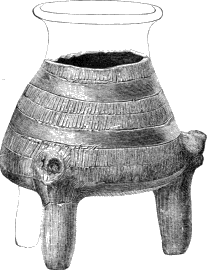 |
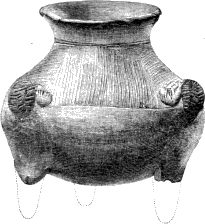 |
| Fig. 125. Tripod with owl-like heads at insertion of legs—⅓. | Fig. 126. Tripod with legs rudely suggesting animal forms—⅓. |
Fig. 127. Heavy red vase with four mouths—⅓.
The handled group.—
The series of vessels to which this name is given comprises a large number of pieces of unusually even characters. 91 They are obtained from a pretty wide district to the north and west of David and occur in connection with other groups. They are notable for uniformity in size, shape, and finish and for the unmistakable evidences of use over fire which at least three-fourths of them show. With the exception of a few large caldrons, not yet assigned to a particular group, they are more like ordinary cooking vessels than any other group of Chiriquian ware. The size, however, is remarkably small, the average capacity being about a pint. Larger pieces contain a quart or three pints.
The body is usually much compressed vertically and is flattish above and more or less conical below, giving a very graceful contour. The surface is rather rudely polished and the painting is done with notable carelessness, as if the intended use were not favorable to the preservation of the ornament. By means of a heavy brush, red figures, consisting of splotches, stripes, arches, and encircling bands, were applied to the yellowish gray surface and sometimes, as indicated by a smeared appearance, were polished down with an implement. It does not seem that a slip of ordinary white clay was very generally used. In a few cases a grayish blue tint appears upon some of the wider spaces.
The handles are perhaps the most notable feature of this ware, and usually occur two to a vessel; rarely there is but one handle and in a few cases there are four. This group may be separated into at least four sections by the styles of handles. Vessels of the two more important sections have two handles each, which are placed vertically in one variety and horizontally in the other, reference being had to the position of the points of attachment. These differences of position have given rise to a marked difference in the shape of the orifice and of the lip. The handle is a simple loop, which in the one variety is placed as seen in Fig. 128 and in the other as in Fig. 132. In the latter case one end of the loop is fixed to the shoulder and the other end 92 to the lip, which is uniformly prolonged at the contact and is also widened all around; the result is the curious winged outline shown in Fig. 133.
Fig. 128. Vase with horizontally placed handles and rude designs in red—½.
A third variety of handle is a single arch, which spans the orifice and is attached to opposite sides of the expanded lip. In a fourth variety the looped handles are replaced by the heads of animals, which are set upon the shoulder of the vase, as are similar features in other groups of ware.
Fig. 129. Unpolished vase with heavy handles and coated with soot—½.
A type specimen with the horizontal loop is shown in Fig. 128. The lip and a wide belt about the body are painted red and the shoulder is occupied by rudely executed arched strokes of the same color. A much less usual shape is given in Fig. 129, which exhibits some characters of contour that remind us of well known Grecian forms. Another novel variation from the type is seen in Fig. 130, in which the arch of each loop is divided by an upright piece. A neat incised ornament occupies the shoulder of this vessel and the remainder of the body is finished in pale red.
Fig. 130. Round bodied red vase with unique handles and incised ornament—½.
93It will be observed that the handles are rarely wholly plain. Each loop is supplied with one or more rings or ring-like fillets, or with small nodes, generally near the most prominent part of the curve or arch. By the study of a large number of specimens I am able to trace these puzzling features to their origin. They are the representatives of life forms which were originally modeled in full detail and which are still so modeled in many cases. The nodes and like features are atrophied heads, hands, or feet, and in some cases are marked with indentations that refer to the eyes or to the fingers or toes, and the round fillets stand for the arms and legs of animals, or, if notched in peculiar ways, may be referred to other originals, such as the mouths of fishes or the spines of crabs. Examples could be given showing all stages of the progress of simplification.
Fig. 131. Vase with grotesque figures attached to the handles—½.
In Fig. 131 I present a fine example of the horizontal loop, in which the opposite ends are supported by grotesque animal figures, applied, however, in a way not detrimental to the grace and simplicity of the vessel.
Fig. 132. Vase with upright handles and winged lip—½.
An example shown in Fig. 132 is of especial interest in this connection. The ornament upon the handle serves as a link between 94 the realistic life form and the conventional nodes and fillets. In this case the node is supplied with eyes and a mouth, and the double roll of clay beneath is manifestly intended for the arms, the handle itself standing for the body. The loop is upright and joins the shoulder to the rim. The winged character produced by the expansion at the contact of handle and lip is shown to advantage in the top view (Fig. 133.) In some cases this expansion is so great as completely to hide the body of the vase when viewed from above.
Fig. 133. Top view of vase with winged lip—½.
Fig. 134. Vase with grotesque animal shaped handles—½.
Examples are outlined in Figs. 134 and 135 in which the life form is clearly defined. In the first we have a human-like figure, the face of which is entirely hidden by the hands. In the second we observe a curious little animal figure, with a long curved proboscis and a body covered with annular indentations. In general shape and in ornamentation these vases do not differ from the preceding. A remarkable 95 piece, with two pairs of handles, is presented in Fig. 136. Grotesque figures are attached to the outer surface of the loops, one in each pair being placed in an inverted position. The two figures seen in the cut are simple, but those on the opposite pair of handles are compound, being double above the waist. The faces, hands, and feet of these figures are touched with red, and the lip and body of the vase are decorated with carelessly drawn stripes of red. In another case four plain handles are placed equidistantly about the neck of the vessel.
Fig. 135. Vase with handles representing strange animals—½.
Fig. 136. Vase with two pairs of handles ornamented with grotesque figures—½.
In a third variety the loop is omitted entirely, the animal figure taking its place upon the shoulder of the vase. This feature appears 96 in the specimen given in Fig. 137 and represents the front part of a reptile, the head being hollow and containing a large movable pellet. This is a handsome piece, well finished, and decorated in the usual broad way.
Fig. 137. Vase with handles representing animal heads, which are hollow and contain pellets of clay—½.
Fig. 138. Vase with arched handles embellished with life forms in high relief—½.
A fourth variety is shown in Figs. 138 and 139, in which the handle spans the orifice as in an ordinary basket. The lip is flaring and is 97 prolonged at the sides to meet the handle. In one case the outer surface of the handle is embellished with figures of frogs and serpents, or what seem to be intended for serpents, modeled in the round and rather imperfectly attached, and in the other with a pair of grotesque human figures set against the base of each end of the handle.
Fig. 139. Vase with arched handles embellished with life forms in high relief—½.
Typical vessels of this class are in many cases mounted upon tripods, but, for convenience of description, these are classed with the succeeding group, which consists mainly, if not entirely, of the same variety of ware.
To recapitulate, the striking characteristics of this group are the uniformity of size, shape, and handles, the rude finish and ruder ornamentation, and the very marked evidence of use over fire.
The tripod group.—
Closely related in most respects to the group of ware just described is the striking series of vessels here presented. At first glance the resemblances are not apparent, but a careful study renders it clear that the vessels proper correspond closely in both groups. The basins are for the most part made in the same heavy, rudely finished style, the decoration is almost equally rude, and the size and the evidence of use over fire are the same. The strong contrast in appearance is due mainly to the presence of tripod supports in this group. The legs, which constitute such a striking feature, are merely appendages to the bodies of vases already perfect, and are evidently an acquired feature suggested by some change in function or in the habits of the people. In this way we are able to account for the 98 rather uncouth look observed in so many cases, the legs being too long and too heavy to please the cultured taste; yet in many cases the parts are so adjusted as to give an impression of firmness and strength, united with a goodly share of grace of line.
The legs are very generally modeled to represent animal forms. In a majority of cases the fish was chosen because, perhaps, its shape was suitable or because the fish bore some relation to the use to which the vessel was to be devoted. Lizards and mammals are also seen and the human form occasionally appears. In some cases the animal figure is attached to the upper part of the leg or is perched upon the hip, where that feature is pronounced. The body, or shaft, is hollow and contains pellets of clay, sometimes one only and again a dozen or more, and in order that these may be seen and heard variously shaped slits are cut in the sides or front of the legs. If the animal represented is a fish or lizard the entire body is modeled: the head is placed at the top, the under jaw or neck uniting with the body of the vessel; the tail rests upon the ground, and the fins or legs appear along the sides of the shaft. It should be observed that, while in Chiriqui the whole body of the creature is usually employed in forming the support, in Central America and Mexico the head alone is very generally used, the nose resting upon the ground. In less elaborate forms the legs are plain or have the merest hint of animal form in a node, a notched ridge, or a slightly modified extremity.
Handles are present in a majority of cases and as in the preceding group take the form of loops or represent the forms of animals. The loops are generally attached in a vertical position, connecting the shoulder with the lip of the vessel, and are plain round ropes of clay or consist of two or three cords twisted or plaited together. A few eccentric forms occur and are illustrated early in this section.
The animal shapes are often quite elaborate and appear to bear no relation to the creatures embodied in the legs of the vessel; neither does the position of the handles bear any uniform relation to the positions of the legs—another indication that the latter features are recent acquisitions, since features developed together are uniformly well adjusted.
The rim or lip is generally heavy and flaring, and the neck, which is short and pretty sharply constricted, is decorated with incised patterns and with various applied ornaments in relief. The body is graceful in outline and more or less conical below. As a rule the surface is uneven and but slightly polished and the figures in red are rudely executed, but in the more pretentious pieces much care has been exercised in finishing and painting. Most of the vessels have been used over the fire and still retain the sooty incrustations. This ware comes from a wide range of territory to the north and west of David.
The following illustrations represent some of the more important 99 pieces and serve to give a partial idea of the range of form, size, and decoration.
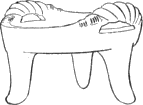 Fig. 140. |
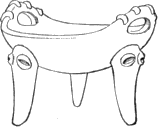 Fig. 141. |
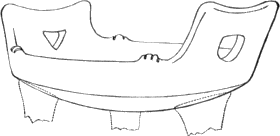 Fig. 142. |
|
| Tripod vases with shallow basins and eccentric handles—⅓. | |
I present, first, three vases of rather eccentric shapes, the basins of which are shallow and in two cases are flat bottomed. The handles are of unusual shapes, consisting of modifications of the lip, as seen in the illustrations (Figs. 140-142). Life elements are present in all cases in connection with the handles and legs where these are preserved, but they are very meager and so abbreviated as to be identified with difficulty. Incised markings at the ends of the handles represent hands or feet and eyes are affixed to the upper part of the legs. The ware is identical with that of the preceding group.
Fig. 143. Tripod vase of graceful shape and neat finish—⅓.
A representative specimen of the fish legged vessels is presented in Fig. 143. It is one of the most graceful forms in the series and is neatly finished and embellished, but is thoroughly blackened with soot. The handles are formed of twisted fillets or ropes of clay and a narrow, incised, rope-like band encircles the lower part of the neck. Set upon the neck and alternating with the handles are two scrolls neatly formed of small round ropes of clay. The fishes forming the legs are very simply treated. The mouth at the apex is formed by laying on an oblong loop of clay and the eyes are represented by two round pellets set into the soft clay of the head and indented with a slit that gives to them the exact effect of screwheads. A pair of fins—small incised or channeled cones—is placed at the sides of the head and another at the sides of the body. The cavity contains a single ball of clay and the slit is long and wide.
Fig. 144. Heavy tripod vase with widely spreading feet—⅓.
In other examples the fish form is much more elaborately modeled. 100 The wide mouth exhibits a row of teeth and the body is well supplied with fins. The head in Fig. 144 reminds one forcibly of the catfish. The snout is furnished with two horn-like appendages; tooth-like features are formed by setting in pellets of clay, and the gills are indicated by a punctured excrescence at the side of the mouth. In other cases a high, sharp cone is set upon the middle of the head (Fig. 145). It is channeled down the sides, as if meant for a fin.
101The process of modeling these heads was about as follows: The upper end of the leg—the head of the fish—was first rounded off, giving the general shape; then parallel incisions were made to represent the teeth, and around these a fillet of clay was laid, forming the lips, which were then channeled with a sharp tool. Nodes or flattened pellets of clay, representing the gills, snout, and eyes, were then laid on and finished with incision-like indentations. The handles consist of bird-like heads, with protruding eyes and long bills that curve downward and connect with the shoulder of the vase. The body is rudely spotted with red.
A large, uncouth specimen is shown in Fig. 146. The legs are ponderous and are not neatly adjusted to the vessel. A meander pattern of incised lines encircles the neck and the body is rudely decorated with broad red stripes.
Fig. 146. High tripod vase with incised designs and rude figures in red—⅓.
102There is a general consistency in the use of life forms which is worthy of notice. The fish and other creatures used, although variously conceived and treated, are never confused. When the fish is employed no features suggesting other animals appear and when the heads of other creatures occupy the upper extremity of the leg all the details refer to these creatures with uniform consistency. In Fig. 147 we have an unusually graceful shape, decorated about the neck with scrolls and indented fillets. The legs represent some reptilian form resembling a lizard. The head projects from the hip and is conventionally treated. A round fillet fixed at its middle point to the muzzle of the creature is turned back at the sides of the head and coiled to form the eyes. The forelegs are attached at the sides near the top and the recurved terminal point is encircled by rings that stand for the coiled tail.
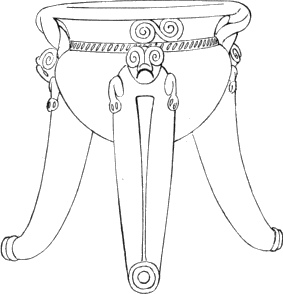 |
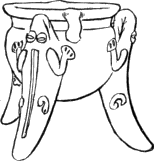 |
| Fig. 147. Handsome tripod vase with scroll ornament—⅓. | Fig. 148. Vase with lizard shaped legs—⅓. |
There is little room for doubt as to the kind of creature represented in the legs of the vase given in Fig. 148. The head, legs, and general 104 shape are characteristic of the lizard. The vessel is small, plain, and neatly finished. In Fig. 149 the legs of the vessel, otherwise quite plain, are surmounted by heads that seem to represent a dog or some like animal. A series of neat vertically placed scrolls formed of round fillets encircles the neck, and below these is a band in relief imitating a twisted cord.
Fig. 149. Vase with scroll ornament—⅓.
A vase of unusually striking appearance is presented in Fig. 150. It is one of the largest tripods in the collection and is characterized by a high widely expanded lip and a long conical body and by legs of unusual size and conformation. Small animal figures are perched upon the projecting hips. The surface of the vessel is rudely finished and is much blackened by smoke about the upper part of the legs and the body.
Fig. 150. Large vase with flaring rim and wide spreading legs—⅓.
A unique use of the animal form is illustrated in Fig. 151, which shows a large fragment of one of these tripods. The figure of an alligator, modeled with a great deal of spirit, is attached to the side of the vessel, resting partly upon the leg and extending upward obliquely to the lip. A similar figure upon the opposite side of the same vase is represented as grasping the form of a man or boy in its formidable looking jaws.
Fig. 151. Fragment of a tripod vase embellished with the figure of an alligator.
The alligator, rarely employed in this group of ware, is freely used in other groups and was probably a creature of importance in the mythology of Chiriqui.
In one case only, so far as I have seen, is the human form employed in the supports of these vessels, and in that case, as will be seen in Fig. 152, the result is extremely grotesque. The shape of the basin is good and the thick, rounded lip and most of the surface are carefully polished. A disconnected meander of incised lines encircles the rather high neck, and parts of the body and its attached features 105 are painted red. As usual this color was applied along with the slip and in polishing has become much mixed up with it, giving a mottled effect. The handles take the form of curious human-appearing figures which sit against the constricted neck, their heads supporting the rim and their feet resting upon the shoulder of the vessel. In one case the hands are held tightly against the lower part of the face and in the other they are bound together against the chin by a serpent-like cord of clay. The hollow figures forming the legs of the vase are as grotesque as could well be imagined. There is no head whatever, and the outlandish features are placed upon the front of the upper part of the body. The arms and hands take the conventional position characteristic of the statuary of the isthmian states and the only traces of costume are bands about the wrists and a girdle encircling the lower part of the body.
Fig. 152. Vase supported by grotesque human figures—⅓.
I add, in Fig. 153, one more example, a large, full bodied vase, which, more decidedly perhaps than any of the foregoing, proclaims its relationship to the preceding group. If the three rather clumsy legs were knocked off there would remain a large beautifully shaped and finished vase, with a constricted but flaring rim not in any way distinguishable from those of the preceding group. The legs in this case are less perfectly adapted to the vessel than in the other examples, as if the potter, skillful in modeling the vessel, had only recently undertaken to add the tripod. The slit in the outer face of the leg is unusually wide and the inclosed ball is three-fourths of an inch in diameter. The most remarkable feature of this vessel is the pair of unique figures affixed to the upper surface of the body near the lip, and which would seem to be intended to represent semihuman monsters. The arms and legs are contorted and serpent-like in appearance and terminate in most cases in heads of serpents instead of 106 in hands and feet. The attitude is expressive of agony or horror. It seems to me probable that, contrary to the rule in primitive art, these strange figures do not embody any well defined or serious conception, but are rather exhibitions of the fancy of the potter. They occupy small unpainted panels, which are finished in neat incised patterns. The remaining surface is a bright red.
Fig. 153. Round bodied vase embellished with figures of monsters—⅓.
It may be noted, in recapitulation, that these vases, although elaborately modeled and often well finished, are rudely decorated and very generally show use over fire; that the legs, though often graceful and well proportioned, are in many cases clumsily adjusted to the body, giving a decidedly unsatisfactory result as a whole. This ware was devoted to domestic uses, or, if otherwise, in all probability to the burning of incense. Animal forms are freely employed, but in a rather rude way. The fish form is more generally used than any other, and is in all cases embodied in the legs of the vessel, the head joining the body of the vessel and the tail resting upon the ground. These representations exhibit all grades of elaboration from the fairly well modeled to the merest suggestion of animal character—any one feature, as the mouth, the eye, the fins, or the tail, being alone a sufficient suggestion of the creature to satisfy the potter and keep alive the idea of the fish. Other animal forms are employed in modeling the legs, and exhibit equally varying degrees of elaboration, and it is 107 worthy of especial note that creatures are not confused or confounded, so far as I can discover, at any stage of the simplifying process—that a fish is still purely a fish if nothing is left to represent it but a node or an incision. There is no apparent relationship between the animal forms forming the legs and those attached to the body or to the rim of the vessel.
The pottery of the two groups already presented exhibits characters so uniform throughout that there need be no hesitation in placing them together as the work of one community and of one period of practice of the art; but between these groups and those that follow there is a wide gap. The differences are so marked that, if they had come from widely separated localities, very intimate relationships would not have been suggested.
Fig. 154. Cup with incurved rim and life form ornamentation—½.
Fig. 155. Cup with widely expanded rim and constricted neck—½.
The maroon group.—
For the want of a better name I have called the group first to be presented the maroon group, on account of its color. Our collection comprises not more than a dozen pieces of this ware. The locality from which they come is called Los Tenajos by Mr. McNiel, but he has not distinguished them in any way from the other varieties, and I am therefore unable to say whether or not they occur together with others or under identical conditions. In symmetry of outline, diversity of shape, and cleverness of modeling this ware takes a high rank, but there is no painted ornament. The surfaces are usually well polished, and all exposed parts have received a coat of purplish maroon colored paint. The paste contains a great deal of fine sand, and is yellowish upon the surface and generally quite dark within the mass. Considering the small number of pieces, the scale of form is remarkably varied. There are plain bowls with incurved rims and with flaring rims, vases with 108 round bases, with annular stands, and with tripods, and life forms wholly unique. Perhaps the most usual form is that shown in Fig. 154, which represents a small cup with incurved rim and a narrow annular base. The shoulder is embellished with three groups of small nodes, of four each, which refer to some animal form. In other similar vases the form of the creature is given in more realistic guise. A larger vase, similar to this in most respects, has a rounded contour and incurved lip. The periphery is supplied with four plain nodes. Another, shown in Fig. 155, has a wide recurved rim, a character seen to equally good advantage in some of the following figures. In the small vase represented in Fig. 156 the treatment of animal forms in connection with the body of the vessel is shown to good advantage. 109 The head, legs, and tail of what is probably intended to represent an alligator, modeled in the round, are attached to the periphery of the basin, and heads of some mammal are used for legs.
Fig. 156. Small tripod cup with animal features in high relief—½.
A most interesting tripod is shown in Fig. 157. The bowl is beautifully modeled, is symmetrical, and has a flaring rim, rounded and polished on the upper surface and drooping slightly at the outer margin. The body is hemispherical and is supported by three grotesque anthropomorphic figures that strongly remind us of the “mud head” masks used in one of the dances of the Zuñi Indians. The head is a rounded ball, upon which pellets of clay are stuck to represent the features. The arms are set against the sides of the body, as in other isthmian specimens, the hips are excessively large, the legs straight, and the feet small and united to form the foot of the vessel. Nearly the entire surface is finished in a dark purplish red paint, which appears to have been polished down as a slip. A companion piece is considerably smaller and the supporting figures are very grotesque and somewhat crouched, as if bearing a very heavy weight.
Fig. 157. Handsome vase supported by three grotesque figures—½.
A number of large basins or caldrons, collected in Chiriqui, and fragments of vessels of extraordinary size resemble this ware in material, color, and finish. The rims of the larger pieces are upwards of an inch thick and the walls are in cases three-fourths of an inch thick. A number of large vessels of similar ware now in the National Museum were collected in Costa Rica and Nicaragua.
The red line group.—
The group of vessels to which I have given this name is represented by about a dozen specimens, which indicate a wide range of form and exhibit a number of unique characters.
The localities from which they are derived extend from 8° 20´ to 8° 40´ north latitude and from 82° 40´ to 82° 50´ west longitude.
The paste is of about the usual composition, but takes a variety of tints on burning, a light gray orange prevailing. The finish of the surface is about the same as in other groups. The decoration consists of life forms and their conventional representatives in relief and of carelessly executed geometric designs, the pigment used being a bright, sienna-like red.
As will be seen by reference to the illustrations, the forms are varied and pleasing, but for the most part repeat outlines common to other groups. The handles, single or in twos, are upright loops, and the tripods are in nearly all cases looped or annular, an unusual feature in other groups.
I present three illustrations, two of which were given in outline in the introductory pages. The first (Fig. 158) has a well proportioned, somewhat globular body, supported by three legs formed of looped bands of clay. On the shoulder are two small animal forms, probably meant for frogs. The spaces between these are occupied by panel-like arrangements of red lines. The surface is yellowish gray in color, excepting where blackened in the baking. The paste has 110 cracked in firing, a feature observed in a number of pieces belonging to this group.
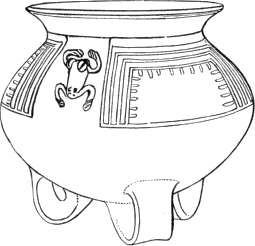 |
 |
| Fig. 158. Vase decorated with figures of frogs and devices in red—½. | Fig. 159. Vase of unique shape and life form ornamentation—½. |
A unique piece is represented in Fig. 159. The single handle is a high projecting loop and connects with the margin of the orifice, which rises to meet it, and with the lower part of the shoulder. An animal form, apparently anthropomorphic, is embodied in this vessel. The upper part of the vessel, separated by a slight constriction from the body proper, represents the head of the creature, the nose, mouth, 111 and eyes appearing on the front and the ears at the sides. A few incised lines seen upon the inner surface of the handle stand for the hair. Upon the shoulder are two sharp nodes, standing for the breasts, and between these are markings that represent a necklace. A rude design in red lines covers the upper surface of the body.
Fig. 160. Two handled vase with life form and linear decoration—½.
A graceful shape is illustrated in Fig. 160. The paste is a grayish orange on the surface and is rather dark within the thicker portions of the walls. The under surface is much blackened by use over fire. An interesting feature is seen upon the handles at the highest point of the loop. Instead of the single indented transverse fillet observed in similar forms in other groups, we have two such features, set about an inch apart, and between them are two indented nodes which stand for eyes, and a number of indentations within the space refer to other features of the animal suggested. Upon the shoulder and collar of the vessel are carelessly drawn geometric patterns in red lines.
The white line group.—
One group of vases, of which we have but four pieces, is characterized by the use of a whitish pigment in decoration. Not one of the collections that I have seen is well supplied with this class of ware, and hence little can be said of its varieties of form and ornament. All are tripods, but the shapes of the vessels vary considerably. Two small pieces are from latitude 8° 40´ north and longitude 82° 32´ west. One of these is shown in Fig. 161. They are small, rather carelessly finished tripods, with narrow necks and flattened bodies. The inner surface of the orifice and the under side of the body are painted a dull red. The remainder of the surface is a warm reddish gray, the color of the slip and the paste. The legs in the piece figured represent some small creature with a rabbit-like face and a body which tapers gradually to the base. Two feet are placed near the middle of the body, which is striped transversely with white lines. A white collar crosses the neck and the eyes are white dots. The upper surface of the vase is embellished with two animal figures, executed in a white earthy pigment. They may refer to the alligator, 112 but the drawing is too conventional to admit of full identification. The companion piece is a little larger, and the upper surface is decorated with three groups of broad white stripes, bordered by rows of dots, which extend from the base of the neck to the periphery of the body. The legs are similar to those of the other piece. The little animal figure fixed to the upper end or hip is identical with that seen in the following illustration.
The large tripod vase presented in Fig. 162 is distinct in many ways from anything in the collection and is remarkable for symmetry of form and neatness of finish. The body is a long, symmetrical cone and the legs are long, straight cylinders, neatly rounded off to a point below. A thick rim projects at a sharp angle and is rounded up toward the margin. The legs are hollow, and through two pairs of lateral slits a number of small pellets can be seen, which rattle when the vase is moved. Rudely modeled little animals, with erect ears, large feet, and conical tails, are fixed to the upper end of the legs. The ground color, the slip, and the paste are of a reddish 113 gray cast. The greater part of the surface seems to have been painted red, but the vase has been used over fire to such an extent that little of the original color remains. The body and the legs have been decorated with geometric patterns in a whitish pigment that can be scraped off like indurated clay. The little animal figures were also painted white. A vase very similar to this, from which the legs have been removed, and the surface smoothed down, has a longer and more graceful body and a similar rim. Another piece, exhibiting similar yet even more strongly marked characteristics of shape, belongs to the collection of Mr. J. B. Stearns.
Fig. 162. Shapely vase with designs in white paint—½.
The lost color group.—
In number of specimens this group is second to none, excepting perhaps that given under the head of terra cotta ware. Nine-tenths of the pieces may be classed as bottles, which have rather short, wide necks and globular bodies, slightly conical below and in cases flattened above. They range in size from one inch to nearly a foot in height, but the average capacity is not above a pint. Aside from the bottles there is a wide range of shapes. There are shallow bowls and various complex and compound forms. Animal forms are associated with all classes of vessels. Tripod supports are limited to rather modest proportions, and handles, although often present and greatly varied in style, do not constitute an important feature. These vessels are remarkably well preserved and exhibit few traces of abrasion by use or of blackening over fire. The paste is fine grained and usually of a light yellow gray tint throughout.
The surface was finished either in a light colored slip or in a strong red pigment. In some cases the light tint was used exclusively and again the red covered the entire surface, but more frequently the two were used together, occupying distinct areas of the same vessel and forming the groundwork for decorative patterns in other colors. They were usually polished down with very great care, giving a glistening surface, upon which the markings of the tool can still be seen.
I have already described the methods of decoration, but may review them briefly here. The bright red color, which forms such a prominent and pleasing feature, is, as stated above, only a ground tint and is not used in any case in the delineation of design. The actual patterns, so varied and interesting, were worked out in a pigment or fluid now totally lost, but which has left traces of its former existence through its effect upon the ground colors. In beginning the decoration, a thin black color, probably of vegetal character, was carried over the area to be treated, and upon this the figures were traced in the lost color. When this color (if it was indeed a pigment, and not merely an acid or “taking out” medium) disappeared, it carried with it the black tint beneath, exposing the light gray and red tints of the ground and leaving the interstices in black. The interstitial figures thus formed are often of such a character as to be taken for the true 114 design. In examining the decoration of this ware it is essential that this fact should be kept in mind, as otherwise great confusion will result.
The nature of the materials employed cannot be determined. Applied to the polished surface, they were easily removed. The black ground tint is now easily rubbed off and in most cases is much injured by handling or by contact with the soil. The lost color may have been similar to the white, argillaceous pigment used by the Aztecs, which has in many cases partially or wholly disappeared, leaving its marks upon the ground either by deadening the polish or by removing portions of the slip and the paste upon which it was laid, presenting the ornament in intaglio.
The designs are infinitely varied in appearance and arrangement, yet are far from having a mixed or heterogeneous character. It is probably our lack of knowledge of the origin and history of the elements and their derivations that causes confusion. Both geometric and imitative elements abound and are blended in perfectly graded series. The treatment of geometric figures is peculiar to Chiriqui and in many respects is peculiar to this group of ware. Classic forms, such as the meander, the scroll, and the fret, rarely occur and are barely recognizable. It appears from a close study of all the work that motives derived from nature have greatly leavened the whole body of decoration. This matter will receive attention as the examples are presented and will be treated with greater care in a succeeding section.
Plastic decoration, aside from the life forms so commonly associated with the body of the vase and with the handles and legs, is not of importance. The high degree of polish required in this ware tended to simplify all relieved features.
The presence of life forms in relief has produced important modifications in the appearance and the arrangement of the painted devices, and in many cases there is a manifest correlation between the plastic and the painted forms: as, for example, when the body of the vase was thought of as the body of the animal, the extremities of which were placed upon its sides, the colored figures carried out the idea of the creature by imitating in a more or less conventional way the markings of the body. This will be understood through reference to the examples presented in the following pages.
I will present, first, a series of bottles, selecting at the beginning those decorated in the more purely geometric style and gradually approaching those upon which animal forms are treated in a literal manner. The few pieces selected for illustration are totally inadequate to the proper representation of the group and must be regarded only as average specimens, more or less typical in character.
Fig. 163. Small red bottle with horizontal bands of ornament consisting of plain and scalloped lines—½.
I give first a number of examples in which the decorative devices are arranged in horizontal zones. In Fig. 163 broad bands of ornament, 115 consisting of scalloped and plain lines, encircle the neck and the body of the vessel. In finishing this piece the whole surface was painted a rich red and highly polished; then a black coat was applied, covering the body from the lip to the base of the design; and finally the delineating fluid was applied, removing the black, as shown in the narrow lines, the sharply dentate bands, and the broad, plain band between. The second example (Fig. 164) varies somewhat in shape and design, but is identical in color and manipulation. The dark figures are merely the interspaces, although they appear at first glance to have been intended for the design proper.
Fig. 164. Small red bottle with encircling geometric devices—½.
In a numerous series of vessels the decorated bands are divided into compartments or panels, often four in number, which spaces are occupied by lines and figures of greatly diversified characters. In the example shown in Fig. 165 the ground color of the principal zone is in the light yellow gray tint of the slip, the remainder being red. This lends brilliancy to the effect.
116Fig. 165. Bottle with zone occupied by geometric devices—½.
Fig. 166. Bottle with broad zone containing geometric figures—½.
In the vase shown in Fig. 166 the treatment is in a general way the same, but the compartments are triangular and are separated by lines that form a disconnected meander. An additional example is given in Fig. 167. Here the principal zone is expanded to cover the whole upper surface of the vase, which was finished in the light colored slip to receive it. The principal lines are arranged to give the effect of rays when viewed from above, but as seen in the cut they give the effect of a carelessly connected meander. The groups of lines are 117 bordered by series of dots. A great number of pieces are painted in this style. The effect is varied by altering the shape of the interspaces or by modifying the number and relationship of the lines, dots, and figures.
Fig. 167. Bottle with decoration of meandered lines—½.
Fig. 168. Bottle with arched panels and geometric devices—½.
Somewhat similar also in general effect to the last example is the work upon another important series of vases. Instead of the simple meandered or zigzag arrangement of parts, two of the dividing lines of the zone run tangent to the neck of the vase on opposite sides, forming arched panels and leaving upright panels between. 118 In the example presented in Fig. 168 the arched areas are filled in with lattice-like arrangements of lines. In others we have dots, checkers, and varied geometric combinations, and in very many cases the figures are derived from life forms. The same may be said of the devices that occupy the spaces between the arches. The piece shown in Fig. 169 exhibits a somewhat more elaborate treatment, but the motives and arrangements are much the same. These vessels are peculiar in the treatment of the ground. The entire surface is red, with the exception of narrow bands of light ground color, which outline the arches and encircle the periphery. In other cases these bands are red, the remainder of the ground being light. Series of lines are drawn from the lower border of the zone to the center of the base of the body.
Fig. 169. Bottle with arched panels and elaborate devices—½.
 |
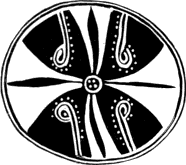 |
| Fig. 170. Vase with rosette-like panels—½. | Fig. 170a. Ornament from vase shown in Fig. 170. |
In a small group of vases we have a radiate ornament within the arches and in a few cases the arched lines are continued down around the base of the vessel, forming vertical circles in which rosette-like designs are formed by repeating the radiate figures in an inverted 119 position below the peripheral line. The elaboration in these circular inclosures is very remarkable, as will be seen by reference to the three examples given in Figs. 170, 171, and 172. In the first case the peripheral line is a red band nearly one-half an inch wide and the rays appear in groups above and below it. Within the four broader black rays (Fig. 170a), which are the interspaces or remnants of the ground, groups of lines have been drawn, in most cases curved at the inner ends like an opening frond and accompanied in all cases by series of dots. An examination of a number of vessels shows various degrees of convention. It is clear, however, that these devices, showing curves, hooks, and dots, are not of technical or mechanical origin, but that they refer to delineative originals of which they are survivals; but we must remain in the dark as to what the originals were or what was the precise nature of the idea associated with them in the mind of the decorator. Another question refers to the arrangement of the parts of the design in the five preceding figures. The distribution of the designs is a matter of great interest, and much may be learned from a close study of these specimens.
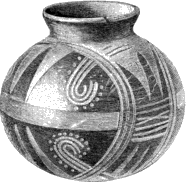 |
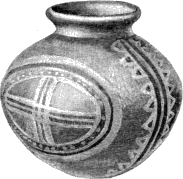 |
| Fig. 171. Vase with rosette-like panels—½. | Fig. 172. Vase with rosette-like panels—½. |
Horizontal zones appear in the ceramic decoration of all countries, and result, no doubt, from technical causes; but the division of zones into compartments of peculiar shape is due to other influences. I believe the peculiar arched arrangement here seen results from the employment of plastic features, such as handles or life forms. The ancient races were accustomed to conceive of the vessel as the body of an animal, an idea originating in the association of mythologic conceptions with art. The head and the tail of the particular creature thought of were attached to opposite sides of the vase and consequently interfered with the original zonal arrangement of the design where it existed, or where it did not exist the sides were filled with devices representing the markings of the creature’s body. The decoration now consisted of four parts, two in the round or in relief and two in color, the former occupying small areas and the latter wide areas, as 120 seen in Fig. 173. The same result would spring from the use of two handles, such a common feature in this ware. The lateral spaces reached from the periphery to the base of the neck and were most readily and naturally separated from the plastic features by lines extending across the shoulder tangent to the neck and forming arches (Fig. 174). In time the plastic features, being difficult to manage, would gradually decrease in boldness of modeling and finally disappear, leaving a space upon which the life form could be symbolized in color (Fig. 175). Now it happens that in this collection we have a series of examples illustrating all stages of this change, the first, the middle, and the final steps being shown in the above figures.
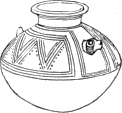 Fig. 173. |
 Fig. 174. |
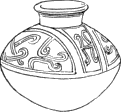 Fig. 175. |
| Theoretical origin of the arched panels. | ||
In multiplying these vessels the original forms and associations of decorative features are necessarily to some extent lost sight of; the panels change in shape, number, and relationships; and devices originally appropriate to particular spaces are employed indiscriminately, so that the uninitiated see nothing but confusion. All devices are delineations of or have more or less definite reference to the creature or spirit associated with the vessel.
Fig. 176. Vase decorated with conventional figures of alligators—½.
121I will now pass over the many hundreds of pieces with designs too conventional to furnish a clew to the original animal forms, yet still suggesting their existence, to those in which the life forms can be traced with ease or in which they are delineated with a much nearer approach to nature. The manner of introducing life forms into the panels of the encircling zones is illustrated in the following figures. In the vase shown in Fig. 176 there are four panels, two short and two long, separated by vertical bands. The short panels are black, but the long ones are occupied by rudely drawn figures of alligators, some of which are very curiously abbreviated. At the right hand in the cut we have simply the head with its strong recurved jaws and notched crest. The principal figure at the left is a two headed alligator, the body being straight and supplied with two feet. The ground finish of the decorated band is in the light gray tint and the alligator figures and vertical septa now appear in that color. The ground of the remainder of the surface is red. It will be seen that in this case the panel outlines are rather elaborate and that the neck and base are striped in a way to enhance considerably the beauty of the vessel. Additional examples of animal devices are given in Figs. 177 and 178. The significance of the curious figure 122 seen in the first is not easily determined, although we do not hesitate to assign to it an animal origin. There is a suggestion of two sitting figures placed back to back between the upright serrate lines. In the second piece, which is from another vessel, the space between the serrate lines is occupied by a sketchy figure which, in the phraseology of heraldry, may be likened to a monkey rampant.
 Fig. 177. |
 Fig. 178. |
| Portions of decorated zones illustrating treatment of life forms. | |
Fig. 179. Vase decorated with highly conventional life forms—½.
Fig. 179a. Design from vase shown in Fig. 179.
In Figs. 179 and 180 I present very interesting examples in which the arched panels are used. In the first the compartments are occupied by a favorite Chiriquian motive, which consists of groups of lines curled up at one end like unfolding fronds. The whole group represents a very highly conventionalized animal figure (Fig. 179a). The devices occupying the upright panels take the place of the animal heads shown in several preceding figures. In the arched panels shown in Fig. 180 we have the frond-like motive treated in a manner 123 to make it pretty certain that a reptilian form is intended. These figures are fully and systematically presented in a succeeding section.
Fig. 180. Vase decorated with highly conventional life forms—½.
Many of these globular vases are unusually handsome. The polished ground is red or is varied with stripes or panels of the whitish slip. Over this ground the whole surface was painted black and then the lost color was employed to work out the design. The coiled figures were produced by drawing the lines in the lost color. The interspaces were then roughly gone over with the same pigment in such a way as to leave the figures inclosed within rather uneven black borders. The presentation of these ornaments brings me naturally to the consideration of a number of very puzzling forms which, if taken alone, must inevitably be referred to vegetal originals. In Fig. 181 we have a handsomely shaped vessel, finished in a polished red ground and decorated in the usual manner. In the main zone—here rather high up on the vase—there is a series of upright figures resembling stalks or stems with scroll-like branches springing from the sides. The stalks are probably the septa of the panels and the leaves are the usual reptilian symbols. About the widest part of the body of the vase is a band of ornament probably representing an animal.
Fig. 181. Vase decorated with highly conventional life forms—½.
A still more remarkable ornament is shown in Fig. 182. The decorated zone of the vessel from which this is taken is divided into three panels, each of which contains stem-like figures terminating in flower shaped heads and uniting in a most remarkable way animal derivatives and vegetal forms. I am inclined to the view that here, as in 124 the preceding case, the resemblance to a vegetal growth is purely adventitious.
Fig. 183. Example of vase of unusual shape—½.
 Fig. 184. |
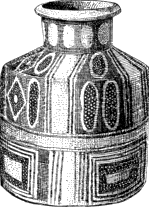 Fig. 185. |
| Examples of vases of unusual shapes—½. | |
In striking contrast with the globular forms just given are the angular outlines presented in the following illustrations. The first is flattened above, the body being much expanded horizontally and having a sharp peripheral angle. Upon the shoulder, occupying the places of and probably standing for animal heads, are two cruciform 125 nodes, about which the scroll-like decorations of the upper surface are coiled. We see by this that in the mind of the potter a correlation existed between the plastic and the painted devices even in these conventional decorations. The second illustration represents a neatly finished bottle, with upright sides and conical base, upon the shoulder of which minute animal figures are perched. The painted design is nearly obliterated. The third example is unique. The sides are upright and the bottom is flat. The ornament occupies the entire surface and is divided into two sections or zones by a red band about the middle.
Complex and compound forms are comparatively rare. A double vessel is shown in Fig. 186, and a second, varying somewhat from the first in shape and ornamentation, is presented in the succeeding figure. Vessels of this form are always small, but are neatly constructed and finished with much care. The strong handles are more or less arched and connect the inner margins of the two lips. The bodies of the twin cups are closely joined, but the two compartments are not connected.
 |
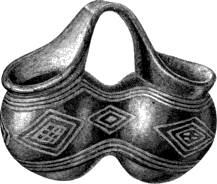 |
| Fig. 186. Double vessel with high arched handle—½. | Fig. 187. Double vessel with arched handle—½. |
It seems impossible to present a satisfactory series of the plastic features characteristic of this group of products without extending this paper inordinately. Handles, legs, and life forms are varied and interesting; they are not so boldly treated, however, as in some of the 126 other groups. This is a result perhaps of the unusual degree of polish given to all parts of the surface preparatory to the application of designs in color, the processes tending to subdue and simplify the salient features.
With reference to life forms it has already been pointed out that the painted figures generally imitate or typify animal forms, and it is important to note that these figures are in very many cases used as auxiliaries to plastic features in the development of particular conceptions. This is shown to advantage in Fig. 188, which illustrates a small, well formed bottle, having two large human-like heads attached to opposite sides of the body. There are no other plastic features, but the heads are supplied with arms and legs, rudely expressed in black lines, which are really the interspaces of the lines drawn in the lost color. These painted parts occupy the zone usually devoted to decoration and, as will be seen by reference to the cut, resemble closely the radiate or meandered figures seen in vases of the class shown in Fig. 167. The arms are joined to the lower part of the head and extend upward to the neck of the vessel, where they terminate in rudely suggested fingers. Rising to the right and left of the arms are legs terminating as do the arms. A double row of dots is carried along each member, and thus we have a suggestion of the relation of the dots and dotted lines, seen in more highly conventional forms, to the markings of the creature represented or symbolized. The grotesque faces are covered with lines which follow the forms as if imitating markings upon the skin. Another example, equally suggestive, also employing an animal form, is shown in Fig. 189. It is a cup, mounted upon three feet, which has attached to one side the head of a peccary, modeled with more than usual skill. The ears of the animal appear at the sides of the vessel and the tail is opposite the head. The lines and dots seen upon the head are carried along the sides of the vessel as far as the ears and 127 undoubtedly represent the markings of the animal’s skin. Behind the ears the markings are different in character and purely geometric. A view of the under side of the vessel is shown in Fig. 190 and illustrates a treatment characteristic of the tripod vases of this class. In other cases, instead of fixing the head of the animal upon one side 128 and other members of the body upon other sides, two heads, or two complete creatures, are placed opposite each other.
Fig. 189. Vase modeled to represent a peccary—½.
Fig. 190. Under surface of vase shown in Fig. 189.
I present next (Fig. 191) a piece in which there is no recognizable relationship between the painted and the plastic features. It is a small tripod cup with upright walls, upon which two characteristic Chiriquian human figures, male and female, are fixed. The painted figures upon the sides of the vessel are geometric, but refer possibly to some character or attribute of the modeled figures or are the survivals of figures belonging to vessels of this shape or style before the life forms were associated with them. The legs, however, so far as can be determined, are not related to the human motive, as they are modeled and painted to imitate the heads of alligators.
I shall now present a few shallow bowls or pans mounted upon tripods. They vary in dimensions from a few inches in diameter to a foot or more and are strongly made, symmetrically formed, and neatly finished. The polished surfaces are mainly red. The designs were executed in the usual way in the lost color, upon a black ground, and are confined chiefly to the exterior surface. The alligator is the favorite motive, and in a number of cases is quite graphically, although still conventionally, rendered. As in the preceding examples, the animal heads represented in the legs do not always correspond to the creatures embodied in the painted decoration.
In Fig. 192 we have a representative example of moderate size and ordinary finish. The decorated band is divided into panels, three of which are long and contain figures of the alligator. The other three are short and are filled with conventional devices, related perhaps to that animal. The legs are apparently intended to resemble the heads of alligators. A large piece, nearly twelve inches in diameter, is very similar in shape and decoration, but the legs resemble puma heads.
Fig. 192. Tripod cup, with figures of the alligator—½.
129The specimen shown in Fig. 193 is extremely well made and differs decidedly from the preceding. The sides are upright and the lip is recurved and thick. The legs represent some animal form with thick body, eyes at the top, and a tail-like appendage below that turns up and connects with the side of the body. The form of the bowl is symmetrical and the surface carefully finished and polished. The exterior design is divided into panels, as in the preceding case; the figures are simple and geometric. The inside of the upright portion of the wall is decorated with vertical lines and bands and the bottom is covered with an octopus-like figure, now partially obliterated.
Fig. 193. Large shallow tripod vase, with geometric decoration—½.
The remarkable example shown in Fig. 194 illustrates a number of the points suggested in the preceding pages. It is a large bottle of the usual contour and color, mounted upon three high legs, which are slit on the inner surface and contain movable balls of clay. Two handles, placed at opposite sides of the neck, represent human or anthropomorphic figures. These figures and the neck and base of the vessel were finished in the red slip. The broad zone extending from the neck to some distance below the periphery was finished in the gray slip, with the exception of the frames of two panels beneath the handles and the foundation lines of two large figures of alligators, which are in red. The surface, when thus treated, was well polished and then a coat of black was laid upon it, and upon this details of the designs were drawn in the lost color. The figures of the alligators exhibit some striking peculiarities. The hooked snout, the hanging jaw, the row of dotted notches extending along the back, and especially the general curve of the body are worthy of attention. 130 These features are seen to better advantage in the series of vases presented in the following section.
Fig. 194. Large bottle shaped vase, with high tripod and alligator designs—½.
Belonging to this group are many whistles, needlecases, and rattles, all of which are described under separate headings upon subsequent pages.
The alligator group.—
The group of ware to which I give the above name is perhaps the most interesting in the collection, although numerically inferior to some of those already presented. Its decoration is of a very striking character and may serve to throw much light upon the origin and evolution of certain linear devices, as it illustrates with more than usual clearness the processes of modification.
I will first present a representative series of the vessels, in order that they may in a measure tell their own story; yet it is not possible without 131 the direct aid of a full series of the objects themselves to convey a clear and comprehensive notion of the metamorphoses through which the forms and decorations pass.
This group, like that last described, is composed chiefly of bottle shaped vases with globular bodies and short, wide necks; but there is no danger of confusion. By placing a series from each group side by side a number of marked differences may be noted. In the lost color group the neck is decided in form, the body is usually somewhat flattened above and is distinctly conical below, and the prevailing color is a rich dark red. In the alligator group the body is more nearly globular and the curves of the whole outline are more gentle; the prevailing color is a light yellowish gray. The reds and the blacks, which are used chiefly in the figures, are confined to rather limited areas.
Besides the bottle shaped vases, there is a limited series of the usual forms, and a few pieces exhibit unique features. The management of life forms is especially instructive. Handles are rare and legs are usually not of especial interest, as they are plain cones or at most but rude imitations of the legs of animals. Shallow vessels are invariably mounted upon tripods and a few of the deeper forms are so equipped. Usually the sizes are rather small; but we occasionally observe a bottle having the capacity of a gallon or more. The materials do not differ greatly from those employed in other groups of ware. The paste is fine grained and light in color, sometimes reddish near the surface, and where quite thick is darker within the mass. A slip of light yellowish hue was in most cases applied to the entire surface. A red ochery pigment was in some instances used in finishing the lip and the base of the body, and occasionally the red pigment was applied as a base, a kind of sketch foundation for the decoration proper. For example, when the alligator was to appear upon the side of the vessel, the principal forms were traced in broad lines of the red color, and these were polished down with the slips. When the polishing process was complete, the details of the figure, were drawn in black and in cases partially in red. Black was the chief delineating color, the red having been confined to broad areas, to outlines, and to the enframing of panels. In execution, therefore, there is a decided contrast with the preceding group, and it may be added that there is an equally strong contrast in both treatment and subject matter of the ornament. The motives are derived almost wholly from life forms and retain for the most part features that suggest their origin. The subjects are chiefly reptilian, the alligator appearing in a majority of cases, and hence the name of the group.
I present first a few examples of plain bottles which have no extraneous plastic features. The decorations are arranged in two ways, in zones about the upper part of the body or in circular areas, generally four in number, equidistantly placed about the shoulder of the vessel.
132Fig. 195. Large bottle, with narrow zone containing figures of the alligator—⅓.
An example of the first style is given in Fig. 195, which represents the largest piece in this group of ware. The form is symmetrical and very pleasing to the eye. The surface is not very highly polished and shows the marks of the polishing implement distinctly over the entire surface. Two black lines encircle the flat upper surface of the rim and the outer margin is red. The neck and a narrow zone at the upper part of the body are finished in a cream colored slip and the body below this is red. The narrow band of ornament occupies the lower margin of the light colored zone and consists of five encircling lines in black, three of which are above and two below a band one-half an inch wide, in which five much simplified figures of alligators are drawn. Besides these figures there are two vertical septum-like bands. Each of these consists of three lines bordered by dots, which probably have some relationship with the alligator. The decorated zone of these vessels is divided in various ways into panels, some of which are triangular, while others are rectangular or arched. The latter form is seen in Fig. 196. Five arches, having no border line above, are occupied by abbreviated alligator devices. The number of compartments 133 ranges in other specimens from two to a dozen or more. They are filled in with various devices, to be described in detail further on.
Fig. 196. Vase with decorated zone containing four arched panels—½.
A very peculiar form of decoration consists of circular or rosette-like ornaments, such as are shown in Fig. 197. Four slightly relieved nodes an inch or more in diameter are placed upon the shoulder of the vessel. These are encircled by red lines which inclose two black lines 134 each, and within these are peculiar devices in black. Other vessels furnish figures of greatly diversified characters, most of which evidently refer to life forms. A full series of these is given in a subsequent section of this paper, where the origin of the nodes and the manner in which the painted figures probably became associated with them will be fully set forth.
Fig. 197. Vase with four round nodes upon which animal devices are painted—½.
In the series of outlines presented in Fig. 198, we have some of the varieties of form and decoration of both the ordinary bottles and the plainer tripod cups. Each example presents certain features of particular interest. The handsome little bottle (d) with the plastic ornament about the neck and the zone of geometric ornament in black and red lines is unique. The double necked bottle is an unusual form and its decoration consists of a strangely conceived representation of the alligator. The tripod vases are worthy of close attention: the piece illustrated in b has a zone of ornament separated into three parts by vertical spaces, each part being enframed in black. The sections are divided by red lines into three panels, each of which contains a conventional figure of an alligator in black. The piece shown in a is unique in its decoration. Four angular fret links in black are inclosed in as many panels, bordered by red and separated by blank spaces. These fret links, as I shall show further on, probably refer to or symbolize the alligator. The legs of the cups are all conical and are marked with short transverse lines in black, which have a direct reference to the markings of the animal to which the vase was consecrated. A careful study of the preceding illustrations leads to 135 the conclusion that in the mind of the potters there was a close and important relationship between the vessel and the reptilian forms embodied in both plastic and surface embellishment. The series of examples which follow have a bearing upon this point. I shall begin with that in which the creature is most literally rendered.
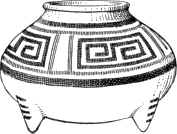 a |
 b |
||
 c |
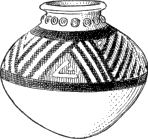 d |
 e |
|
| Fig. 198. Vases of varied form and decoration. | |||
In Fig. 199 the whole conformation of the vessel is considerably modified through the attempt to perfect the likeness of the alligator, whose head, tail, and legs are graphically rendered. The body, head, and tail are covered with nodes, each of which is encircled by a black ring and has a black dot upon the apex. Dotted rings and short strokes of black occupy the interspaces. These devices represent the spines and scales of the creature’s skin. The legs are marked with horizontal stripes and oval spaces at the top inclose three dots each. The general 136 color of the vessel is a dark brown. This piece should be compared with the alligator whistle shown in Fig. 250.
Fig. 199. Alligator vase, with conventional markings—½.
Fig. 200. Alligator vase, with conventional figures of the alligator painted on the sides—½.
Fig. 201. Vase having the head and tail of a serpent projecting from opposite sides of the body and connected by a meandered design which stands for the markings of the body—½.
A somewhat different treatment is shown in Fig. 200. Here the animal form has undergone considerable modification. There are but three legs—a concession to the conventional tripod—and the body exhibits, instead of the nodes and the markings of the creature’s skin, two conventional drawings of the whole animal. Now, by higher and higher degrees of convention, we come to a long series of modified results which must be omitted for want of room. We find that the plastic features are gradually reduced until mere nodes appear where the head and the tail should be, and finally in the lower forms there remains but a blank panel or a painted device, as already shown in a preceding section. The painted devices are also reduced by degrees until all resemblance to nature is lost and geometric devices alone remain. I observe in this association of plastic and painted features a lack of the perfect consistency I had learned to expect in the work of primitive peoples. It is easy to see how, from painting the markings of the creature’s skin upon the body of the vessel, the painter should come gradually to delineate parts of the creature or even the whole creature, but we should not expect him to paint a creature distinct in kind from that modeled, thus confusing or entirely separating the conceptions; this has been done, apparently, in the vase illustrated in Fig. 202, where the plastic form represents a puma and the painting upon the sides seems intended for an alligator. It will be seen from the figures given that the devices of the panels or sides do not necessarily represent the markings of the animal’s body, as in Fig. 201, but that they may refer to the entire creature (Fig. 200) or even to what appears to be a totally distinct creature (Fig. 202).
Fig. 202. Vase representing a puma, with figures of the alligator painted upon the sides—½.
If realistic or semirealistic delineations are confused in this way it is to be expected that highly conventional derivative figures, so numerous and varied, should be much less clearly distinguished; that indeed there should be no certainty whatever in the reference to originals. It is difficult to say of any particular conventional device 137 that it originated in the figure of the animal as a whole rather than in some part or character of that animal or of some other animal.
Fig. 203. Shallow vase with reptilian features in the round and designs in red and black representing the markings of the creature’s body—½.
A very instructive example bearing upon this subject is shown in Fig. 203. Attached to one side of the basin is a pendent head resembling that of a serpent or a turtle. A kind of hood overhangs the head and extends in a ridge around the sides of the vessel, connecting with the tail of the creature, which is also pendent and hooded. Four legs support the vessel and are marked with transverse stripes of red and black paint. The upper surface of the head is covered with reticulated lines in black, and bands of conventional ornament in the same color extend around the sides of the vessel, uniting the head with the tail of the animal. A single band of ornament passes beneath the body, also connecting those members. It is plain that these painted bands serve to complete the representation of the reptile. 138 But, as I have just shown, they are as likely to stand for the whole creature or to be the abbreviated representative of the whole creature as to represent merely the markings of the body. These devices, as arranged in the zone, resemble in a remarkable degree the conventional running scroll.
Fig. 204. Vase with funnel shaped mouth and square body, supported by two grotesque figures and decorated with figures of alligators and monkeys—½.
I have but one more example of the alligator vases to present, but it is perhaps the most remarkable piece in the collection (Fig. 204). It illustrates to good advantage both the skill and the strange fancy of these archaic potters. A large vase, having a high flaring rim and a subcubical body, is supported by two grotesque human appearing figures, whose backs are set against opposite ends of the vessel. The legs are placed wide apart, thus affording a firm support. The heads of the two figures project forward from the shoulder of the vase and are flattened in such a way as to give long oval outlines to the crowns 139 which are truncated and furnished with long slit-like openings that connect through the head with the main chamber of the vessel. The openings are about two and a half inches long and one-eighth of an inch wide and are surrounded by a shallow channel in the flat, well polished upper surface. The extraordinary conformation of this part of the vessel recalls the well known whistling vases of South America; but this piece is too badly broken to admit of experiment to test its powers. It is generally likened to a money box. In order to convey a clear conception of the shape of the upper surface, I present a top view of the vessel (Fig. 205).
A front view of one of the supporting figures is shown in Fig. 206. Although certainly not intended to represent a human figure with accuracy, it is furnished with a crown, as are the figures in gold and stone, and is covered with devices that seem to refer to costume. The features are extremely grotesque, the nose resembling the beak of a bird and the mouth being a mere ridge, without indications of the lips. The face and the chest are painted with curious devices in red. The funnel and body of the vase are decorated with subjects that seem to have no connection with the plastic features and no relation to one another in subject matter. The upper panel, surrounded by a framework of black and red lines, contains the figure of an alligator much simplified and taking a peculiar position on account of the shape of the space into which it is crowded. The figure occupying the body panel is that of a very strangely conventionalized two tailed monkey and is enframed by a wide red line. On the shoulder of the vessel is an ornament consisting of a number of angular hooks attached to a straight line. The effect is like that of fretwork, but the figure is probably derived from a modified animal form. The paste of this 140 vase is sandy and is reddish gray near the surface and quite dark within the mass. The modeling is thoroughly well done, and the surface, which is of a somber, yellowish gray tint, is highly polished. The figures are drawn chiefly in black, red being confined to broad lines and areas. De Zeltner published photographic illustrations of a similar vase with his pamphlet on the graves of Chiriqui. That specimen is now, I believe, in the hands of Prof. O. C. Marsh, of New Haven. It corresponds very closely in nearly every respect with the example here described.
Fig. 207. Large vase with decorations in red and black—¼.
The polychrome group.—
The National Museum collection contains but three examples of this most artistic of the wares of Chiriqui. Its claim to superiority rests upon a certain boldness and refinement of execution, combined with nobleness of outline and a type of design much in advance of other isthmian decoration. It is probably most nearly allied to the ware of the alligator group, and it possesses some of the characteristics of the best Central American work. Unlike the other wares of Chiriqui, this pottery has a bright salmon red paste and the slip proper is a delicate shade of the same color. In nearly all cases undecorated portions of the surface are finished in 141 red, which appears to have been polished down as a slip. The designs are in three colors—black, a strong red, and a fine gray purple—which, in combination with the bright reddish ground, give a very rich effect. The first example, shown in Fig. 207, is a large, nearly symmetrical bottle with a short neck and a thick, flaring lip. The inner surface of the orifice and the lower half of the body are finished in red and the neck and shoulder in the salmon colored slip. A wide zone of ornament encircles the upper surface of the body. The designs are executed with great skill in red and black colors and include two highly conventional figures, probably of reptilian origin. The manner of their introduction into the zone is shown in Fig. 208. The oval faces are placed on opposite sides, taking the positions usually occupied by modeled heads. Each face is supplemented by a pair of arms which terminate in curiously conventional hands, and the two caudal appendages are placed midway between the faces, filling triangular areas. The body of the vase serves as a body for both creatures. In the illustration, the red of the design, which is carried over all of one face save the eyes and mouth and serves to emphasize the features of the other face, is indicated in vertical tint lines and the black is given in solid color. This vase is twelve inches in height.
142Fig. 208. Devices of the decorated zone of vase shown in Fig. 207.
Fig. 209. Handsome vase with four handles and decorations in black, red, and purple—⅔.
A second example, illustrated in Fig. 209, is a fine piece of somewhat unusual shape. The orifice is trumpet shaped and rather too wide for good proportion. The body is flattened above and conical below and is supported by a rather meager annular foot. The paste is of a light brick red color, and the slip, as seen in the ground of the decorated belt, is a pale gray orange. Undecorated portions of the surface are painted red. The ornamented zone is interrupted by two pairs of handle-like appendages set upon the outer part of the shoulder. These projections may possibly have served as handles, as they are perforated both horizontally and vertically, but they are at the same time undoubtedly conventionalized animal forms, the creature being represented by the four flattened, transversely marked arms or rays and an eye-like device painted upon the top of each figure. The painted devices are seen in plan in Fig. 210, where the relations of the relieved features to the zone of painted decoration are clearly shown. This zone is divided into panels of unequal dimensions, and within these a number of extraordinary devices are drawn in three colors, red, black, and purple. These are distinguished in the plan by peculiar tint lines. The designs are of such a character as to leave little doubt that they are ideographic, although at present it is impossible to guess the nature of the associated ideas. The annular foot observed in this specimen illustrates the first step in the development of a feature the final stage of which is shown in Fig. 211. The latter 143 shape is such as would result from inverting the preceding form, removing the conical base of the body, and using the funnel shaped orifice as a stand. This highly developed shape implies a long practice of the art. The form is a usual one in Mexico and in Central America. The bowl is shallow and is set gracefully upon the stand, the whole shape closely resembling simple conditions of the classic kylix. The color of the paste is a pale brick red and that of the slip approaches orange. The walls are thick and even and the surface is very carefully polished.
Fig. 210. The painted designs of vase in Fig. 209 viewed from above.
The painted decoration is of unusual interest. The colors are so rich, the execution is so superior, and the conception so strange that we dwell upon it with surprise and wonder. The central portion of the bowl is occupied by what would seem to represent a fish painted in strong, firm, marvelously turned lines, and in a style of convention wholly unique. The outlines are in black and the spaces are filled in with red and purple or are left in the orange hue of the ground. An idea of the superior style of execution can be gained from Fig. 212. It will be impossible to characterize the details of the drawing in words. The strange position and shape of the head, the oddly placed eyes and mouth, and the totally incomprehensible treatment of the body can be appreciated, however, by referring to the illustration. A careful study leads inevitably to the conclusion that this 144 was no ordinary decoration, no playing with lines, but a serious working out of a conception every part of which had its significance or its raison d’être.
Fig. 211. Vase of unusual shape, with decoration in black, red, and purple—⅓.
Fig. 212. Ornament occupying the interior surface of the basin of vase shown in Fig. 211.
The figures occupying the border zone of the bowl are worthy of careful inspection. It will be seen that the potter, even in this 145 highly specialized condition of the utensil, has not lost sight of the conception that the vessel is the body of an animal, as we have seen so often in simpler forms, and that the symbols of the creature should appear upon it and encircle it. The zone is divided into two equal sections by small knobs, painted, as are the handle-like appendages in the preceding specimen, to represent some animal feature. The lateral sections are occupied by eye-like figures that stand for the markings of the body of the creature symbolized. They really occupy the spaces left by a continuous waved body or life line, which they serve to define. Devices of this class are most frequently met with in connection with representations of the alligator. They may, however, symbolize the serpent, as occasionally seen in the alligator group. Decorative conceptions so remarkable as these could arise only through one channel: the channel of mythology. The superstitions of men have imposed upon the art a series of conceptions fixed in character and limited to especial positions, relations, and forms of expression. It is useless to speculate upon the nature of the mythologic conceptions with an idea of arriving at any understanding of the religion of the people; but we do learn something of the stage of development, something of the condition of philosophy.
Fig. 213. Large vase of fine shape and simple decorations. From De Zeltner—about ¼.
I must not close this section without referring to some fine vases that belong apparently to this group and which were collected 146 by De Zeltner and illustrated by photographs accompanying his pamphlet. They are now, I believe, in the possession of Prof. O. C. Marsh. The sketches given herewith are copied from De Zeltner’s photographs and are probably somewhat defective in details of drawing. The piece illustrated in Fig. 213 is not described by the author, but is evidently a handsome vessel and is decorated in a very simple manner. A band of devices symbolizing the body of an animal encircles the middle portion of the vase. The height is about a foot.
Fig. 214. Vase with extraordinary decorative designs. From De Zeltner—about ¼.
A second piece (Fig. 214), of which two views are given by the same author, corresponds closely in many respects with the vase illustrated in Fig. 211 and is described in the following language:
My collection includes a cup (or chalice) of baked clay 25 centimeters in diameter, mounted on a hollow stand which gives it a height of 18 centimeters, and the designs of which are very rich and in perfect taste. The base is hollow and colored red, white, black, and purple; it has four narrow openings or slits, and the design represents plaits spirally arranged. The under side of the cup is divided into four compartments, each of which incloses a dragon painted in black and red on a white ground; the borders are sometimes red, sometimes purple. The body of the dragon might have been painted in China, so neat and intricate is the drawing.
The design upon the inside of the cup seems to resemble Egyptian art. The body of a man is seen, painted in red, the arms and legs separated, and the shoulders bearing the head of the dragon with teeth and crest. The color is similar to the rest of the piece—purple, white, and black. The intermediate spaces are filled with very intricate designs.
This extraordinary design is shown in Fig. 215, and it will be seen that it agrees in many respects with figures presented in the lost color and alligator groups. It is compound in character, however, the head referring to the alligator, the body and extremities perhaps to a man or to a monkey. The suggestion of the oriental dragon in this, as in other examples, is at once apparent, and the resemblance to certain conventional forms that come down to us from the earliest 147 known period of Chinese art is truly remarkable. We cannot, of course, predicate identity of origin even upon absolute identity of appearances, but such correspondences are worthy of note, as they may in time accumulate to such an extent that the belief in a common origin will force itself upon us.
Fig. 215. Painted design of vase in Fig. 214, viewed from above, thought to represent a dragon by De Zeltner; probably a composite of the alligator and the monkey or man.
Unclassified.—
A small number of vases do not admit of classification under any of the preceding heads. In most cases, however, they are not of especial interest and may be passed over. They represent a number of varieties of ware and are possibly not all Chiriquian, their affinities being rather with the pottery of Costa Rica and Nicaragua. One remarkable piece, of which a sketch is given in Fig. 50, c, is of large size and is shaped somewhat like an hour glass, and on account of its peculiar form and markings may be said to resemble a corset. The upper end is somewhat the smaller, and the septum, which forms the bottom of the vessel, is placed about an inch above the base of the foot. The interior surface is smoothly polished and painted a dark dull red. The exterior is uncolored and neatly fluted. The series of vertical ribs of the upper end is separated 148 from those of the base by a belt of horizontal flutings, and a wide smooth space extends from the top to the base, the lower section of which is occupied by a row of button-like, indented knobs. The use of this utensil may not have been peculiar, but its shape is wholly unique. It resembles most nearly the ware of the maroon group. Its height is twelve inches.
Perhaps the most interesting of these unclassified vases is a somewhat fragmentary piece, of which an outline is given in Fig. 216. The ware closely resembles that of the alligator group in color of the paste and slip, but the base has been supplied with an annular stand, a feature not observed in that group, and the colors of the design, with the exception of the black, are unlike those used in Chiriquian vases.
Fig. 216. Vase of unique form and decoration—⅓.
It will be seen by reference to Fig. 217 that the painted figures are partially pictorial, the conventional scenes including the sun, the moon, and stars. The more conventional parts of the design are very curious and without doubt are symbolic. The border of fret work is Mexican in style. The sun, which is only partially exposed above the horizon, is outlined in red and is surrounded by red rays. The 149 figures supposed to represent the moon and the stars are in black. In the illustration the reds of the original are represented by vertical tint lines and the brownish grays by horizontal tint lines. The black is in solid color.
Fig. 217. Painted design of vase in Fig. 216 in black, red, and gray.
MISCELLANEOUS OBJECTS OF CLAY.
As primitive peoples advance in culture and the various branches of art are differentiated, each of the materials employed is made to fill a wider and wider sphere of usefulness. Clay, applied at first to vessel making and used perhaps as an auxiliary in a number of arts in which it took no definite or individual shapes, gradually extended its dominion until almost every art was in a measure dependent upon it or in some way utilized it. The extent of this expansion of availability is in a general way a measure of the advancement of the races concerned. The Chiriquians employed clay in the construction of textile machinery, as shown by the occurrence of spindle whorls, and a number of small receptacles, probably needlecases, are constructed of that material. It was employed in the manufacture of stools, statuettes, drums, rattles, and whistles. With less cultured races, such as the Pueblo and mound builders of the north, such articles were rarely manufactured, while with the more cultured nations of Mexico and Peru a wider field was covered and the work was considerably superior.
SPINDLE WHORLS.
The art of weaving was carried to a high degree of perfection by many of the American races, but the processes employed were of the simplest kind. The threads were spun upon wooden spindles weighted 150 with whorls of baked clay. These whorls are not plentiful in the graves of Chiriqui, but such as have been collected are quite similar in style to those of Mexico and Peru. In Figs. 218, 219, and 220 we have three examples modeled with considerable attention to detail but comparatively rude in finish. They are in the natural color of the baked clay and are but rudely polished. The first is encircled by a line of rough, indented nodes, the second is embellished with homely little animal figures, and the third with incised patterns and rude incisions.
NEEDLECASES (?).
I have given this name to a rather large class of small oblong or oval receptacles that could have served to contain needles or any other small articles of domestic use or of the toilet. They consist of two parts, a vessel or body and a lid. The former takes a variety of cylindrical, subcylindrical, and doubly conical shapes, and the latter is conical and is in many cases furnished with a knob at the top for grasping with the fingers. The lid is attached or held in place by means of strings passed through small holes made for the purpose in corresponding margins of the two parts. These objects were in pretty general use in the province, as they are found to belong to a number of the groups of ware, being finished and decorated as are the ordinary vessels of these classes. A few type specimens are given in the following cuts. A fine example belonging to the unpainted ware is shown in outline in Fig. 221. It is five inches in height and three in diameter and is pleasing in shape. The specimen outlined in Fig. 151 222 is of the lost color group, but has lost nearly all traces of the decorative design.
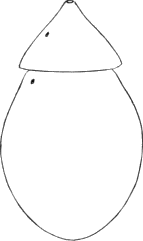 |
 |
| Fig. 221. Needlecase of unpainted clay with conical lid—½. |
Fig. 222. Needlecase, lost color group of ware—½. |
A fine example, with high polish and elaborate decoration, is presented in Fig. 223. The lid is raised to show the position of the perforations. Two interesting examples belonging to the dark incised ware are shown in Figs. 224 and 225. The deeply incised design of the first is purely geometric, but is probably of graphic parentage, while that of the second, rather rudely scratched through the dark surface into the gray paste, is apparently a less highly conventionalized treatment of the same motive.
FIGURINES.
I have already called attention to the fact that there is no such thing in Chiriquian ceramic art as a well modeled human figure and apparently no indication of an attempt to render the human physiognomy with accuracy. It is highly probable that the personages embodied in the mythology of the people took the forms of animals or were anthropomorphic and gave rise to the peculiar conceptions embodied in their arts. The strange objects herewith presented are rendered in a measure intelligible by the adoption of this hypothesis. These figurines are confined to the alligator group of ware and are quite numerous. They are small, carefully finished, and painted with care in red and black lines and figures. They are semihuman and appear to be arrayed in costume. The head of each is triangular in shape, having a sharp, projecting profile, with the mouth set back beneath the chin, reminding one of the face of a squirrel or some such rodent. 152 The figures occupy a sitting posture. The legs are spread out horizontally, giving a firm support, and terminate in blunt cones, which are in some cases slightly bent up to represent feet. The hands rest upon the sides or thighs or clasp a small figure apparently intended for an infant, which, however, does not seem to have any human features. In one case this figure is placed upon the back of the figurine and appears to hold its place by means of four feet armed with claws (Fig. 226); in another it is held in front (Fig. 227). The neck is usually pierced to facilitate suspension, and the under side of the body—the sitting surface—is triply perforated, or punctured if solid, as if for the purpose of fixing the figure in an upright position to some movable support. The central perforation is round and the lateral ones, on the under side of the legs, are oblong. The largest specimen is six inches in height and the smallest about one and a half inches. They are rather elaborately painted with black and red devices which, by their peculiar geometric character, are undoubtedly intended to indicate the costume. The hair is represented by black stripes, which descend upon the neck, and the face is striped with red. They are found associated with other relics in the graves and were possibly only toys, but more probably were tutelary images or 153 served some unknown religious purpose. The sex is usually feminine. Two additional examples showing side and back views are outlined in Figs. 228 and 229.
Fig. 226. Statuette, alligator group—1/1.
Fig. 227. Statuette, alligator group—1/1.
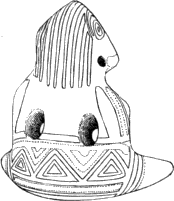 |
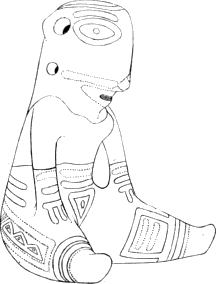 |
| Fig. 228. Statuette of small size—1/1. | Fig. 229. Statuette of largest size—½. |
STOOLS.
I have given this name to a class of stone carvings presented in a previous section, and, for want of a better name, give it also to a series of similar objects modeled in clay. These are among the most elaborate products of Chiriquian art. In all cases they are of the yellowish unpainted pottery and indicate much freedom and skill in the handling of clay. They do not show any well defined evidences of use, and as they are too slight and fragile to be used as ordinary seats we are left to surmise that they may have served some purpose in the religious rites of the ancient races. They are uniform in construction and general conformation and consist of a circular tablet supported by upright circular walls or by figures which rest upon a strong, ring shaped base. The tablet or plate is somewhat concave above, is less than an inch in thickness, and has a diameter of ten and one-fourth inches in the largest piece, descending to seven and one-half in the smallest. The margin is rounded and usually embellished with a beaded ornament consisting of grotesque heads, generally reptilian. The variations exhibited in details of modeling are well shown by the illustrations. In the example given in Fig. 230 the upright portion is a hollow cylinder, having four vertical slits, alternating with which are oblique bands of ornament in incised lines and punctures. The projecting margin of the tablet is encircled by a row of grotesque, monkey-like heads, facing downward.
Fig. 230. Stool of plain terra cotta, decorated with grotesque heads and incised figures—⅓.
Fig. 231 illustrates a specimen in which three grotesque figures, with forbidding faces, alternate with as many flat columns embellished with rude figures of alligators. Eighteen grotesque, monkey-like heads occupy the lower margin of the seat plate in the spaces between the heads of the supporting figures. This specimen illustrates the favorite Chiriquian method of construction. The various parts were modeled separately in a rough way and then set into place 155 in the order of their importance. When this was done and the insertions were neatly worked together with the fingers, a number of small instruments were employed in finishing: a sharp stylus for indicating parts of the costume, and blunt points and small tubular dies for adding intaglio details of anatomy, such as the navel, the pupils of the eyes, and the partings of the fingers and toes.
Fig. 231. Stool of plain clay, with grotesque figures—½.
The discoidal plate of another specimen is supported by four absurdly grotesque monkeys, giving a general effect much like that of the last.
Fig. 232. Stool of plain terra cotta, with strange figures—⅓.
A very remarkable piece is shown in Fig. 232. The tablet is supported by six grotesque figures, somewhat human in appearance, whose limbs are intertwined with serpents, suggesting the famous group of the Laocoön. The work is roughly done and the details 156 are not carried out in a very consistent manner, as the arms and legs of the figures become confused with the reptiles and are as likely to terminate in a snake’s head as in a hand or foot. The rudely shaped bodies are covered with indented circlets or with short incised lines. The material, color, and finish are as usual. The height is four and one-half inches and the diameter of the tablet ten inches.
There are additional specimens in the National Museum. In one case, the largest specimen of the series, the tablet is supported by five upright female human figures and the margin is encircled by a cornice of forty-six neatly modeled reptilian heads. A small example differs considerably in general shape from those illustrated, the base being much smaller than the circular tablet. The supporting figures are two rudely modeled ocelots and two monkey-like figures, all of which are placed in an inverted position. Similar objects are obtained from the neighboring states of Central and South America.
MUSICAL INSTRUMENTS.
Something is already known of the musical instruments of the ancient Chiriquians through fugitive specimens that have found their way into collections in all parts of Europe and America. The testimony of the earthen relics—for no others are preserved to us—goes to show that the art of music was, in its rude way, very assiduously practiced, and that it probably constituted with these, as with most primitive communities, a serious and important feature in the various ceremonial exercises. Clay is naturally limited to the production of a small percentage of the musical instruments of any people, the various forms of woody growths being better adapted to their manufacture. We have examples of both instruments of percussion and wind instruments, the former class embracing drums and rattles and the latter whistles and clarionette-like pipes.
Rattles.—
Besides the ordinary rattles attached to and forming parts of vessels, as already described, there are a number of small pieces that seem to have served exclusively as rattles, while some are rattle and whistle combined in one piece. In no case, however, would they seem to the unscientific observer to be more than mere toys, as they are of small size and the sounds emitted are too weak to be perceptible at any considerable distance. At the same time it is true that they may have had ceremonial offices of no little consequence to the primitive priesthood. The simple rattles are shaped like gourds, the body being globular and the neck or handle long and straight. Like the wares already described, they are finished and decorated, the majority belonging to the lost color group. The length varies from three to six or seven inches. A number of minute slit-like orifices or perforations for the emission of the sound occur about the upper part of the body (Fig. 233). A septum is placed in the lower part of the neck, so that the handle, which is hollow and open at the 157 upper end, may serve as a whistle. In some cases the lower part of the neck is perforated for suspension at the point occupied by the septum, as imperfectly shown in the section (Fig. 234). The most interesting specimen in the collection is shown in Fig. 235; it is especially notable on account of its construction, which points clearly to the gourd as a prototype. The body is of the usual globular shape, slightly elongated above. The neck is represented as a separate piece lashed on with cords by means of perforations made for the purpose, just as are the handles of similar instruments constructed of gourds and reeds in Central American countries. The compartments of the handle and of the body are separate and the sound produced by the small oval pellets is emitted through slits of the usual form. The top of the handle is surmounted by a pair of grotesque human figures, male and female, placed back to back and united at the backs of the heads as seen in the cut. This object is gray in color and presents the roughened granular surface resulting from long exposure to the elements.
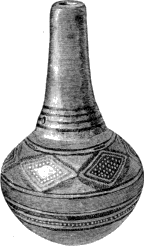 |
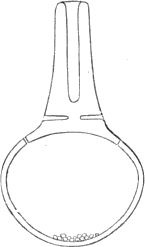 |
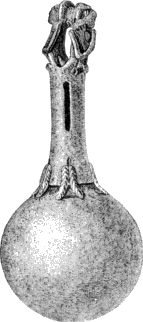 |
| Fig. 233. Rattle decorated in the style of the lost color group—½. | Fig. 234. Section of rattle shown in Fig. 233. | Fig. 235. Rattle of plain ware surmounted by two grotesque figures—½. |
Drums.—
The drum was a favorite instrument with the native American musician. Early explorers found its use next to universal, and the “tambour” is even now a characteristic feature of the musical paraphernalia of the Spanish-Americans. The primitive instrument was made by stretching a thin sheet of animal tissue over the orifice of a large gourd vessel or a vessel of wood or clay. The 158 use of clay was probably exceptional, as there are but three specimens in our Chiriquian collection. The shape is somewhat like that of an hour glass, the upper part, however, being considerably larger than the base or stand. In all cases the principal rim is finished with especial reference to the attachment of the vibrating head. The example presented in Fig. 236 has a deeply scarified belt an inch wide encircling the rim, and below it is a narrow ridge, intended perhaps to facilitate the lashing or cementing on of the head. Two raised bands, intended to imitate twisted cords, encircle the most constricted part of the body, a single band similarly marked encircling the base. The surface is gray in color and but rudely polished. The walls are about three-eighths of an inch thick, the height sixteen and one-half inches, and the greatest diameter seven and one-half inches.
 |
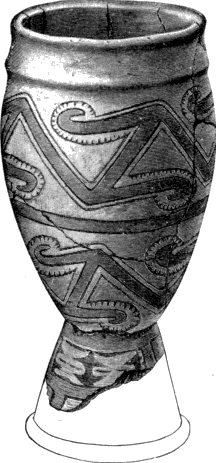 |
| Fig. 236. Drum of gray unpainted clay—¼. | Fig. 237. Drum with painted ornament in the style of the lost color group—1/9. |
The decorated specimen illustrated in Fig. 237 is imperfect, a few inches of the base having been lost. The shape is rather more elegant than that of the other specimen and the surface is neatly finished and polished. The ground color or slip is a warm yellow gray and the decoration is in red and black. The rim or upper margin is 159 rather rudely finished and is painted red and on the exterior is made slightly concave and furnished with a raised band to facilitate the attachment of the head. The painted ornament encircles the body in four zones, two upon the upper portion and two upon the base. The designs occupying the body zones are unique and viewed in the light of their probable origin are extremely interesting. In another place further on in this paper I shall show that they are probably 160 very highly conventionalized derivatives of the alligator radical, the meandered line representing the body of the creature and the scalloped hooks the extremities (Fig. 238). The two bands upon the base consist of geometric figures, the origin of which cannot be definitely determined, although they also probably refer to the alligator.
Fig. 238. Conventional design on drum shown in Fig. 237, composed of alligator derivatives.
In the collection there is a minute toy drum of the same general shape, and the same form reappears in some of the whistles, in one of which (Fig. 247) the skin head and its fastenings are all carefully reproduced in miniature. The immediate original of this particular form of drum was probably made of wood. A drum, recently brought from Costa Rica was made by hollowing out a cylindrical piece of wood and stretching a piece of snakeskin across the top. The shape is nearly identical with that of these earthen specimens.
Wind instruments.—
Earthenware wind instruments are found in considerable numbers and are associated with other relics in the tombs. Nearly all are very simple in construction and are limited in musical power, receiving and perhaps generally deserving no better name than whistles or toys. A few pieces are more pretentious and yield a number of notes, and if operated by skilled performers or properly concerted are capable of producing pleasing melodies. It is not difficult to determine the powers of individual instruments, but we cannot say to what extent these powers were understood by the original owners, nor can we say whether or not they were intended to be played in unison in such a way as to give a certain desired succession of intervals. There are, however, in a large number of these instruments a uniformity in construction and a certain close correspondence in the number and degree of the sounds that indicate the existence of well established standards. It does not appear absolutely certain to me that the system of intervals was made to conform to that of any known scale; but a difficulty arises in attempting to determine this point, as most of the pieces are more or less mutilated. We find also that the note producible by any given stop is not fixed in pitch, but varies, with the force of the breath, two or even three full intervals. As a result of this a glide is possible to the skilled performer from note to note and any desired pitch can be taken.
In material, finish, and decoration these objects do not differ from the ordinary pottery. A majority belong to the alligator group. The size is generally small, the largest specimen being about eight inches in length. The shapes are wonderfully varied and indicate a lively imagination on the part of the potter. Animal forms prevail very decidedly, that of the bird being a great favorite. In many cases the animals copied can be identified, but in others they cannot—perhaps from our lack of knowledge of the fauna of the province, perhaps from carelessness on the part of the artist or from the tendency to model grotesque and complicated shapes. The following creatures can be recognized: men, pumas, ocelots, armadillos, eagles, owls, ducks, parrots, 161 several varieties of small birds, alligators, crabs, and scorpions. Vegetal forms, excepting where in use as instruments or utensils, as reeds and gourds, were not copied. In the National Museum collection there are two tubular pipes, probably modeled after reeds, and another resembles a gourd in shape. The construction of the whistling apparatus is identical in all cases and corresponds to that of our flageolets (see sections, Figs. 240 and 242). Plain tubes were doubtless also used as whistles, and all utensils of small size, such as needlecases and toy vases, can be made to give forth a note more or less shrill, according to the size of the chamber. The simplest form of whistle produces two shrill notes identical in pitch. The shape is double, suggesting a primitive condition of the tibiæ pares of the Romans. The parts are pear or gourd shaped, are joined above and below, and have an opening between the necks. The two mouthpieces are so close together that both are necessarily blown at once. The note produced is pitched very high and is extremely penetrating, not to say ear splitting, making an excellent call for the jungles and forests of the tropics. A small specimen is presented full size in Fig. 239, and the section in Fig. 240 shows the relative positions of the mouthpieces, air passages, vent holes, and chambers.
 |
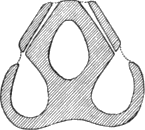 |
| Fig. 239. Double whistle, lost color ware—1/1. | Fig. 240. Section of double whistle. |
Reed shaped instruments are furnished with passages and orifices corresponding to the other forms. The chamber is tubular and the lower end is open, and the finger holes, when present, are on the upper side of the cylinder. One example without finger holes has two notes nearly an octave apart, which are produced, the higher with the tube open and the lower with it closed. Perhaps the most satisfactory instrument in the whole collection, so far as range is concerned, is shown in Fig. 241, and a section is given in Fig. 242. It is capable of yielding the notes indicated in the accompanying scale: First, a normal series of eight sounds, produced as shown in the diagram, and, 162 second, a series produced by blowing with greater force, one note two octaves above its radical and the others three octaves above. These notes are difficult to produce and hold and were probably not utilized by the native performer.
Fig. 241. Tubular instrument with two finger holes, alligator group—1/1.
Fig. 242. Section of whistle.

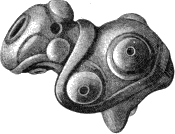 Fig. 243. |
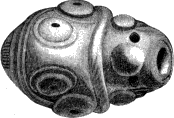 Fig. 244. |
| Small animal shaped whistle of blackish ware, with four finger holes—1/1. | |
Of a distinct type of form, although involving no new principle of construction, are two top-like or turnip shaped instruments, one of which is shown in Fig. 245. The form is symmetrical, the ornamentation tasteful, and the surface highly polished. The ware is of the alligator group and is decorated in red and black figures. A section is given in Fig. 246, a, and top and bottom views in b and c. By reference to these a clear conception of the object can be formed. The companion piece is identical in size, shape, and conformation, and, strange to say, in musical notes also. The tones are not fixed, 164 as each can be made to vary two or three degrees by changing the force of the breath. The tones produced by a breath of average force are indicated as nearly as may be in the accompanying scale. They will be found to occur nearer the lower than the upper limit of their ranges. It should be observed that the capacity for variation possessed by each of these notes enables the skilled performer to glide from one to the other without interruption. This instrument is, therefore, within its limited range, as capable of adjusting itself to any succession of intervals as is the trombone or the violin. I do not imagine, however, that the aboriginal performer made any systematic use of this power or that the instrument was purposely so constructed. It will be seen by reference to the scale that stopping the orifice in the end opposite the mouthpiece changes the notes half a tone, or perhaps, if accurately measured, a little less than that.
Fig. 245. Top shaped instrument, with three finger holes, alligator ware—1/1.
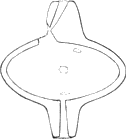 a |
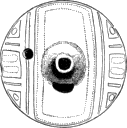 b |
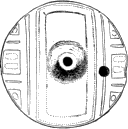 c |
| Fig. 246. Section and vertical views of instrument shown in Fig. 245. | ||

Our collection contains several dozen three note whistles or pipes. Most of these represent animal forms, which are treated in a more or less realistic way, but with a decided tendency toward the grotesque. Nearly all are of small size, the largest, an alligator form, having a length of about eight inches. In the animal figures the air chamber is within the body, but does not conform closely to the exterior shape. The mouthpieces and the orifices are variously placed, to suit the fancy of the modeler, but the construction and the powers are pretty uniform throughout. There are two finger holes, placed in some cases at equal and in others at unequal distances from the mouthpiece, but they are always of equal size and produce identical notes. The capacity is therefore three notes. The lower is produced when all the orifices are open, the higher when all are closed, and the middle when one hole—no matter which—is closed.
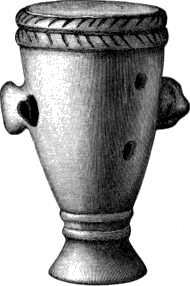 |
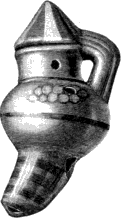 |
| Fig. 247. Drum shaped whistle of plain ware, with bird figure attached—1/1. | Fig. 248. Vase shaped whistle, lost color ware—½. |
One specimen is vase or pitcher shaped, with base prolonged for a mouthpiece and with a neat handle (Fig. 248). The ground color is a dull red, upon which are traces of painted figures. Its notes are as follows:
Fig. 249. Crab shaped whistle, alligator ware—1/1.
The largest specimen in the collection, shown in Fig. 250, represents an alligator and is finished in the usual conventional style of the alligator group. The air chamber is large and the sounds emitted are full and melodious and are lower in pitch than those of any other instrument in the collection. The cavity in the mouth and head is separated from the body chamber, and, with the addition of earthern pellets, probably served as a rattle. The mouthpiece is in the tail and the finger holes are in the sides of the body.
Fig. 250. Alligator shaped whistle, alligator ware—½.
167Mammals are very often reproduced in these instruments. What appears to be the ocelot or jaguar is the favorite subject. A representative specimen is shown in Fig. 251. The mouthpiece is in the tail and one of the sound holes is in the left shoulder and the other beneath the body. The head is turned to one side and the face is decidedly cat-like in expression. The decoration is in black and red and may be taken as a typical example of the conventional treatment of the markings of the bodies of such animals. The tips of the ears, feet, and tail are red. Rows of red strokes, alternating with black, extend in a broad stripe from the point of the nose to the base of the neck. Red panels, inclosing rows of red dots and enframed by black lines, cross the back. On the sides we have oblong spaces filled in with the conventional devices so common in other animal representations. The legs are striped and dotted after the usual manner.
Fig. 251. Cat shaped whistle, alligator ware—1/1.
Fig. 252. Whistle with four ocelot-like heads, alligator ware—1/1.
The prevalence of bird forms is due no doubt to the resemblance of the notes of primitive whistles to the notes of birds. The shape of the bird is also exceptionally convenient, as the body accommodates the air chamber, the tail serves as a mouthpiece, and the head is convenient for the attachment of a cord of suspension. A great variety of forms were modeled and range from the minute proportions of the smallest humming bird to those of a robin. The larger pieces represent birds of prey, such as hawks, eagles, and vultures, and the smaller are intended for parrots and song birds. The treatment is always highly conventional, yet in many cases the characteristic features of the species are forcibly presented. The painted devices have reference in most cases to the markings of the plumage, yet they partake of the geometric character of the designs used in ordinary vase painting. The ground is the usual yellowish gray of the slip, and nearly all the pieces belong to the lost color and alligator groups.
A characteristic example is illustrated in Fig. 253. The head is large and flat and the painted devices are in the red and black of the lost color group. The three notes are as follows:
169Fig. 253. Bird shaped whistle, with decoration in black, lost color ware—1/1.
The piece given in Fig. 254 has the shape and markings of a hawk or eagle. It belongs to the alligator ware and is elaborately finished 170 in semigeometric devices in red and black. All of these devices refer more or less definitely to the markings of the plumage.
Fig. 254. Bird shaped whistle, with conventional decoration in red and black, alligator ware—1/1.
The example shown in Fig. 255 represents a bird with two heads, the shape and markings of which suggest one of the smaller song birds.
Fig. 255. Two headed, bird shaped whistle, with conventional decoration in black, lost color ware—1/1.
I cannot say that the whistles were modeled and pitched with the idea of imitating the notes of particular birds, but it is possible for the practiced performer to reproduce the simpler songs and cries of birds with a good deal of accuracy.
Fig. 256. Whistle in grotesque life form, with decorations in black and red, alligator ware—⅔.
The human figure was occasionally utilized. The treatment, however, is extremely rude and conventional, the features having the 171 peculiar squirrel-like character shown in the figurines already given. The unique piece given in Fig. 256 represents a short, clumsy female figure with a squirrel face, carrying a vessel upon her back by means of a head strap, which is held in place by the hands. The mouthpiece of the whistle is in the right elbow and one sound hole is in the middle of the breast and the other in the left side. The costume and some of the details of anatomy are indicated by red and black lines in the original. Its notes are the same as those presented with Fig. 249.
LIFE FORMS IN VASE PAINTING.
This section is to be devoted to a short study of the decorative system of the ancient Chiriquians, and more especially to a consideration of the treatment of life forms in vase painting. Many of the finest examples of these designs, so far as execution and effect in embellishment are concerned, have already been given; but it is desirable now to select and arrange a series to illustrate origins and processes of growth or modification.
Elements of ornament flow into the ceramic art from a number of sources, but chiefly in two great currents: the one from art, and consisting chiefly of technical or mechanically produced phenomena, and hence geometric, and the other from nature, and carrying elements primarily delineative, and hence non-geometric. When once within the realm of decoration the various motives or elements are subject to modification by two classes of influences or conditioning forces: the technical restraints of the art and the esthetic forces of the human mind. Mechanical and geometric elements, although born within the art or its associated arts, are modified in the processes of adaptation to the changing requirements and conditions of the art and through the tendency towards elaboration under the guidance of the esthetic forces; left by themselves they remain, throughout all changes of use and modification of form, purely geometric. Imitative elements tend, under the same influences, to move in the direction of the unreal or geometric. In this way the realistic forms undergo marked changes, gradually assuming a geometric character and finally losing all semblance of nature.
Now it must be noted that the decorations of any group of art products may embody both classes of elements or they may be restricted rather closely to either. This fact enables us to account for many of the strongly marked distinctions observed in the decorative systems of different communities, races, and times. In a recent study of ancient Pueblo art I traced the decoration to a mechanical origin, mainly in the art of basketry, and thus accounted for its highly geometric character. Chiriquian art presents a strong contrast to this, as the great body of elements are manifestly derived from nature by delineative imitation. It was further observed in Pueblo art that as 172 time went on life forms were little by little introduced into its decoration and that in recent times they shared the honors equally with the primitive geometric forms. In Chiriquian art we find but meager traces of a primitive geometric system, and conclude that either the earliest art of the people did not give rise to such a system or that the graphic motives, entering gradually and steadily multiplying, supplanted the archaic forms, finally usurping nearly the entire field. As noticed in the preceding sections, there is always a certain amount of geometricity in the arrangement and the enframing of the designs, as well as a certain degree of convention in the treatment of even the most graphic motives; but these characters may be due to the restraining conditions of the art, rather than to the survival of original or ancestral features or characters.
In beginning the study of Chiriquian decorative art I found it impossible to approach the subject advantageously from the geometric side, as was done in the Pueblo study, since life elements so thoroughly permeate every part of it. I have, therefore, turned about, and in the following study present first the more realistic delineations of nature, arranging long series of derivative shapes which descend through increasing degrees of convention to purely geometric forms. These remarks relate wholly to the plan or linear arrangement of the motives.
As to method of realization, ceramic ornament may be arranged in two classes: the plastic or relieved and the non-plastic or flat. Life forms are freely rendered by both plastic and non-plastic methods, and in either style may range from the highly realistic to the purely geometric. As shown in a preceding section, plastic life forms in Chiriquian art appear to have been subject to two divergent lines of thought, the one trivial and the other serious. Through the one we have grotesque and perhaps even humorous representations of men and of animals. The figures are attached to the vessels for the purpose—perhaps for the exclusive purpose—of embellishment, and often with excellent success, as judged by our own standards of taste. The other deals with plastic representations apparently of a serious nature, although utilized also for embellishment. The animal forms employed are treated in a way to suggest that in the mind of the artist the creature bore a definite relation to the vessel or its use, a relationship originating in superstition and preserved throughout all changes of form. Their office was symbolic, and this office was probably not always lost sight of by the potter, even though, through the forces of convention, the animal shapes were reduced to mere knobs, ridges, or even to painted devices.
In color delineations, although the same subjects are to a great extent employed, there is necessarily greater constraint—there is less freedom as well as less vigor in the presentation of natural forms. There is apparently no attempt at the grotesque or amusing. The 173 variants are practically infinite. The work is more purely decorative and is perhaps less subject to the restraints of associated ideas and of use with particular vessels or in definite relations to other features of the vessel. At the same time it is manifest that these painted figures are not all merely meaningless decorations, but that many, throughout all degrees of modification, refer with greater or less clearness to natural originals, to ideas associated with these originals, or to the relationship of these originals to the vessel and its uses.
It is clear, however, that a considerable body of nature-derived elements, plastic and painted, are employed as simple embellishments, having no other function. This suggests the separation of all decorations into two grand divisions, based upon the kind of thoughts associated with them. These divisions may be designated as significant and non-significant, the term significant referring not to the mere identification of a device with an original form or to its office as an ornament, but to its symbolism, to its mystic relation with the vessel and its uses. But I have to do here with the forms taken by motives, with their morphology rather than with their signification, as the latter must, with reference to archæologic material, remain greatly speculative.
In the application of life forms in vase painting several classes of modifying and constraining agencies of a technical nature are present, and the following examples are grouped with the idea of defining these classes of forces and keeping them in a measure distinct.
Fig. 257. Graphic delineation of the alligator, from a vase of the lost color group.
Of all the animal forms utilized by the Chiriquians the alligator is the best suited to the purpose of this study, as it is presented most frequently and in the most varied forms. In Figs. 257 and 258 I reproduce drawings from the outer surface of a tripod bowl of the lost color group. Simple and formal as these figures are, the characteristic 174 features of the creature—the sinuous body, the strong jaws, the upturned snout, the feet, and the scales—are forcibly expressed. It is not to be assumed that these examples represent the best delineative skill of the Chiriquian artist. The native painter must have executed very much superior work upon the more usual delineating surfaces, such as bark and skins. The examples here shown have already experienced decided changes through the constraints of the ceramic art, but are the most graphic delineations preserved to us. They are free hand products, executed by mere decorators, perhaps by women, who were servile copyists of the forms employed by those skilled in sacred art.
Fig. 258. Graphic delineation of the alligator, from a vase of the lost color group.
A third illustration from the same group of ware, given in Fig. 259, shows, in some respects, a higher degree of convention. The scales are here represented by triangular dentals, which occupy the entire length of the back. These dentals are filled with the round dots that stand singly in the preceding cases.
Fig. 259. Conventional alligator, from the lost color ware.
175In another class of ware—the alligator group—the treatment is quite different, being decidedly more clumsy and realized by distinct processes; but prominence is given to a number of corresponding features. The strong curve of the back, the dentals and dots, and the muzzle and mouth refer apparently to the same creature. The curiously marked panel in the body of the last example is a unique feature, which appears, however, in a few other cases.
Fig. 260. Style of convention in the alligator group of ware.
These drawings occur upon the sides of vases, alternating with the plastic features, and are perhaps generally associated with such features in the expression of some mythical idea.
Fig. 261. Style of convention in the alligator group of ware.
The modeled creature is often represented with two heads instead of with a head and a tail, and the painted forms, in many cases, exhibit the same peculiarity as shown in Fig. 262. I surmise that the employment of two heads arises from the need of securing perfect balance of parts rather than as an original product of the imagination.
Fig. 262. Two headed form of the alligator.
It will be interesting, as additional examples are presented, to note the effect of modification upon particular features of the animal, to observe how some come into prominence, representing the creature and the idea, while others fall into disuse and disappear. In nature the line of the body is perhaps the most strongly characteristic feature, and it is in art the most persistent. It survives in the stems of many conventional devices from which all other suggestions of the animal have vanished.
Fig. 263. Figure of the alligator much simplified.
The following examples depart still further from nature, approaching the border line between the distinctly imitative and the purely conventional or geometric phases. In the first (Fig. 263) all the leading features are recognizable, but are very much simplified. The 176 jaws are without teeth, the head is without eyes, and the body without indication of scales. The other example (Fig. 264) is of a somewhat different type and may possibly refer to some other reptilian form, but many links connecting the two are found. The shape is more angular and is a step further removed from nature. From shapes as conventional as this we drop readily into purely geometric forms, as will be seen further on. These and the preceding drawings are all executed on broad surfaces, where fancy could have free play. The modifying or conventionalizing forces are, therefore, quite vague. Variation from natural forms is due partly to a lack of skill on the part of the painter, partly to the peculiar demands of ceramic embellishment, and partly to the traditional style of treatment acquired in still more primitive stages of culture and in other and unidentified branches of art.
Fig. 264. The alligator much modified by ceramic influences.
 Fig. 265. |
 Fig. 266. |
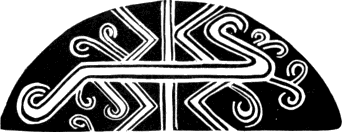 Fig. 267. |
|
| Illustrations of the influence of the shape of spaces upon the delineation of animal forms. | |
I shall now call attention to some important individualized or well defined agencies of convention. First, and most potent, may be mentioned the enforced limits of the spaces to be decorated, which spaces take shape independently of the subject to be inserted. When the figures must occupy a narrow zone they are elongated, when they must occupy a square they are restricted longitudinally, and when they must occupy a circle they are of necessity coiled up. Fig. 265 177 illustrates the effect produced by crowding the oblong figure into a short rectangular space. The head is turned back over the body and the tail is thrown down along the side of the space. In Fig. 266 the figure occupies a circle, and is in consequence closely coiled up, giving the effect of a serpent rather than an alligator. In Fig. 267 the space is semicircular, and we observe peculiar conventional conditions, some of which may be due to other causes. For example, such spaces may originally have been filled with purely geometric figures, which tended to impart their own characters to the life forms that supplanted them.
Fig. 268. Delineation retaining but slight traces of the life form.
Fig. 269. Delineation retaining but slight traces of the life form.
Fig. 270. Delineation retaining but slight traces of the life form.
Now, it often happens that, as in the last example given, the animal form, literally rendered, does not fill the panels satisfactorily. The head and the tail do not correspond and there is a lack of balance. In such cases two heads have been preferred. The body is given a uniform double curve and the heads are turned down, as shown in Figs. 268 and 269, or one may turn up and the other down, as seen in Fig. 270. The two headed form may also arise from imitation of plastic forms, as I have already shown. The example given 178 in Fig. 268 is extremely interesting on account of its complexity and the novel treatment of the various features. The two feet are placed close together near the middle of the curved body, and on either side of these are the under jaws turned back and armed with dental projections for teeth. The characteristic scale symbols occur at intervals along the back; and very curiously at one place, where there is scant room, simple dots are employed, showing the identity of these two characters. Some curious auxiliary devices, the origin of which is obscure, are used to fill in marginal spaces. The shape given in Fig. 269 is so highly modified that it is not recognizable as an animal form, excepting through a series of links connecting it with more realistic delineations. It is perfectly symmetrical and consists of a compound curve for the body, with hooks at the extremities and two appended hooks for legs. The spots symbolizing the scales are here placed within the body, showing another step toward complete annihilation of the natural forms and relations. Three additional examples, showing still higher degrees of convention, are presented in Figs. 271, 272, and 273. The series could be filled up and continued indefinitely, connecting the whole family of devices in which dentals, hooks, spots, and circles occur with the alligator radical or with other reptilian forms confused with the alligator through the carelessness or ignorance of the decorator.
Fig. 271. Highly conventionalized alligator derivative.
 |
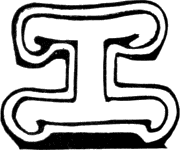 |
| Fig. 272. Highly conventionalized alligator derivative. | Fig. 273. Highly conventionalized alligator derivative. |
In looking over a large series of the vases it will be seen that the tendency of decoration is toward the zonal arrangement, the spaces 179 being narrow and long, even when divided into the usual number of panels. As a consequence the motives tend to take linear forms. Parts are repeated or greatly drawn out to fill the spaces. This phase of conventional evolution may be illustrated by a multitude of examples.
 a |
b |
c |
d |
e |
f |
| Fig. 274. Series of forms showing modification through use in narrow zones. | |
Beginning with an ordinary form in Fig. 274, a, we advance under the restraint of parallel border lines through the series, ending in a simple meander, f, the spaces about which are, however, filled out with the conventional scale symbols, the triangles inclosing dots. Thus we witness the transformation of the life form into a linear device, in which the flexures of the body are emphasized and multiplied without reference to nature, and there is little doubt that the series continues further, ending with simple curved lines and even with straight lines unaccompanied by auxiliary devices.
Fig. 275. Running ornaments composed of life elements.
Next to the body line the most important of the alligator derivatives is the notched or dotted hook, which in the lost color group stands sometimes for the whole creature, but more frequently for one or more of the members of its body, the snout, the tail, or the feet. It is employed singly or in various arrangements suited to the shape of the spaces to be filled or occurs in connection with the body line or stem, where, by systematic repetition, it serves to fill the triangular interspaces. Take, for example, an ornament (Fig. 275) which encircles the shoulder of a handsome vase of the 180 lost color group. The space is neatly filled with groupings in which the simple life coil elements are joined one to another in such a way as to give somewhat the effect of an ordinary running ornament. The same motive takes a different form in Fig. 276, which is part of the decorated zone of an earthen drum (see Fig. 235). Here the body of the creature is represented by a wide meandered line, and to this the notched or scalloped hooks are attached with perfect regularity, one to each angle of the meandered body. In other examples the angular geometric character extends to every part of the detail and the curved hooks lose their last suggestion of nature and are entirely dropped or used separately.
Fig. 276. Running ornaments composed of life motives.
The rings, strokes, spots, and dentate figures that serve to represent the markings and scales of the reptile are among the most important of the derivative devices and occur in varied relations to other classes of derivatives. They also occur independently, either singly or in groupings. Thus we see that the alligator, in Chiriquian vase painting, is represented by an endless list of devices, and it is interesting to note that among these are several figures familiar to the civilized world in both symbolism and ornament.
| a |
b |
c |
d |
| Fig. 277. Series of derivatives of the alligator showing stages of simplification. | |||
I present five series of figures designed to illustrate the stages through which life forms pass in descending from the realistic to highly specialized conventional shapes. In the first series (Fig. 277), we begin with a meager but graphic sketch of the alligator; the second figure is hardly less characteristic, but is much simplified; in the third we have still three leading features of the creature: the body line, the spots, and the stroke at the back of the head; and in the fourth nothing remains but a compound, yoke-like curve, standing for the body of the creature, and a single dot.
Fig. 278. Series showing stages in the simplification of animal characters.
The figures of the second series (Fig. 278) are nearly all painted upon low round nodes placed about the body of the alligator vases and hence are inclosed in circles (see Fig. 197). The animal figure 181 in the first example is coiled up like a serpent, but still preserves some of the well known characters of the alligator. In the second example we have a double hook near the center of the space which takes the place of the body, but the dotted triangles are placed separately against the encircling line. In the next figure the body symbol is omitted and the three triangles remain to represent the animal. In the fourth there are four triangles, and the body device, being restored in red, takes the form of a cross. In the fifth two of the inclosing triangles are omitted and the idea is preserved by the simple dots. In the sixth the dots are placed within the bars of the cross, the triangles becoming mere interspaces; and in the seventh the dots form a line between the two encircling lines. This series could be filled up by other examples, thus showing by what infinitesimal steps the transformations take place. The round nodes upon which these medallion-like figures are drawn are survivals of the heads or other parts of animals originally modeled in the round, but in the processes of manufacture partially or wholly atrophied. It was sought to preserve the idea of the creature by the use of painted details, but these, as we have seen, were also in time reduced to formal marks, symbols doubtless in many cases of the conception to which the original plastic form referred.
| a |
 b |
 c |
d |
| Fig. 279. The scroll and fret derived from the body line of the alligator. | |
 a |
 b |
 c |
d |
| Fig. 280. Devices derived from drawings of parts of the life form. | |
The derivation of the fret and scroll—most admired of the decorative motives of numerous races—has been a fruitful source of discussion. The vase painting of Chiriqui serves to throw new light upon the subject. We learn by the series of steps illustrated in the annexed cuts that the alligator radical, under peculiar restraints and influences, assumes conventional forms that merge imperceptibly into these classic devices. In the third series given (Fig. 279) the first figure is far removed from the realistic stage of representation, but it is one of the ordinary conventional guises of the alligator. Other still more conventional forms are seen in the three succeeding figures, the last of which is a typical rectangular fret link known and used by most nations of moderate culture. The derivatives in nearly all 182 the preceding figures can be traced back to the body of the creature as a root, but there are many examples which seem to have come from the delineation of a part of the creature, as the head, foot, eye, or scales—abbreviated representatives of the whole creature. Such parts, assuming the role of radicals, pass also through a series of modifications, ending in purely geometric devices in the manner indicated in the following or fourth series of examples (Fig. 280). In the first cut we have what appears to be the leg and foot of the favorite reptile, and following this are other forms that seem to refer to the same feature. Additional examples are shown in Figs. 281 and 282, which, while they doubtless arose more or less directly from the life form, are not so readily traceable through less conventional antecedents. The first forms part of the incised ornament of a small vase or needlecase and the second is a section of the zonal ornament of the tripod cup illustrated in Fig. 203, by reference to which it will be seen that the zone of devices serves to connect the head and the tail of the reptile, which are modeled as a part of the vase; the devices 183 therefore represent the markings of the creature’s body, although they may originally have been derived from the figure of the whole or a part of the animal rather than from the markings of the skin. In other examples still more highly conventional figures are found to hold the same relation to the plastic representation of the extremities of the creature. They include the meander, the scroll, the fret, and the guilloche. We find that in the stone metates of many parts of Central America, nearly all of which are carved to imitate the puma, the head and tail of the creature are connected by bands of similar devices that encircle the margin of the mealing plate (see Fig. 9). The alligator form is therefore not necessarily the originator of all such devices. It is probable that any animal form extensively used by such lovers of decoration as the ancient inhabitants of Central America would be found thus interwoven with decoration. These considerations will serve to widen our views upon the origin and development of especial devices. As it now stands we are absolutely certain that no race, no art, no motive or element in nature or in art can claim the exclusive origination of any one of the well known or standard conventional devices, and that any race, art, or individual motive is capable of giving rise to any and to all such devices. Nothing can be more absurd than to suppose that the signification or symbolism attaching to a given form is uniform the world over, as the ideas associated with each must vary with the channels through which they were developed.
| |
|
| Fig. 281. Devices incised in a needlecase. | Fig. 282. Devices representing the markings of a reptile’s body. |
Other classes of geometric figures, derived chiefly from scale or skin markings, are given in the fifth series. In more realistic phases of representation the dentate and dotted devices are ranged along the body of the creature, as in nature, but as convention progresses they are used independently to fill up spaces, to form the septa of panels, &c. Many illustrations appear in the preceding pages and additional examples are given in Fig. 283. It is possible that these devices come from delineations of a number of distinct animal forms; but in the higher stages of convention confusion cannot be avoided, and must have existed to some extent in the mind of the decorator; they serve, however, to illustrate the stages of simplification through which all forms extensively used for a long period must pass. The laws of derivation, modification, and application in art are the same in all.
| a |
b |
c |
|||
d |
e |
f |
g |
||
| Fig. 283. Conventional figures derived from the markings of the bodies of animals. | |||||
It has now been shown that life forms and their varied derivatives constitute the great body of Chiriquian decorative motives; that when first introduced the delineations are more or less realistic, according to the skill of the artist or the demands of the art; but that in time, by a long series of abbreviations and alterations, they descend to simple geometric forms in which all visible connection with the originals is lost. The agencies through which this result is accomplished are chiefly the mechanical restraints of the art acting independently of voluntary modification and without direct exercise of esthetic desire.
There may be forces at work of which we find no clear indications. Some of the conventional forms into which life forms are found to grade may be survivals of forms originating in other regions and belonging to other cultures which have through accidents of contact imposed themselves upon Chiriquian art; such are the scroll, the fret, and the guilloche; but the thorough manner in which such forms are interwoven with purely Chiriquian conceptions makes it impossible to substantiate such a theory. The conclusion most easily and most naturally reached is that all are probably indigenous to Chiriqui, and hence the striking deduction that the processes of modification inherent in the art are of such a nature that any animal form extensively used in decoration may give rise to any or all of the highly conventional forms of ornament.
During the progress of this study a question has frequently been raised as to the extent to which the memory of the creature original or of its symbolism in first use was kept alive in the mind of the decorator. It is a well established fact that primitive peoples habitually invest inanimate objects with the attributes of living creatures. Thus the vessel, from the time it assumes individual shape and is fitted to perform a function, is thought of as a living being, and by the addition of plastic or painted details it becomes a particular creature, an alligator, a fish, or a puma, each of which is in most cases the symbol of some mythologic concept. When, through the changes of convention in infinite repetition, all resemblance to individual creatures was lost and mere knobs or simple geometric figures occupied the surface of the vessel, there is little doubt that many of these features still recalled to the mind of the potter the ultimate originals and the conceptions of which they were the representatives, and that others represented ideas, the outgrowth of or a development from primary ideas, while still others had acquired entirely new ideas from without. It cannot be denied, however, that there does come a time in the history of vase painting at which such associated ideas become vague and are lost and elements formerly significant are added and combinations of them are made for embellishment alone, without reference to meaning or appropriateness; but I am inclined to place this period a very long way from the initiatory stages of the art. It 185 may not be possible to find evidence of the arrival of this period, as it is not necessarily marked by any loss of unity or consistency—striking characteristics of ancient American art; for such is the conservatism of indigenous methods that, unless there be forcible intrusion of exotic art, original forms and groupings may be perpetuated indefinitely and remain much the same in appearance after the associated ideas are modified or lost.
Fig. 284. Vase with decorated zone containing remarkable devices—⅓.
Fig. 285. Series of twelve conventional devices from the decorated zone of a vase.
In our study of the forms and meanings of these devices it should not be forgotten that collateral branches of art are also simultaneously employing the same motives and reducing them through other similar classes of conventionalizing forces to corresponding forms. Recording arts—pictography, hieroglyphic and phonetic writing—carry life forms through all degrees of abbreviation and change, and all ceremonial and all domestic arts with which such forms are associated do the same; and it is not impossible that many conventional forms found upon pottery are borrowed outright from the other arts. It will be impossible to detect these borrowed elements unless very literally transferred from some art the style of which is well known. It would be comparatively easy to identify literal borrowings from phonetic art or even from hieroglyphic art, as the form and arrangement of the devices are quite unlike those observed in pure decoration. We do not know that Chiriquian culture had achieved a hieroglyphic or a phonetic system of writing, but it is worth while to call attention to the form and the manner of employment of some of the devices found upon the pottery. In Fig. 284 I present an outline drawing of a vase, the shoulder of which is encircled by a broad zone of decoration. This zone is divided into panels by oblique lines. A row of rectangular compartments extends along the middle of the band and rows of triangular spaces occur at the sides. Each space is 186 occupied by a device having one or more features suggesting a pictorial original and doubtless derived from one. In the main row there are twelve figures, no two of which are identical. Although we are unable to show that any of these characters had other than a purely decorative use, we see how richly the ancient peoples were supplied, through the conventionalizing agencies of the art, with devices that could have been employed as ideograms and letters where such were needed, and devices, too, that, from their derivation and use in the art, must in most cases have had ideas associated with them.
RÉSUMÉ.
A brief summary of the more salient points of interest dwelt upon in this paper may very appropriately be given in this place. We find that a limited area—a small and obscure province of the isthmian region—possesses a wonderful wealth of art products the character of which indicates a long period of occupation by peoples of considerable culture. The art remains are perhaps as a whole inferior to those of the districts to the north and south, but they possess many features in common with the art of neighboring provinces. There is, however, at the same time, a well marked individuality. In conception and execution these works are purely aboriginal, and, so far as can be determined by the data at hand, are pre-Columbian, and possibly to a great extent remotely pre-Columbian. The discovery of articles of bronze, which metal we cannot prove to be of indigenous production, is the only internal evidence pointing toward the continuance of the ancient epoch of culture into post-Columbian times. The relics are obtained from tombs from which nearly all traces of human remains have disappeared.
Art in stone covers the ground usually occupied by works in this material in other Central American countries, save in the matter of architecture, of which art there are but meager traces. There are rock inscriptions, statuettes and statues of rather rude character, shapely mealing stones, elaborately carved seats or stools, many celts of extremely neat workmanship, spear and arrow points of unique shape, and a very few beads and pendent ornaments. There are apparently no traces of implements of war.
In metal there are numerous and somewhat remarkable works. They are of gold, gold-copper alloy, copper, and bronze. The objects are of small size, rarely reaching a pound in weight, and they are almost exclusively pendent ornaments. They were, for the most part, cast in molds, and in nine cases out of ten represent animal forms. A few bells are found, all of which are of bronze. Pieces formed of alloyed metal are usually washed or plated with pure gold.
The great body of relics are in clay, and the workmanship displayed is often admirable. Vases are found in great numbers, and 187 as a rule are small and shapely, and are so carefully and elaborately decorated as to lead to the inference that their office was in a great measure ceremonial. They take a high place among American fictile products for grace of form and beauty of decoration. There is neither glaze nor evidence of the use of a wheel. Besides vases we have several other classes of objects, which include grotesque, toy-like statuettes, small, covered receptacles resembling needlecases, seat-like objects elaborately modeled, spindle whorls, and musical instruments. The occurrence of numerous specimens of the two latter classes indicates that the arts of weaving and music were assiduously practiced.
An examination of the esthetic features of the ceramic art has proved exceptionally instructive. We find much that is worthy of attention in the forms of vases as well as in the plastic or relieved features of embellishment, and a still richer field is opened by the study of the incised and painted—the flat—decorations.
I have shown that the elements of decoration flow into the ceramic art chiefly through two channels, the one from art and the other from nature. Elements from art are mainly of mechanical origin, and are, therefore, non-imitative and geometric. Elements from nature imitate natural forms, and hence are primarily non-geometric. Elements from art, being mechanical, are meaningless or non-ideographic; those from nature are in early stages of art usually associated with mythologic conceptions, and hence are ideographic. All decorations may therefore have four dual classifications, as follows: First, with reference to method of realization, as plastic and flat; second, with reference to derivation, as mechanical and imitative; third, with reference to plan of manifestation, as geometric and non-geometric; and, fourth, with reference to the association of ideas, as significant and non-significant.
I have found that the ceramic art, having acquired the various elements of ornament, carries them by methods of its own through many strange mutations of form. The effect upon life forms is of paramount importance, as is indicated by the following broad and striking generalization: The agencies of modification inherent in the art in its practice are such that any particular animal form extensively employed in decoration is capable of changing into or giving rise to any or to all of the highly conventional decorative devices upon which our leading ornaments, such as the meander, the scroll, the fret, the chevron, and the guilloche, are based. It is further seen, however, that ideographic elements are not necessarily restricted to decorative or symbolic functions, for the processes of simplification reduce them to forms well suited to employment in hieroglyphic and even in phonetic systems of expression. Such systems are probably made up to a great extent of characters the conformation of which is due to the unthinking—the mechanical—agencies of the various arts.
Footnotes
1. For physical features, see report of Lieutenant Norton (Report Chiriqui Commission, Ex. Doc. 41, 1860).
2. J. King Merritt: “Report on the huacals or ancient graveyards of Chiriqui.” Bulletin of the American Ethnological Society, 1860.
3. Bollaert: Antiquarian Researches in New Granada. London, 1860.
4. A. De Zeltner: Notes sur les sépultures indiennes de département de Chiriqui.
5. R. B. White: Jour. Anthrop. Inst. Great Britain and Ireland, p. 241. February, 1884.
6. J. King Merritt: Paper read before the American Ethnological Society, 1860.
7. B. B. White: Jour. Anthrop. Inst. Great Britain and Ireland, p. 246. February, 1884.
8. I am indebted to Mr. J. S. Diller, of the United States Geological Survey, for the determination of the species of stone in this series of objects.
9. Seemann: Voy. Herald, Vol. I, p. 312.
10. A. de Zeltner: Notes sur les sépultures indiennes du département de Chiriqui.
11. Seemann: Voy. Herald, Vol. I, p. 313.
12. Cullen’s Darien, p. 38.
13. A. De Zeltner: Notes sur les sépultures indiennes, p. 7.
14. Herrera: Hist. America, Vol. VI, p. 369.
15. Herrera: Hist. America, Vol. III, p. 287.
16. Mr. Hawes’s letter answering questions about Chiriqui, read by Mr. Davis before the American Ethnological Society, April 17, 1860.
17. Nadaillac: Prehistoric America, p. 450.
18. Bollaert: Ethnological and Other Researches in New Granada, &c.
19. Bollaert: Antiquarian Researches in New Granada, plate facing p. 31.
20. A. De Zeltner: Notes sur les sépultures indiennes du département de Chiriqui.
INDEX.
Alligator, utilization of, in Chiriquian art 130-140, 166, 173-176, 178, 80, 183
Arrowpoints and spearheads of Chiriqui 34
Balboa, ornaments captured by 35
Black incised group of Chiriquian pottery 80
Castillo del Oro, name given by Columbus to Chiriqui 35
Celts, collection of, from Chiriqui 29-34
Costa Rica, origin of name of 35
Darien, capture of, by Balboa 35
De Zeltner, A. See Zeltner, A. de.
Diller, J. S., acknowledgment to 21, note
Drums of ancient Chiriqui 157, 160
El Dorado, origin of 35
Figurines of Chiriquian art 151-153
Hallock, W., on Chiriquian methods of casting 38
Handled group of Chiriquian pottery 90-97
Herrera, cited 35
Huacals, exploration of, in Chiriqui 16, 17
Kunz, G. F., on use of insects as models in casting metals 38
on Chiriquian methods of plating 39
“Lost color” of Chiriquian art, nature of 86
Lost color group of Chiriquian pottery 113-130
McNiel, J. A., archeologic work of, in Chiriqui 14, 15, 20
McNiel, J. A., cited 17, 22, 23, 27, 31, 40, 41, 43, 46, 107
Maroon group of Chiriquian pottery 107-109
Mealing stones of Chiriqui 25-27
Merritt, J. K., cited 14, 16, 49
exploration of Bugaba cemetery by 17, 18, 20
Metates of Chiriqui, nature and use of 25-27
Nadaillac, Marquis, cited 14, 38
on Chiriquian methods of casting 38
Needlecases (?) of Chiriqui 150
New Granada, burial customs in 19, 20
Otis, F. M., paper on Panama ornaments by, mentioned 46
Piedra pintal, description of, by Seemann 21, 22
Pinart, A. L., cited 14, 15, 20, 22
Polychrome group of Chiriquian pottery 140-147
Rattles of ancient Chiriqui 156, 157
Red line group of Chiriquian pottery 109-111
Riggs, R. B., analyses by 49
Scarified group of Chiriquian pottery 87-90
Seemann, description of piedra pintal by 21, 22
Spindle whorls of Chiriqui 149, 150
Stearns, J. B., specimens in archeological collections of 24, 41, 43, 45, 48, 49
Stools of ancient Chiriqui 154-156
Terra cotta group of Chiriquian pottery 67
Tripod group of Chiriquian pottery 97-107
Whistles of ancient Chiriqui 164-171
White, B. B., description of cemetery in New Granada by 19
White line group of Chiriquian pottery 111-113
Wind instruments of ancient Chiriqui 160-171
Zeltner, A. de, observations on graves in Chiriqui by 14, 18, 19, 41, 42
Inconsistencies between Table of Contents and Body Text:
Peoples
body text has “People”
Celts &c.
body text has “Celts” alone
Clay: Pottery
body text has “Pottery” alone
Clay: Miscellaneous objects
body text has “Miscellaneous Objects of Clay”
Résumé
indented as if secondary to previous entry
In the body text, the items “Spearheads” and “Needlecases” are written with parenthetical question mark (?).
Under “Clay”, all sections listed in the Table of Contents as “Terra cotta group”, “Scarified group”... are shown in the body text as “The terra cotta group”, “The scarified group”...















